
Admin
-
Posts
7,474 -
Joined
-
Last visited
Content Type
Profiles
Forums
Events
Store
Gallery
Community Map
Posts posted by Admin
-
-
Hello Hedgemonkey,
Welcome to The Motorbike Forum. Please feel free to browse around and get to know the others. If you have any questions please don't hesitate to ask.
Why not tell us a bit about yourself too.
-
-
Hello Haggis,
Welcome to The Motorbike Forum. Please feel free to browse around and get to know the others. If you have any questions please don't hesitate to ask.
Why not tell us a bit about yourself too.
-
Hello CliffordG,
Welcome to The Motorbike Forum. Please feel free to browse around and get to know the others. If you have any questions please don't hesitate to ask.
Why not tell us a bit about yourself too.
-
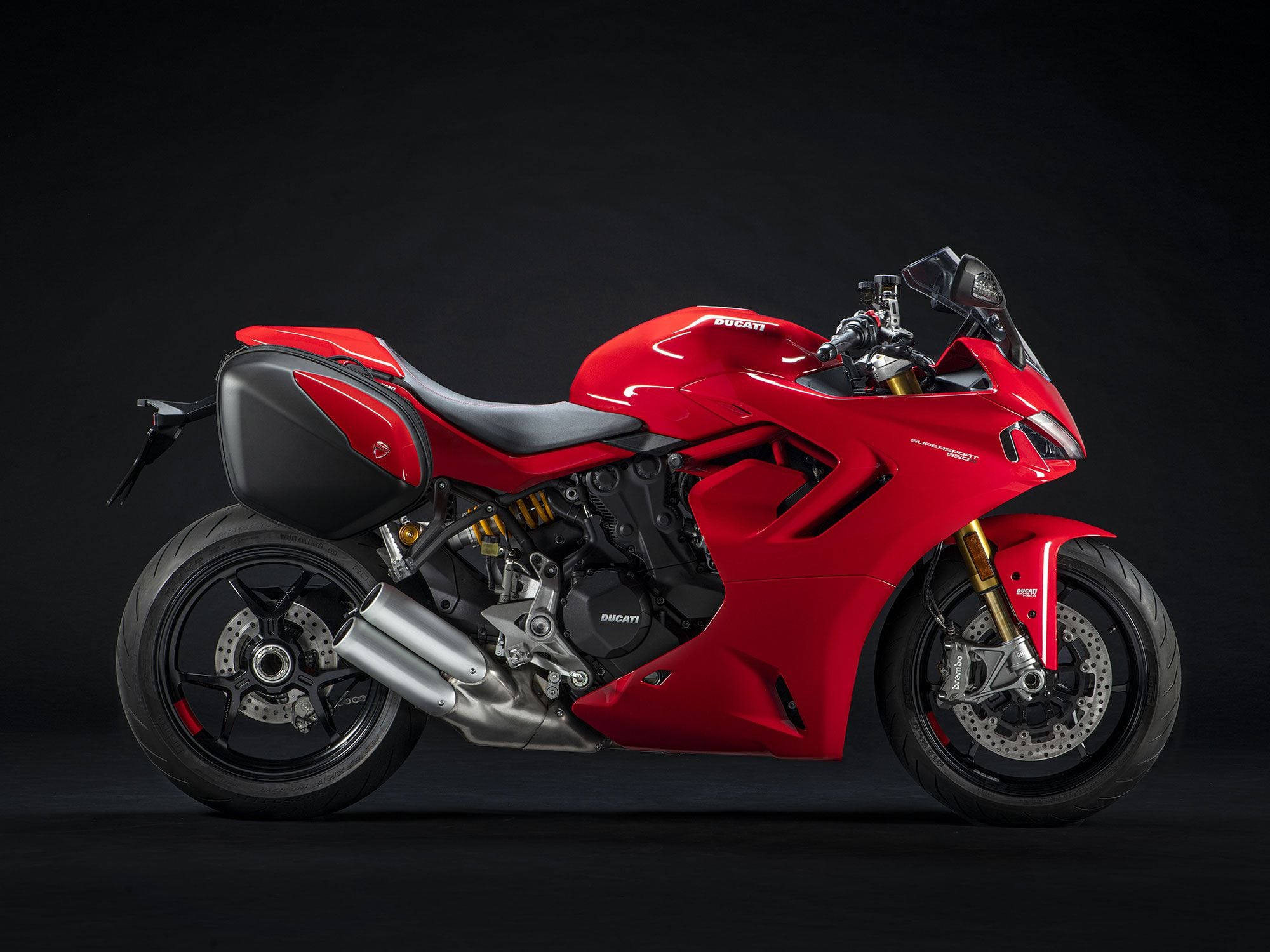
As the Ducati 950 SuperSport enters production, our Italian correspondent Bruno dePrato takes a look back at the past five decades of the SuperSport. (Ducati/)The new Ducati SuperSport 950 was revealed last November and analyzed here by Seth Richards. Now Ducati has announced that the bike will enter production and is scheduled to go on sale next spring. This is the latest in a lineage of SuperSport Ducati models that runs back to the end of the ’80s, keeping in mind that the mythical Ducati 750 that won the 1972 Imola 200 was based on the first edition of the Ducati “bevel gear” 750 SS.
These models remained in production until the mid-1980s, and were the basis for the limited-edition Mike Hailwood Replica, a model inspired by the bike on which Hailwood won the 1978 Isle of Man Tourist Trophy and with it the TT Class world title.
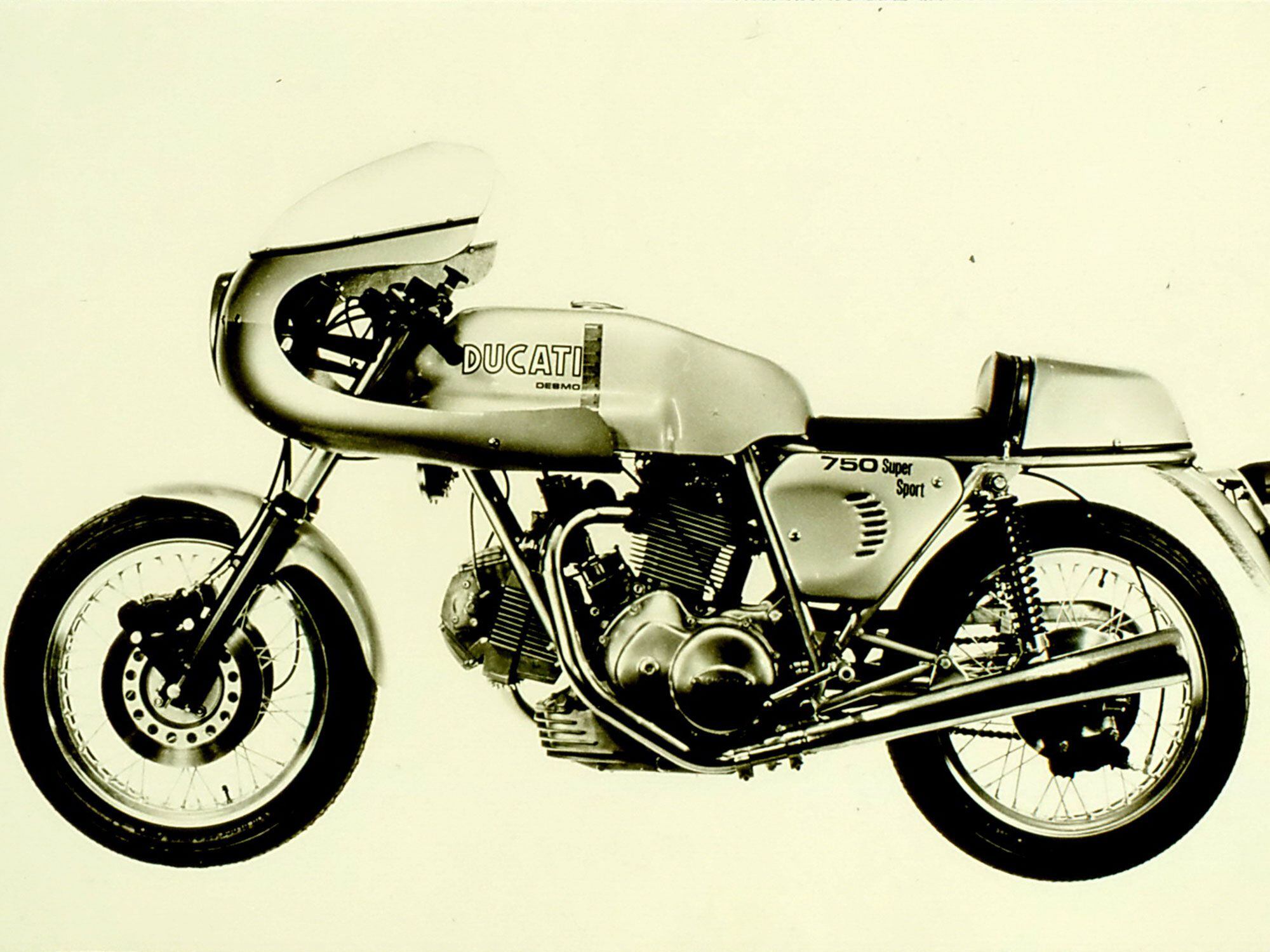
Paul Smart’s 1972 Imola-winning race machine was based on the 750 SS. (Ducati/)The second-generation Ducati SuperSports were no longer Ducati’s top sport models, coming as they did after the mighty 851 four-valve desmo had gone into production. They were intended to be entry models, an introduction to Ducati magic. That proved to be very smart marketing.
The first Ducati SuperSport 900 model was a huge success largely because Ducati technicians worked quickly to correct the company’s weak first attempt, the 1988 750 Sport, based on the old 750 F1 rolling gear and the Paso 750 power unit. In the very first edition, the chassis was somewhat flex prone due to the rear swingarm structure and the inconsistent quality of its early generation 16-inch radials, and its centrally located Weber twin barrel carburetor didn’t breathe as well at low speeds compared to its installation in the Paso.
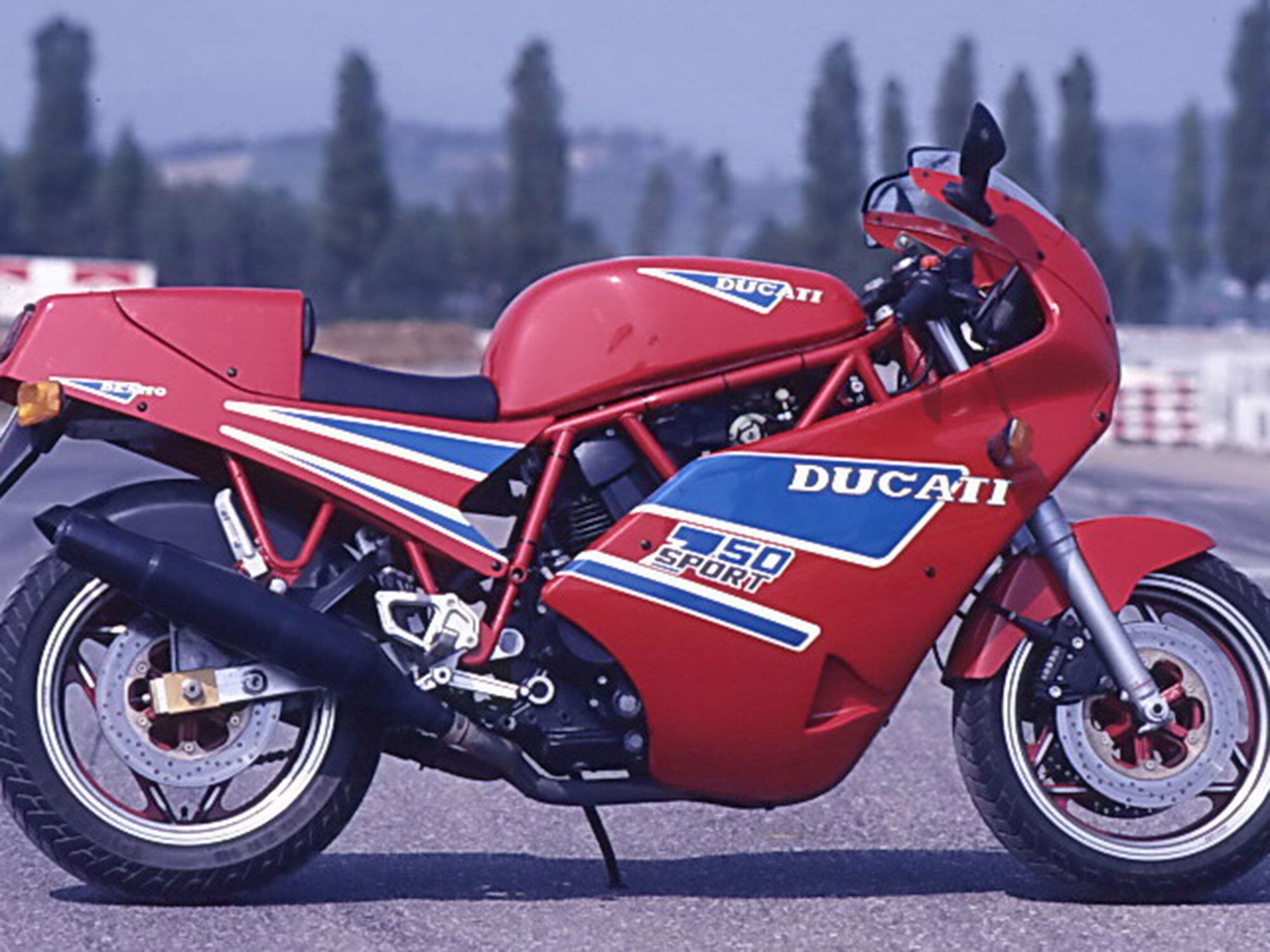
The 750 SuperSport was a weak attempt, but the following 900 SuperSport promptly corrected many of the issues. (Bruno dePrato Collection/)Ducati’s technical team promptly went to work fixing the chassis and installing a new 904cc power unit, giving life to the first 900 SuperSport. The heart of both the old and new bikes was derived from the air-cooled Pantah 500cc SOHC 2-valve desmo designed by Ducati stalwart Dr. Fabio Taglioni. The 904cc version’s 92mm bore and 68mm stroke were housed in a heftier crankcase based on the 851 four-valve desmo’s. This allowed the 900 SuperSport to use Ducati’s new six-speed gearbox. The 904cc engine also received a more effective air-/oil-cooling system that further improved the general efficiency of the 80 hp unit, as improved cooling led to smoother response from the Weber DCOE carburetor.
The 900 SuperSport featured a nicely designed steel-tube trellis frame that set the style for all the units that followed. It shared its 1,450-millimeter/57.0-inch dimensions with the Paso, but not that model’s advanced front end geometry, which at 25 degrees incorporated a steeper steering axis rake. Ducati’s technical team was still strongly tied to their old-style steering geometries, and consequently the 900 SuperSport featured a heavier 28-degree rake angle. The 900 SuperSport was lean, relatively light, and represented an attractive value for the money given its price to performance ratio.
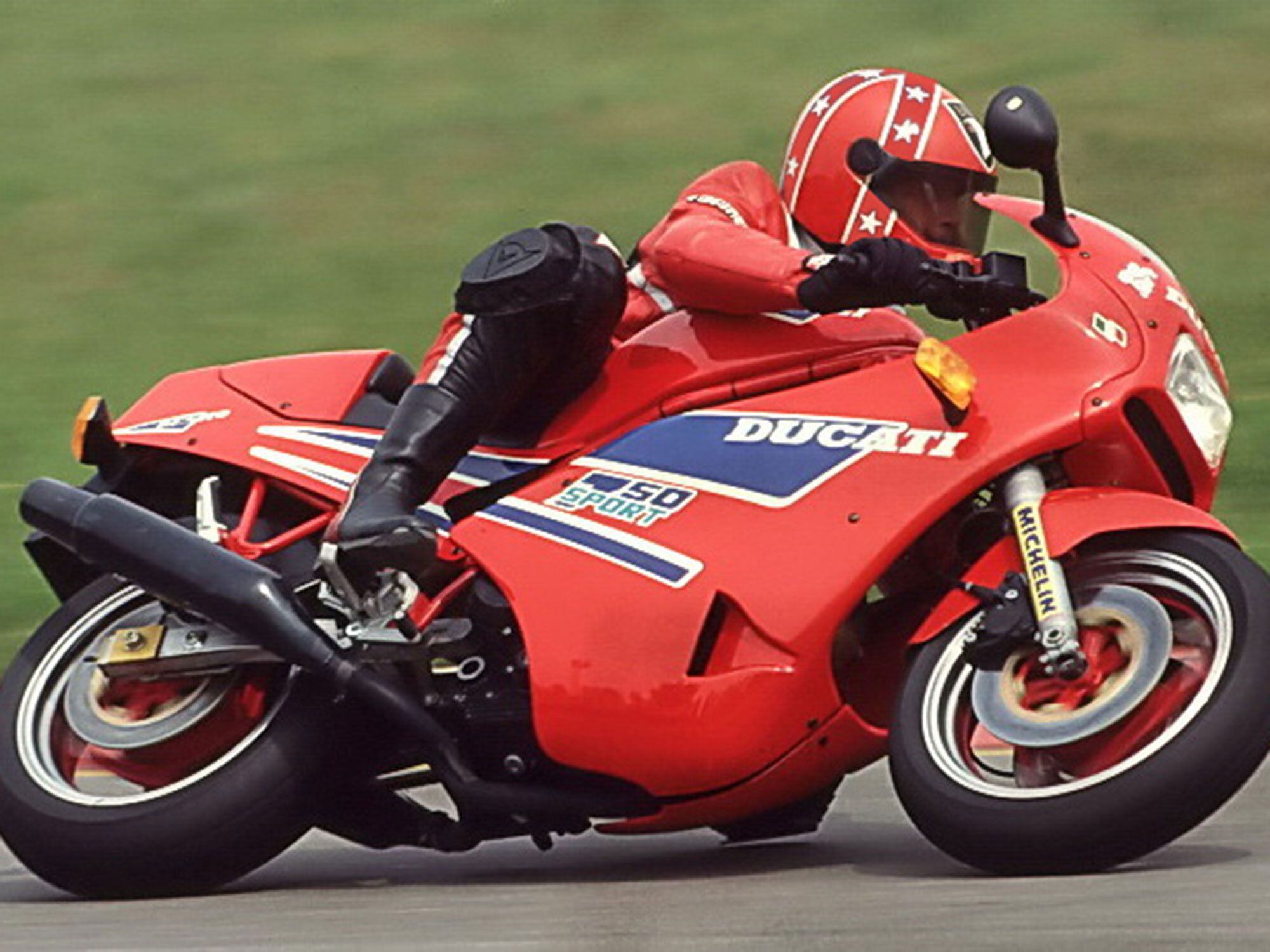
The 1989 750 SuperSport on the track. (Bruno dePrato Collection/)In 1992 Ducati created the 900 SuperSport Superlight by paring the 900SS down to a net 397 pounds. I had multiple opportunities to test the 900 SuperSport; I loved the semi-dressed version better than the fully faired one. The half-fairing left the bike’s mechanical beauty open to appreciation, and in a Ducati, that is a positive factor. The engine was strong, with plenty of torque from below 4,000 rpm to a 60 pound-feet peak at 6,500 rpm, and thundering runs up to 8,000 rpm, 500 rpm past peak power, were easily done. The engine and the light weight combined for very pleasant performance, not extremely aggressive but very solid.
I liked the steering response much less. I never loved the old-style Ducati steering geometry championed by Ducati engineer Franco Farné, who was a great engine technician and superb tuner but not a chassis specialist. Yet Farné had a strong influence on the design of Ducati frames. Perhaps only Maestro Massimo Tamburini designed Ducati frames combining advanced geometry and perfect weight distribution. Typical Ducati chassis geometry induced the front end to go wide, and I never liked fighting this characteristic. Yet the light weight and the ergonomically very inviting riding posture made the problem much less relevant at the track, where the SuperSport proved smartly responsive and stable around fast corners.
That made the first-generation 900 SuperSport highly appreciated by the public, soon becoming a pillar of Ducati’s growing success on the market. At the peak of their popularity, the 750 and 900 SuperSport models accounted for more than 10,000 sales per year. The impressive success of the Ducati 851 four-valve desmo in the SBK series boosted the image of the 900 SuperSport, itself a bike of high quality in every detail, featuring top-quality components such as Brembo’s Gold braking system and latest-generation Marzocchi suspension.
A further touch of refinement was added to the limited-edition 900 SuperSport Superlight version, which featured a vented dry clutch cover, lightweight Marvic wheels, Brembo Gold brakes all around, and carbon fiber front fender and other body bits. It was the swan song for the first edition of this generation of SuperSport models.
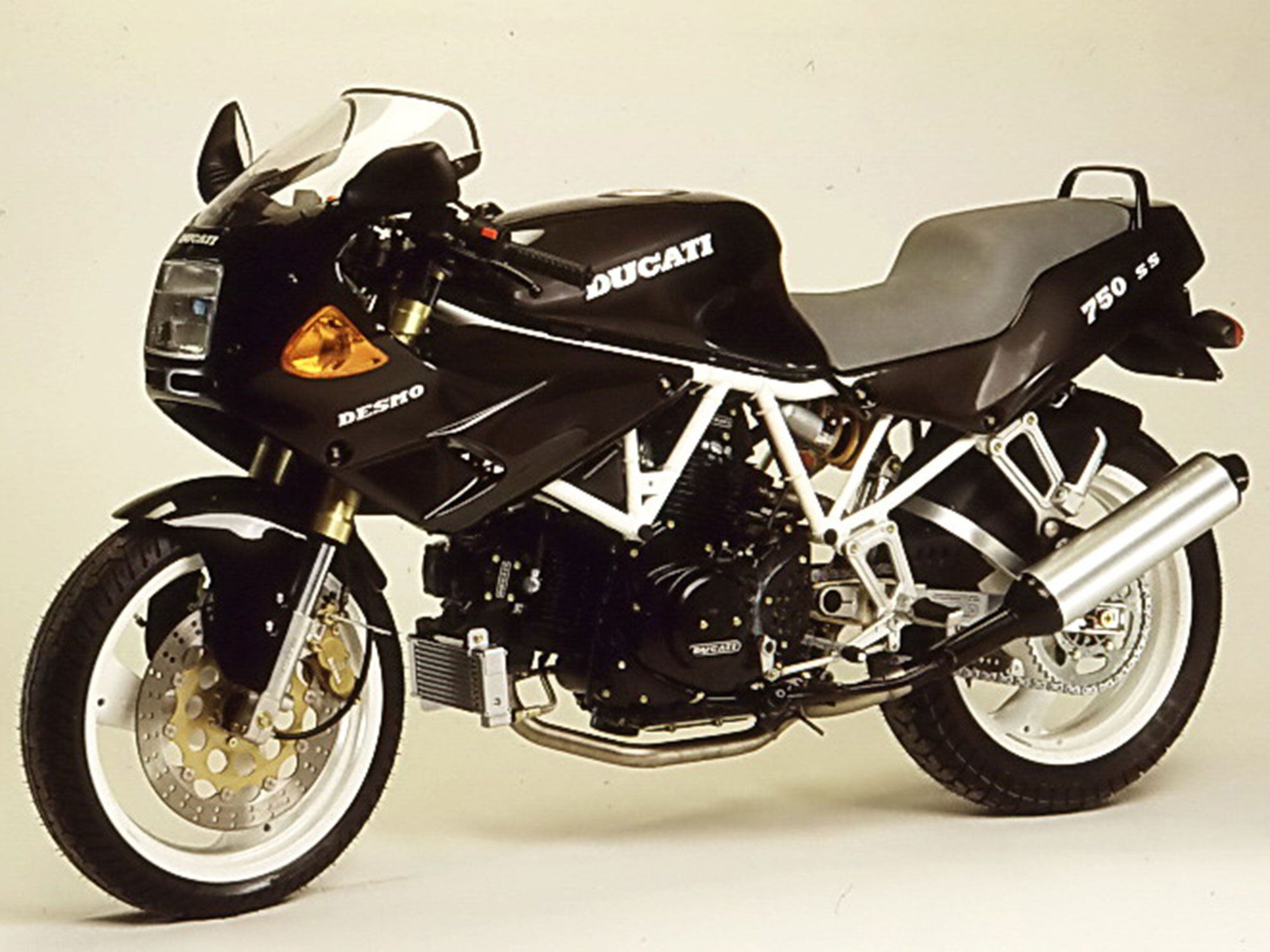
The final edition of the first generation of the Ducati SuperSport with Brembo Gold components. (Ducati/)In 1999 Ducati introduced the second-generation SuperSport. Hopes were high, because Ducati planned to introduce a complete range of models from 620cc to a smart 800cc to a full 1,000cc in order to address all possible levels of the sportbike market. All power units were based on the old-faithful air-cooled SOHC two-valve desmo, which underwent a technological updating program including the adoption of Marelli’s latest fully integrated digital ignition-injection system.
The profile of the original combustion chamber was modified slightly, and the 1,000cc version received a twin spark ignition to ensure that combustion would be as complete and clean as possible inside its 94mm bore/71.5mm stroke cylinders. Engineer Pierluigi Mangoli had worked with Dr. Taglioni and knew all the secrets of the Pantah 500 unit. Mangoli was able to bring emissions down to the soon-to-come Euro 2 standards while extracting brilliant power output from a classic old design.
RELATED: The 1991–1997 Ducati 900SS Is The Used Motorcycle You Need
The 80mm bore/61.5mm stroke 618cc unit featured a fairly high 10.5:1 compression ratio and breathed through a 45mm centrally located throttle body to generate 61 hp at 8,750 rpm, with 40 pound-feet peak torque at 6,500 rpm. These numbers are rather impressive for an air-cooled two-valver, and the 2,250 rpm separating peak torque from peak power and indicate pretty good flexibility. The 620 V-twin was based on the original crankcase, allowing it to be paired with the equally original five-speed gearbox.
The 88mm bore/66mm stroke 803cc unit breathed through the same 45mm throttle body and features the same remarkable 10.5:1 compression ratio to generate a substantial 74.5 hp at 8,250 rpm and 51.6 pound-feet peak torque at 6,250 rpm. Again, I find these numbers indicative of a very positive thermodynamic efficiency, which on the road translated to very solid performance and throttle response.
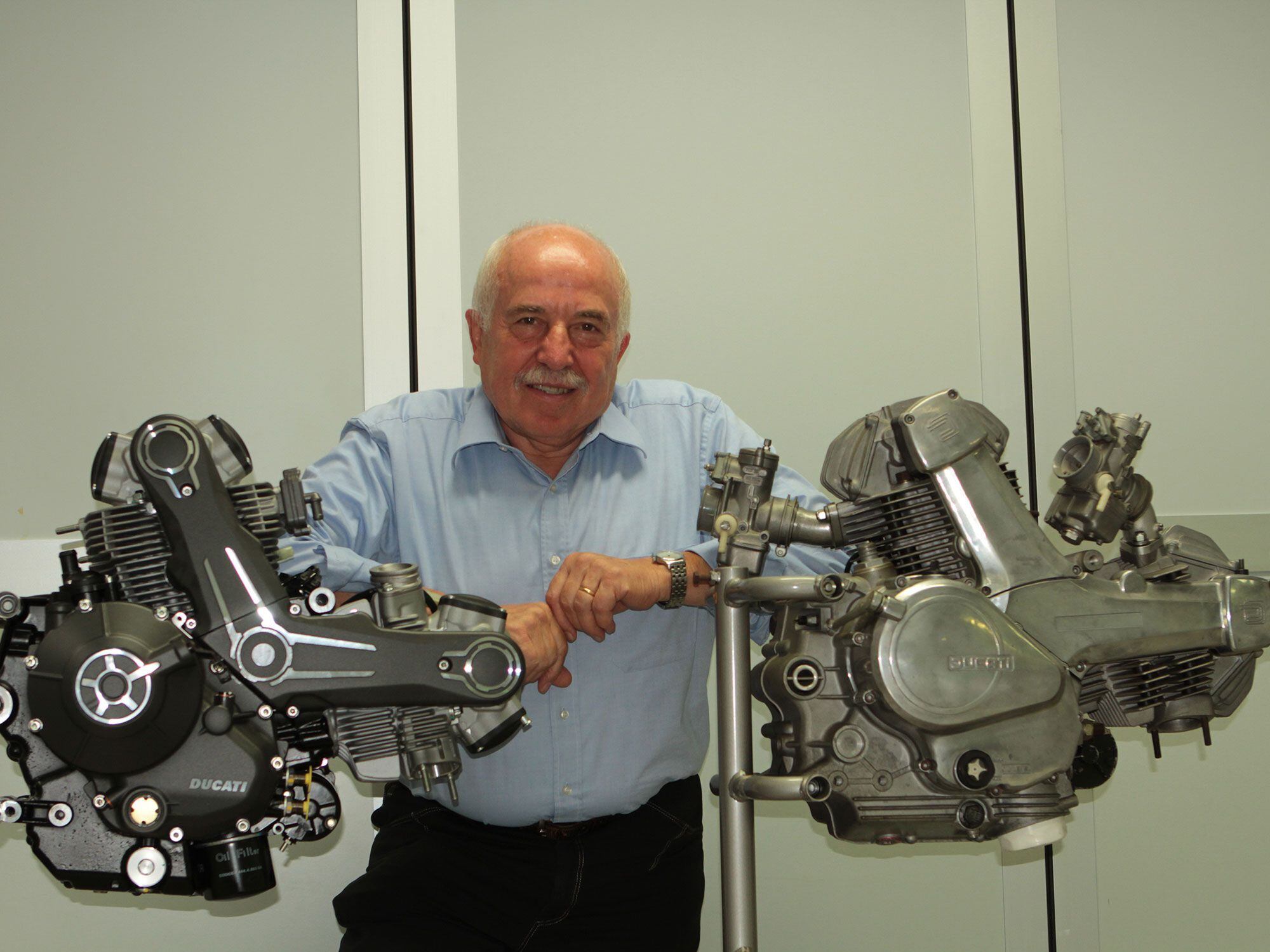
Dr. Gigi Mengoli with an original and modern version of the air-cooled SOHC twin. He had a part in every version. (Bruno dePrato/)The real SuperSport was the 1000 SuperSport, powered by what was recognized as the most advanced air-cooled desmo V-twin ever built by Ducati. With a 10:1 compression ratio and breathing through that same 45mm throttle body, it delivered 86 hp at 7,750 rpm and 65 pound-feet peak torque at 5,750 rpm for a positive combination of good top-end power and a very solid torque curve.
Dry weight was just above 400 pounds for a power-to-weight ratio that ensured consistent all-around performance, particularly in terms of midrange throttle response and acceleration, with a top speed exceeding 140 mph. I rode the bike extensively on all sorts of roads, but unfortunately, never on track time.
The chassis geometry marked a clear departure from the previous generation. The steel-tubing trellis frame structure was modified slightly to increase torsional rigidity, while the original cantilevered monoshock rear suspension evolved into a state-of-the-art cantilevered Öhlins shock absorber actuated by a link located at the top of the triangulated bracing of the new aluminum swingarm. At the front, a 43mm Showa fork replaced the traditional Marzocchi unit. The big difference was in the general geometrical setup.
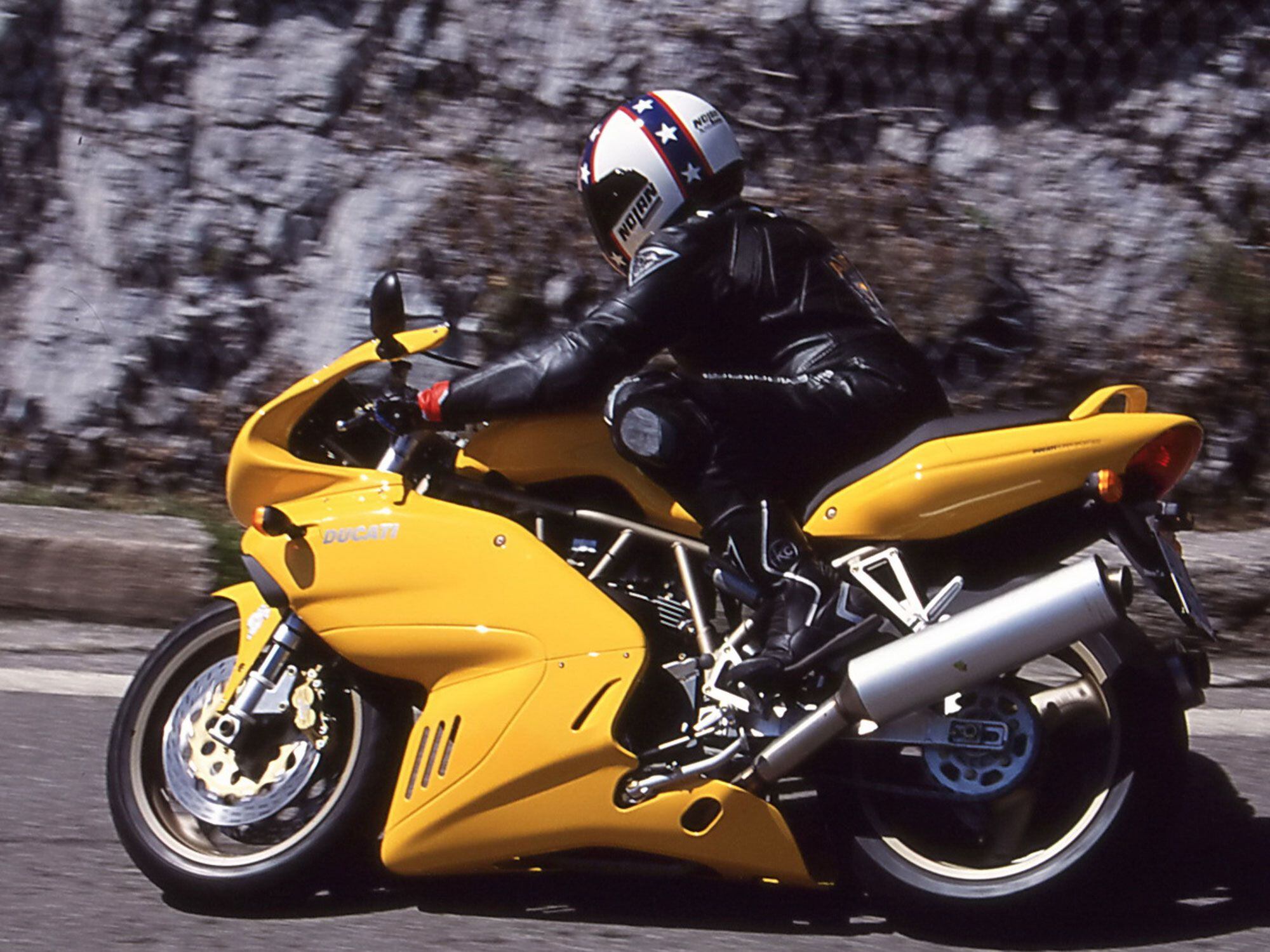
The second-generation SuperSport got more torsional rigidity and a shorter wheelbase. (Bruno dePrato Collection/)The new SuperSport models spanned a much shorter 54.9-inch wheelbase and had steeper steering geometry, with 24 degrees of rake and 100mm trail. While the steering geometry numbers meant that the Ducati technical team had fully absorbed Dr. Tamburini’s lessons, the 2.1-inch-shorter wheelbase prevented the new chassis from taking full advantage of it. While the front wheel had indeed been moved closer to the center of gravity, it was only by about a half-inch, once the transition from the previous small-diameter 16-inch tires to the new 17-inch radials was taken into consideration. The “L” configuration of Ducati’s air-cooled SOHC V-twin had no mercy, its shape and placement preventing the front wheel from moving any further back. Thus, a good share of the removed 2.1 inches was gained at the rear, causing a more rearward weight distribution bias.
The shorter wheelbase in turn forced a taller seat height, which grew from 29.5 to 32.3 inches. In the case of a 200-pound rider (me), the combination resulted in a less confidence-inspiring feel. Despite the steeper steering geometry, the rearward weight distribution still forced the front end too wide in the turns. Luckily, the solid frame structure ensured excellent high-speed stability.
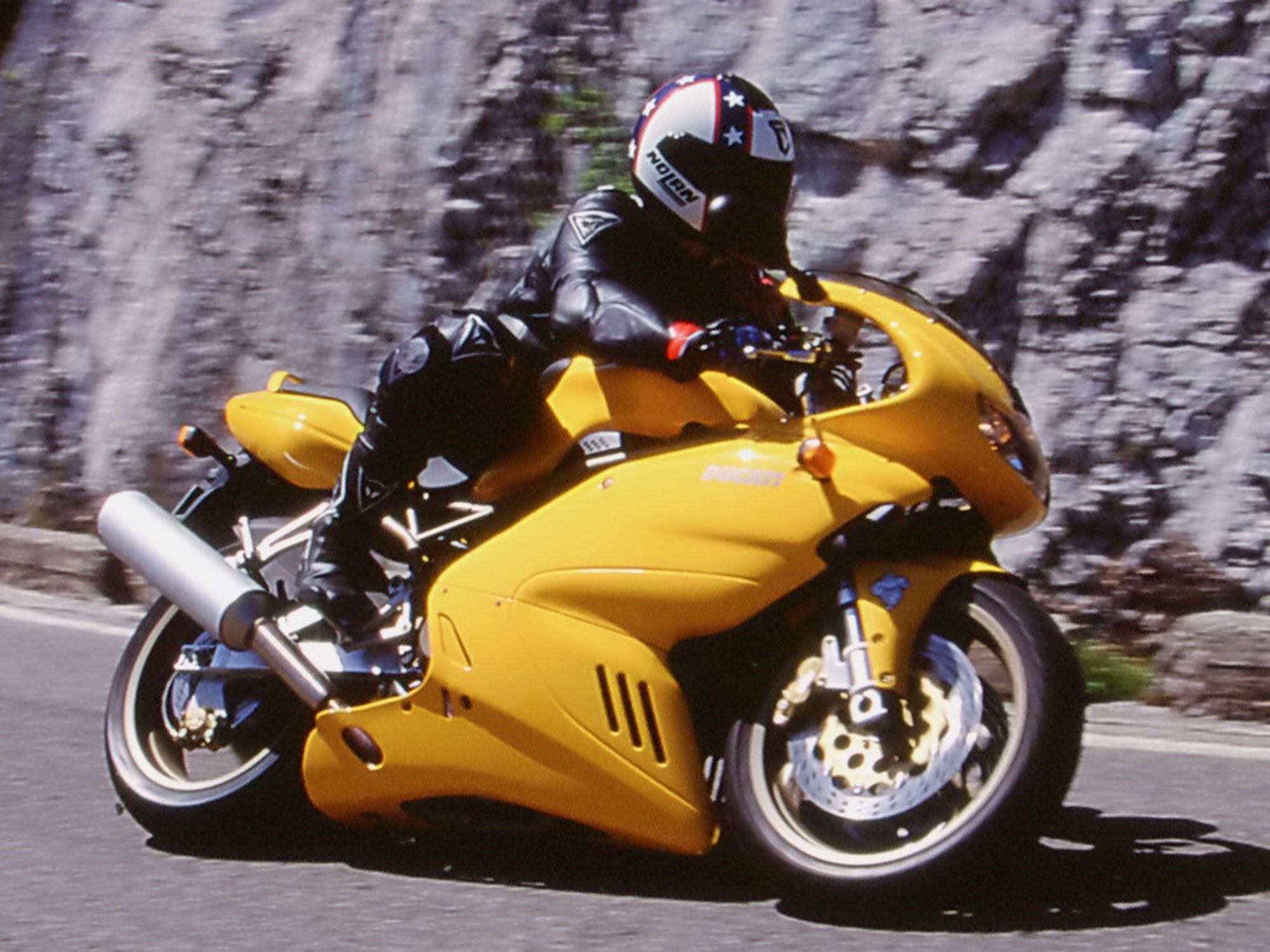
The second-generation SuperSport was an excellent performer. (Bruno dePrato Collection/)The bike was a very good performer, thanks primarily to its unusually strong and progressive engine. The motorcycle was very well equipped in all departments, with lightweight Marchesini aluminum wheels, a full Brembo Gold braking system featuring twin 320mm front rotors, an oil cooler, and Michelin Pilot Sport radials. At that stage of its life the 1000 SuperSport was not priced cheaply, at more than 10,000 euros, but it was still a very attractive value for lovers of Italian sportbikes.
And there was one thing about the bike that did not work. Ducati hired South African designer Pierre Terblanche. But his styling for the motorcycle was bulbous, unclean, almost crooked. The previous generation might have looked a bit basic, but it was simple and neat, as expected of a Ducati. The second-generation SuperSport series was a flop. In 2007, Ducati shut down production.
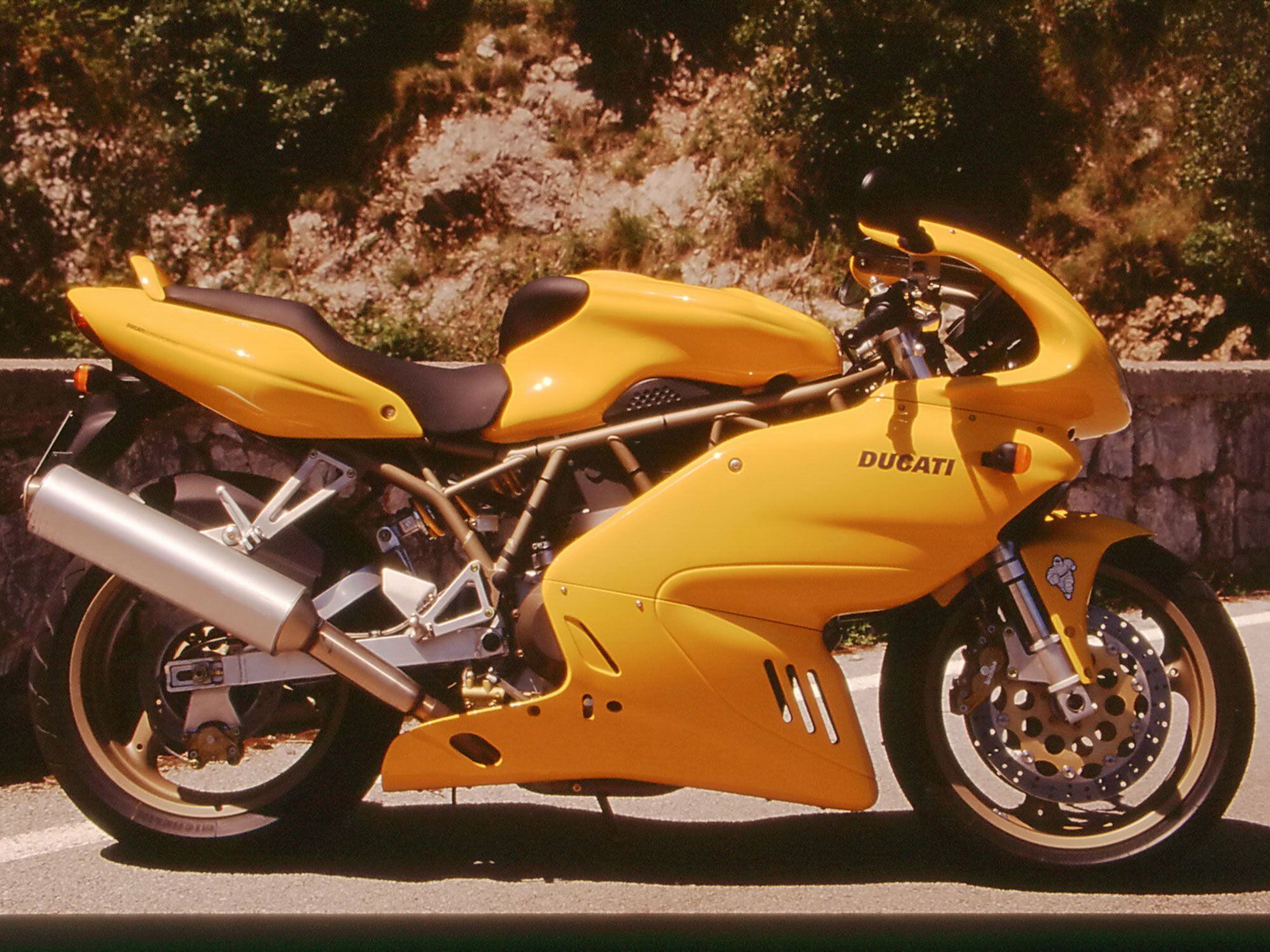
Pierre Terblanche’s design on the second-generation SuperSport was not well received. (Ducati/)Ten years later Ducati resurrected the SuperSport logo. Cycle World thoroughly tested the bike that, as in previous generations, was intended as the perfect sportbike for the common rider. The bike is state of the art in many respects; its chassis is intended for the Panigale engine, and when teamed with the mildly tuned 950cc Testastretta V-twin, delivers a glorious combination of great dynamic qualities and smooth power delivery. The motorcycle is easy to harness and keep under full control in perfect safety, with the assistance of one of the most advanced electronics suites in the business. It’s a supremely capable sport-touring bike, the likes of which we have been missing for years. It even included nicely designed touring bags, emphasizing the “touring” element of its avocation.
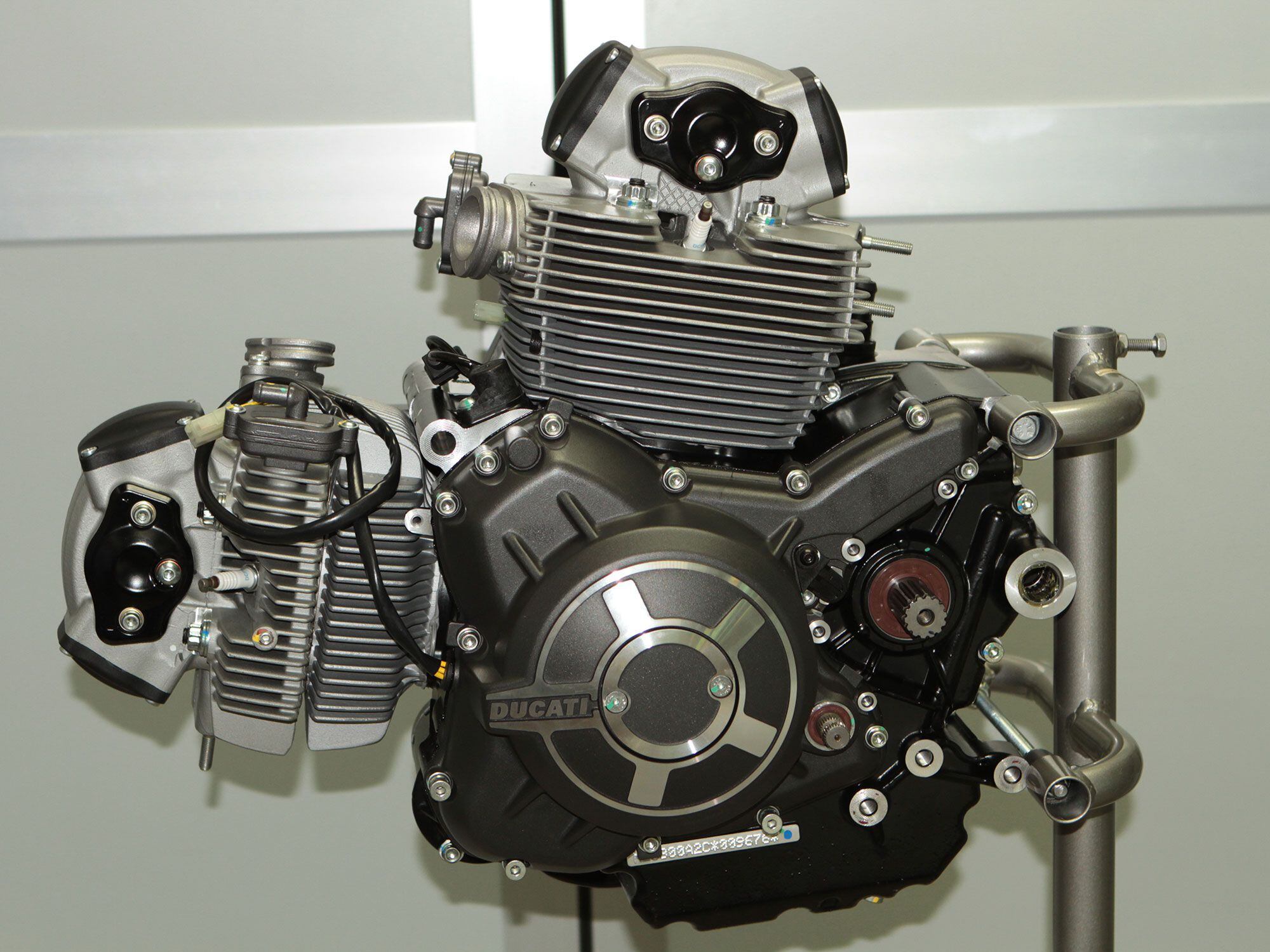
The air-cooled SOHC L-twin at the center of the SuperSport’s success is now powering the highly popular Scrambler line. (Bruno dePrato/)Yet it is not exactly the natural heir of the old SuperSport. This is a much richer, much more sophisticated bike, more expensive, but also more versatile. I would say that, when looking back to the previous generations, it misses the basic, versatile power unit that the air-cooled SOHC V-2 was and that determined the good value for money price.
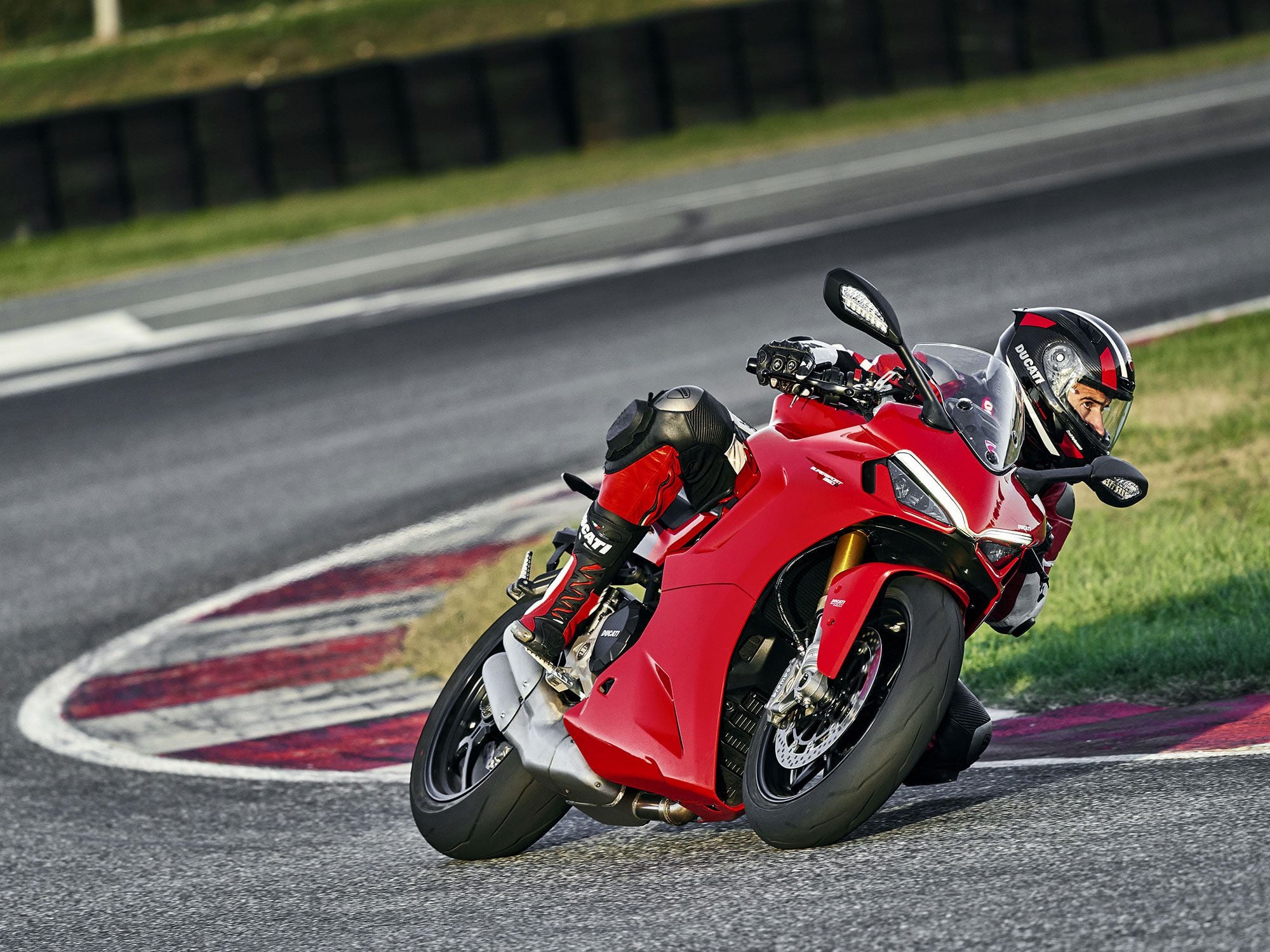
Will the 950 SuperSport sell 10,000 units like SOHC-powered units that came before it? Only time will tell. (Ducati/)That legendary V-2 still is there—in Ducati’s new 1,100cc, 86 hp edition that might be adequate for an old-style, low-price, basic SuperSport. But I might have gone a bit too far down memory lane. Even in a sport-tourer, today’s riders want state-of-the-art technology, refinement, power in reserve, versatility, comfort, and safety. The Ducati SuperSport 950 coming to the market in about a month enhances the qualities of the previous version, adds all the modern technology that is required of a Ducati, and will get the job done smartly and in style. But probably it will not sell 10,000 units a year like the old ones did.
-
Hello ant,
Welcome to The Motorbike Forum. Please feel free to browse around and get to know the others. If you have any questions please don't hesitate to ask.
Why not tell us a bit about yourself too.
-
Deliveries will commence in the coming months with the updated version of the Himalayan.
-
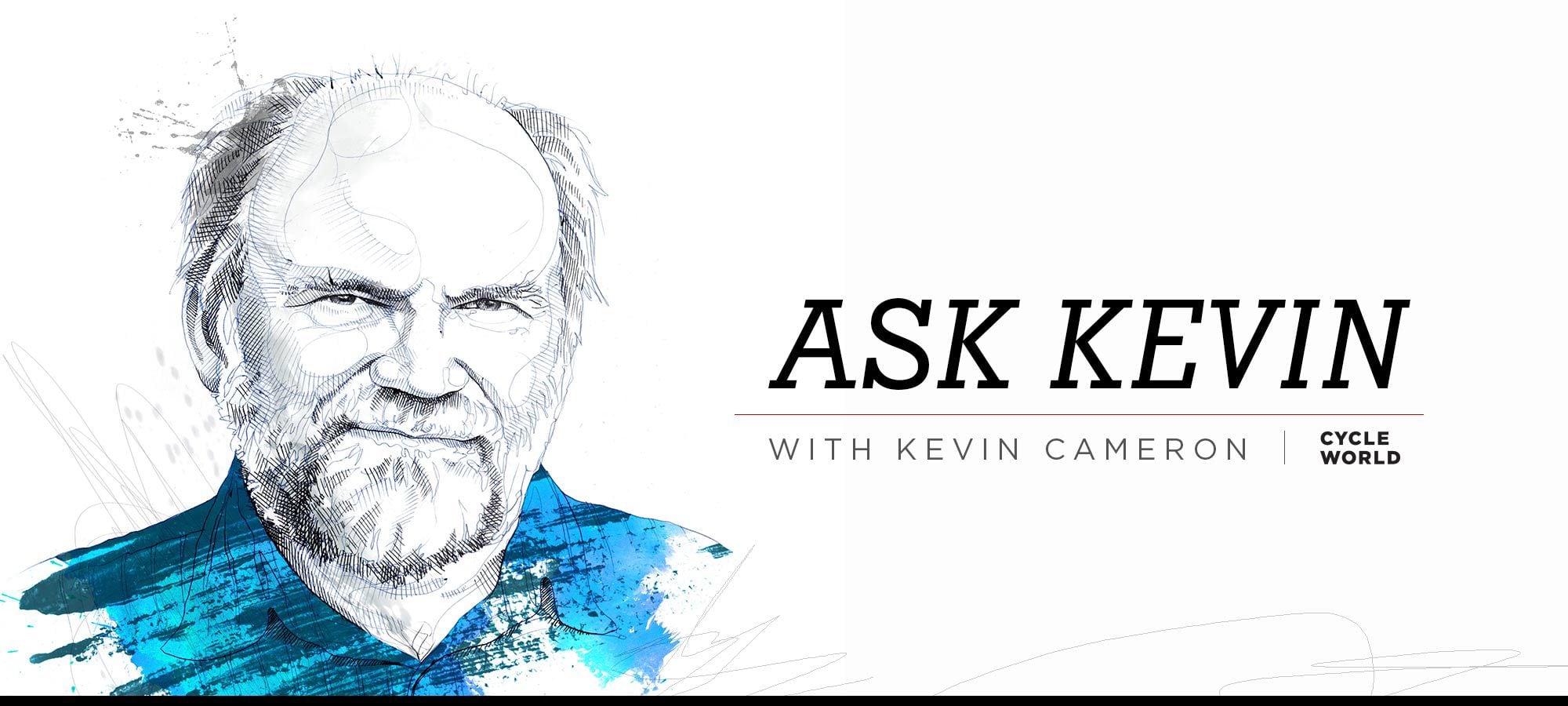
Kevin Cameron has been writing about motorcycles for nearly 50 years, first for Cycle magazine and, since 1992, for <em>Cycle World</em>. (Robert Martin/)Yesterday I wrote about a certain kind of rider, one who has grind marks on the fork caps of his very second-hand-looking daily driver. It was clear from some comments (which I’m always delighted to have) that a few readers found that obscure. The fork caps are the aluminum fittings screwed into the tops of the fork legs. They get grind marks on them when ardent riders push their learning process, crash with panache, and their tumbling bike chances to slide up the road, wheels uppermost.
In my experience, this kind of thing is not limited to racetracks at all. When I was hoping college would end soon one way or the other, like-minded persons with bikes were taking them to places like the Elliott Rotary and going ‘round and ‘round until they found the traction limit. They wanted to find it, and they found it. Mike Baldwin, before he hied himself to the track, would go out riding in the Connecticut countryside and come home with his jeans destroyed.
There was a footpeg hierarchy. Less driven riders could only dream of having a peg on the pavement, trailing sparks. I’ve written before of riders waiting for some service or other in my little shop and spying the belt grinder. Yes, it’s true: some of us are not Michael Hailwood reborn, and the only way our footpegs will strike sparks and our helmets will get those exciting grind marks is on the belt grinder.
Help yourself, I told them.
Attitudes toward the motorcycle change constantly. When I was first messing with bikes, life had a slightly unreal and statistical character brought about by not knowing if or when the letter would come from the draft board, morphing the recipient into a rifleman in Southeast Asia. It might be wise to tuck some fun under one’s belt before things got too real. One night I dreamed I looked down from an upper-floor lineup waiting to be checked for flat feet and saw my friends loading their TD1s, tools, and spares into their vans to go to the next race.
Then in the 1970s we had the bike shop and young men (and some less so) came in, saying things like, “Well, they let me go at work yesterday, so I decided to buy a bike.” Today the PC thing to do would be to pontificate on responsibility and prepping for the rainy day, but then we just sold and serviced bikes.
Bang, everything changed again. In the 1980s, fun was the last thing on the minds of young men (where did those good industrial jobs for non-degree-holding fellows aged 18 to 25 go?). They wanted solid achievement, Beemers if possible, with four wheels, child safety seat, and string-backed driving gloves to go with the Driving Machine. Every article of clothing clearly brand new.
Older men had to responsibly take over the task of buying bikes. It was the era of the CEO Harley rider, rolling up 300 miles a year as a member of the Riding Club of Greenwich. Bikes were in fact a blessing for those people, liberation from what the sociologist would call “class expectations.” In fact this was a real kind of freedom, unbuttoning the buttoned-down. The industry, performing its due diligence, soon discovered that what its new buyers wanted was more expensive, more interesting bikes. Begone, ye undignified crotch rockets such as Kawasaki’s most-bang-for-the-buck Mach IV 750 H2. I saw the new owners, taking the Harley factory tour in Milwaukee. Carefully dressed. No lint. But having a new kind of fun.
Harley-Davidson was lured away from its intended error called “Nova,” a V-4 it hoped would compete with Japan. Its Minneapolis ad agency put them straight: Harley is the flag, the heart of being an American, equivalent in gender certification to serving four years in the Marines. It worked. No one in the industry could understand how. Its intense customer loyalty brought Ford Motor Company into “commercial companionship” to investigate how Harley did it.
At present, we’re holding onto what we’ve got, washing and waxing as we go to sustain resale value. Some people pick the bikes they buy based on that alone. You’d have to be crazy to grind your fork caps, in either nature’s accidental way or on the belt grinder. You have any idea what those parts cost? And you’d hafta get someone to install them at a hundred dollars an hour. That’s OK. Competition from video games is fast leaving reality behind. I have no clue what’s next.
-
Hello motorcyclesinthewild,
Welcome to The Motorbike Forum. Please feel free to browse around and get to know the others. If you have any questions please don't hesitate to ask.
Why not tell us a bit about yourself too.
-

Riders on air-cooled Harley-Davidson motorcycles line up for practice at Chuckwalla Valley Raceway. (Justin George/)Following the successful King of the Baggers Race last October, a new race series has just been announced: the Bagger Racing League. This past Monday, more than 100 Harley-Davidson and V-twin riders met at SoCal’s Chuckwalla Valley Raceway for a trackday, but this day at the races would prove to be only the beginning. Formed by many of the same teams that were behind the first race of its kind at Laguna Seca last fall, the Bagger Racing League will be a V-twin-centered series of events outside of the continued MotoAmerica King of the Baggers series.
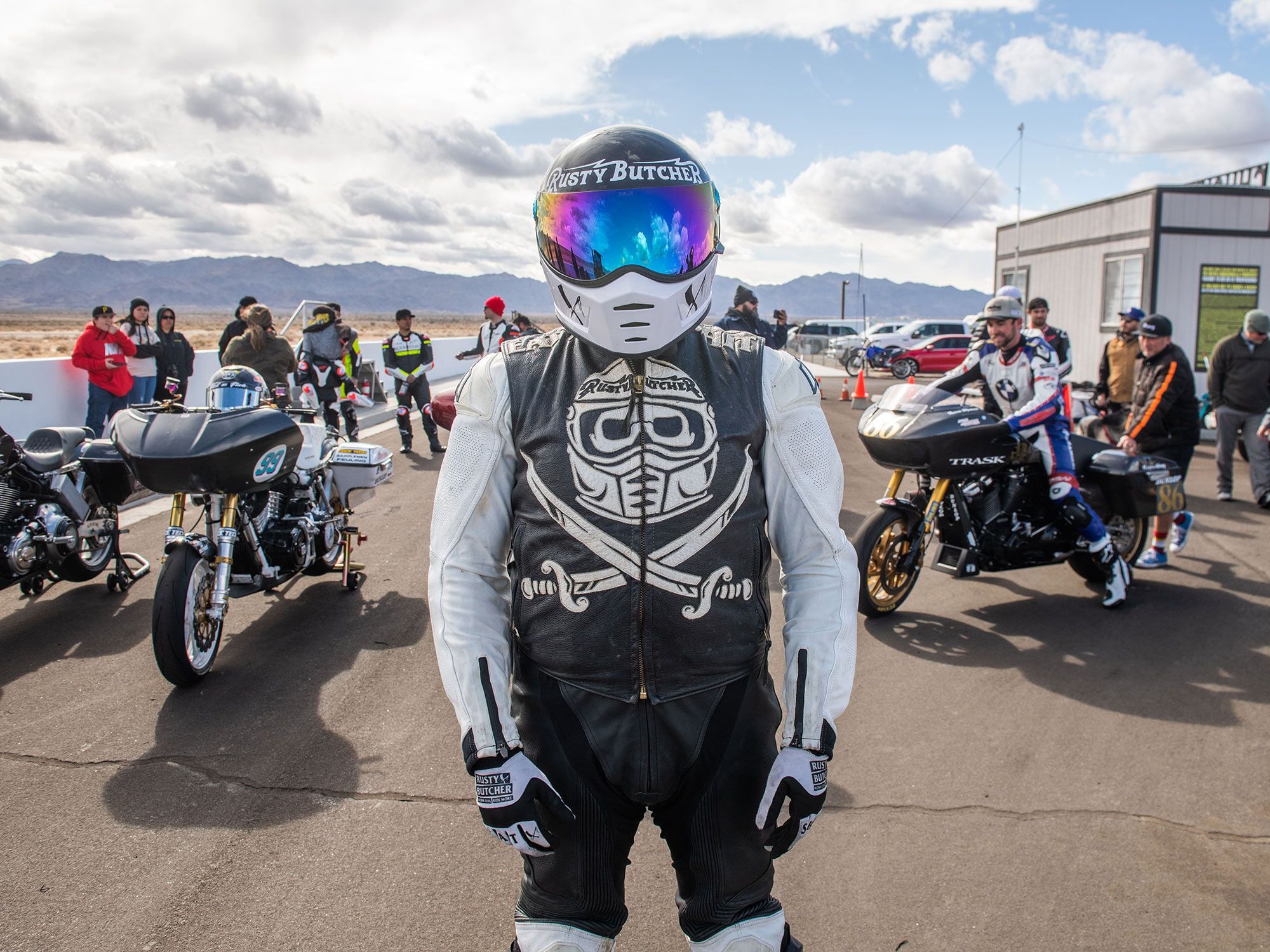
Mark Atkins of the Rusky Butcher ready to race his modified Road Glide. (Justin George/)The Bagger Racing League is a nationwide race series consisting of four race classes: Hooligan, Big Twin, Stunt, and Bagger. Hooligan is the Sportster, FTR, Scout, Buell, even LiveWire class. Up next is the Big Twin class, where we’ll see pushrod Indians, Dynas, FXRs, Softails, and the like. Then there’s a new, slightly perplexing but guaranteed to be entertaining class, the Stunters, where riders will qualify the night before the race by putting on a stunt show to determine their starting positions. Lastly, the main event is the Baggers, where we will see many of the teams from King of the Baggers, as well as new additions, line up to send their (formerly) heavyweight touring bikes around the track.
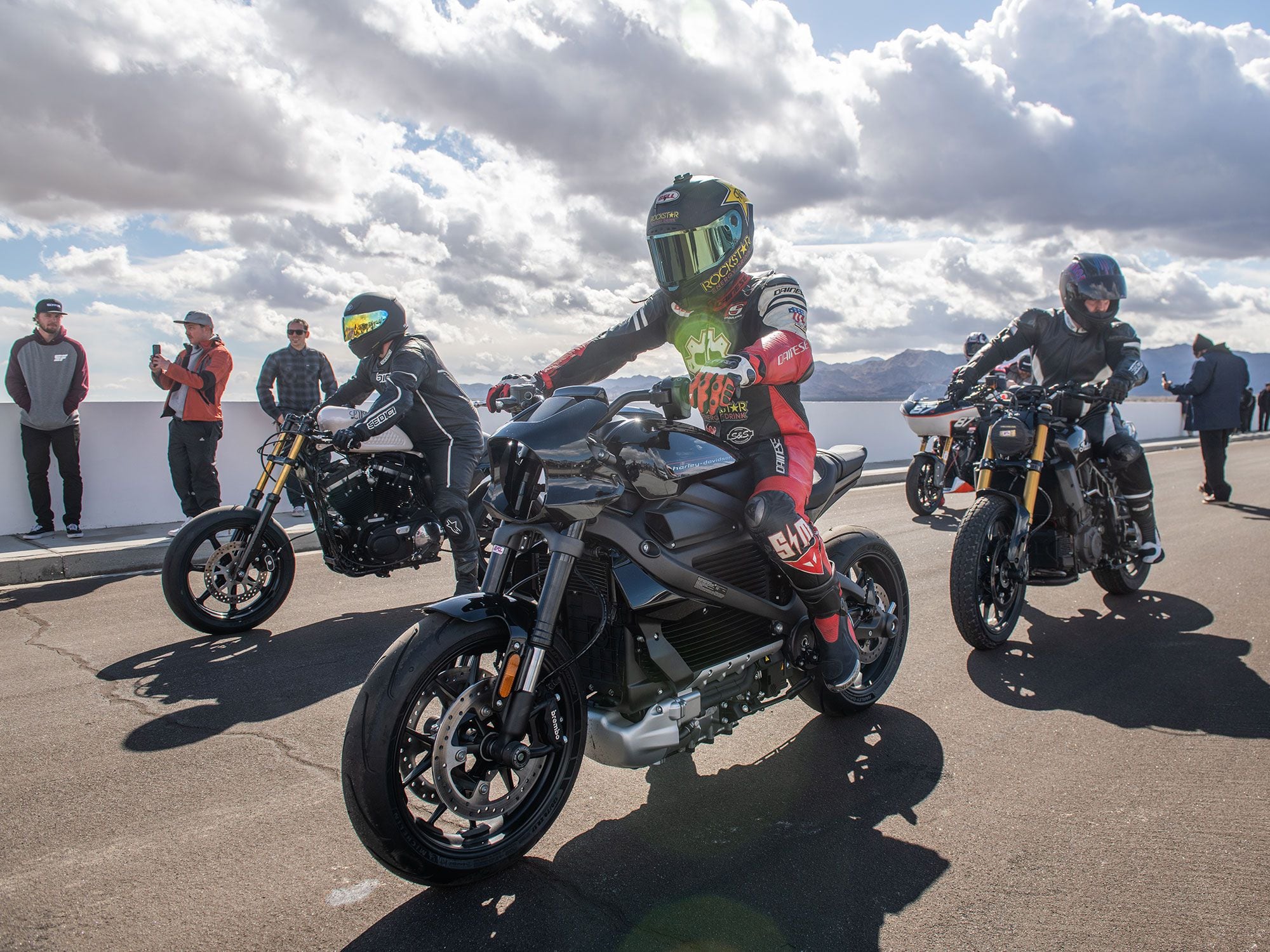
While all other classes are V-twin specific, the Hooligan class will include the H-D LiveWire, seen here piloted by Shaun Guadardo. (Justin George/)And while the Bagger Racing League is going to be entirely centered around racing, attending the events promises to feel more like a motorcycle rally than a typical sanctioned race. “It’s going to be the fastest bike show in the world!” founder Rob Buydos said. “We’ll have an Arlen Ness custom bike show, stunt show, live music, and a vendor village full of high-performance Harley-Davidson and V-twin-specific parts.”
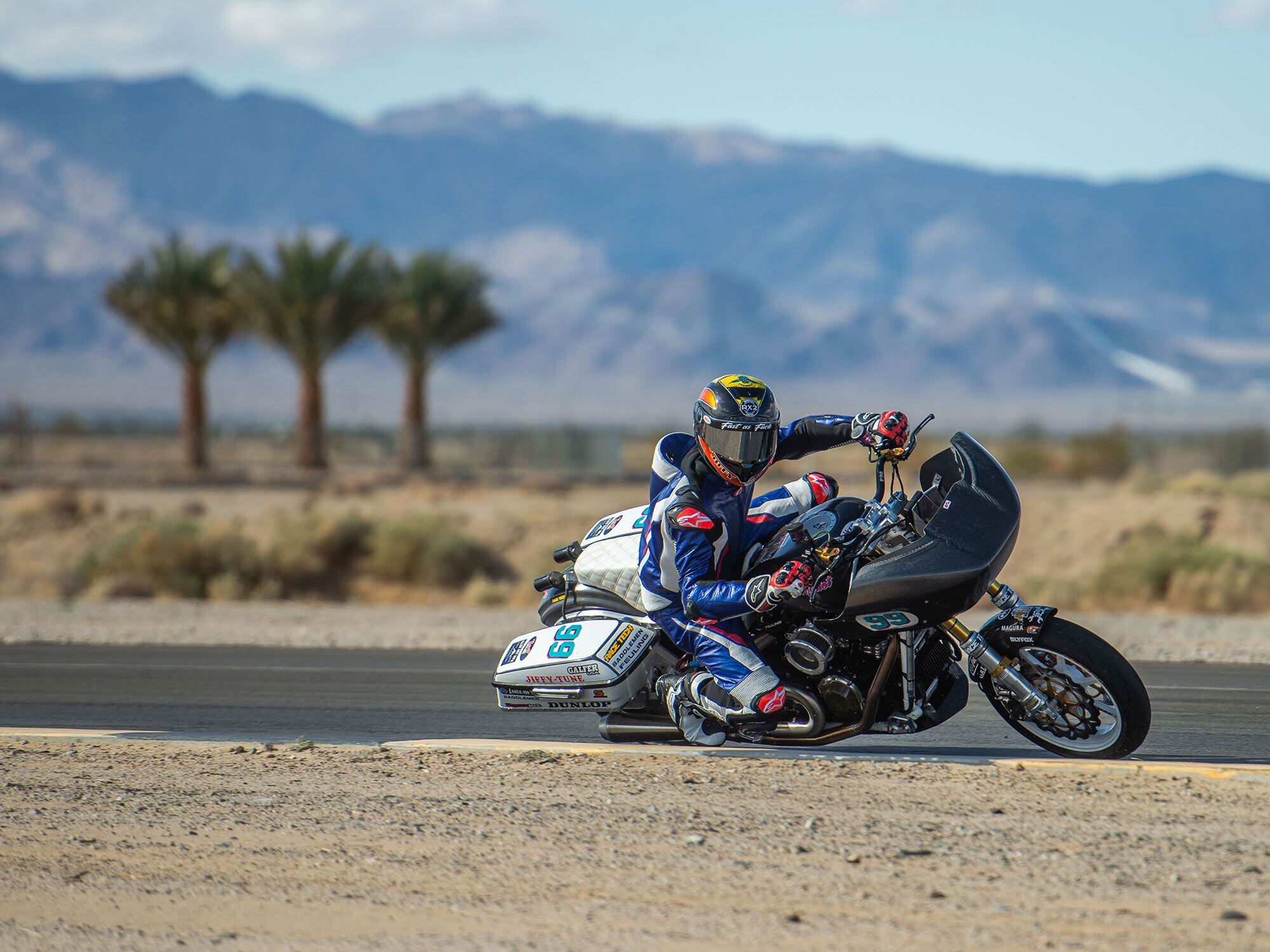
Eric Stahl of Jiffy Tune guiding his carbon fiber-adorned Road Glide around the track at Chuckwalla Raceway. (Justin George/)RELATED: Indian Motorcycle Teams With S&S For King Of The Baggers
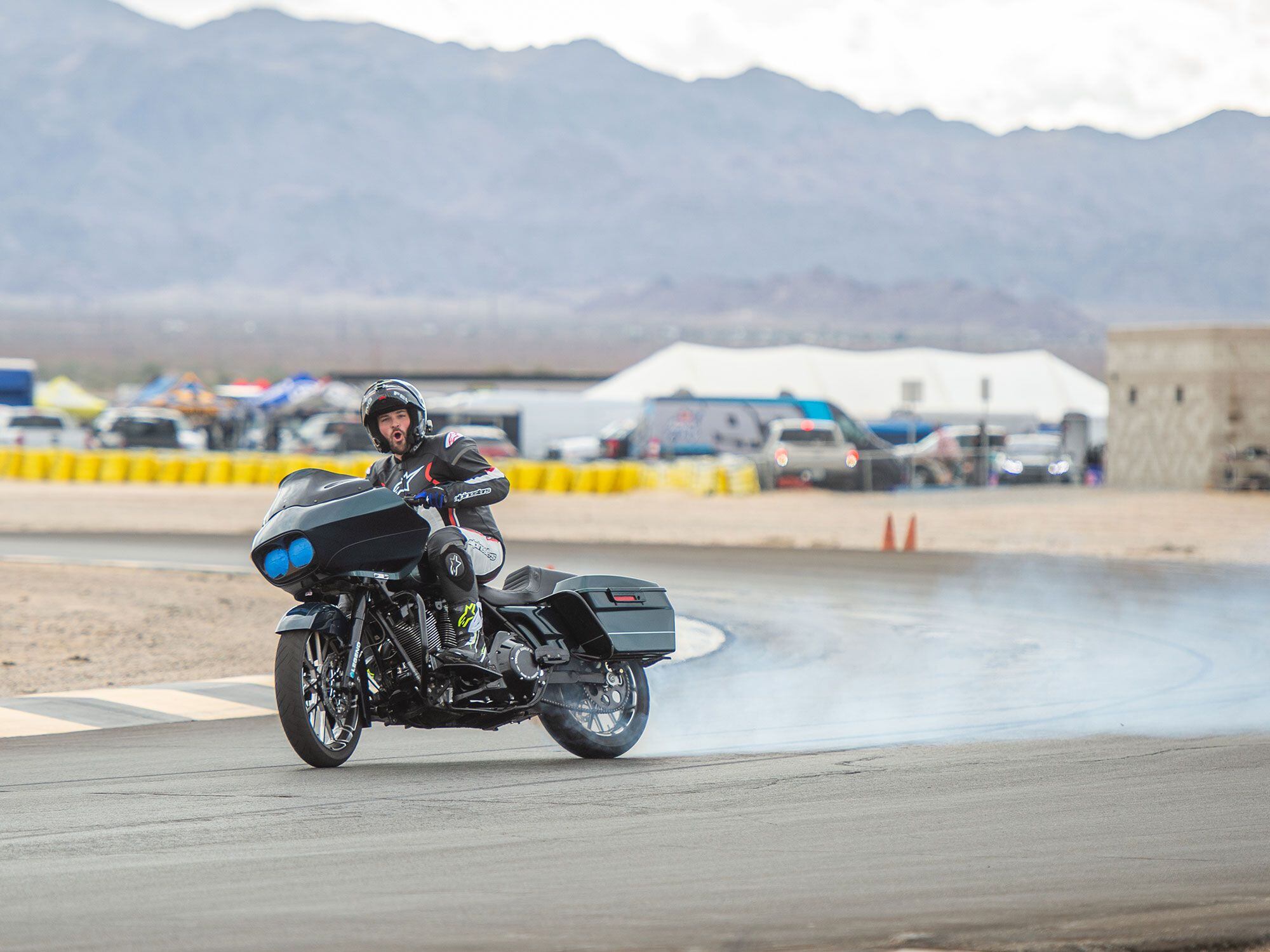
Jeff Flaherty, better known as @CBearsStunts, taking the guesswork out of figuring out which class he’ll be racing in. (Justin George/)“The goal for us is to take the energy and excitement that any person throwing their leg over a motorcycle has, and bring that into a competitive and safe environment, to the racetrack,” said John Oakes, cofounder and operations officer of the new Bagger Race League. “There are elements of what we do that will attract non-motorcyclists. But our goal is to entertain motorcyclists, whether you ride a couple weekends out of the year, or you put down a million miles. Watching guys on Street Glides and Road Glides clock a buck-25 on the straightaway and stuff it into the corner on a roadrace track is just awesome entertainment!”
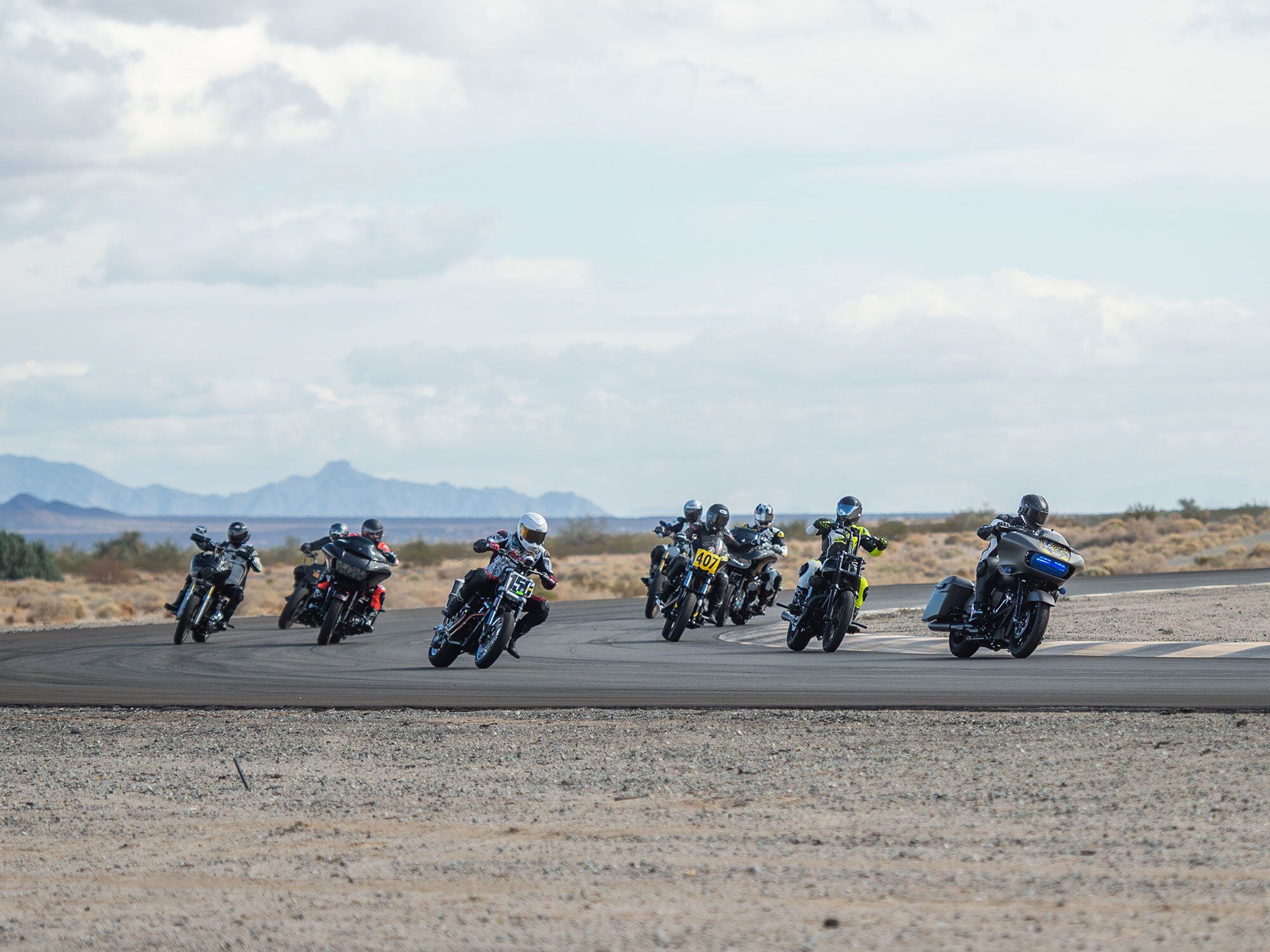
Baggers and Big Twins overlapping on an exhibition lap. (Justin George/)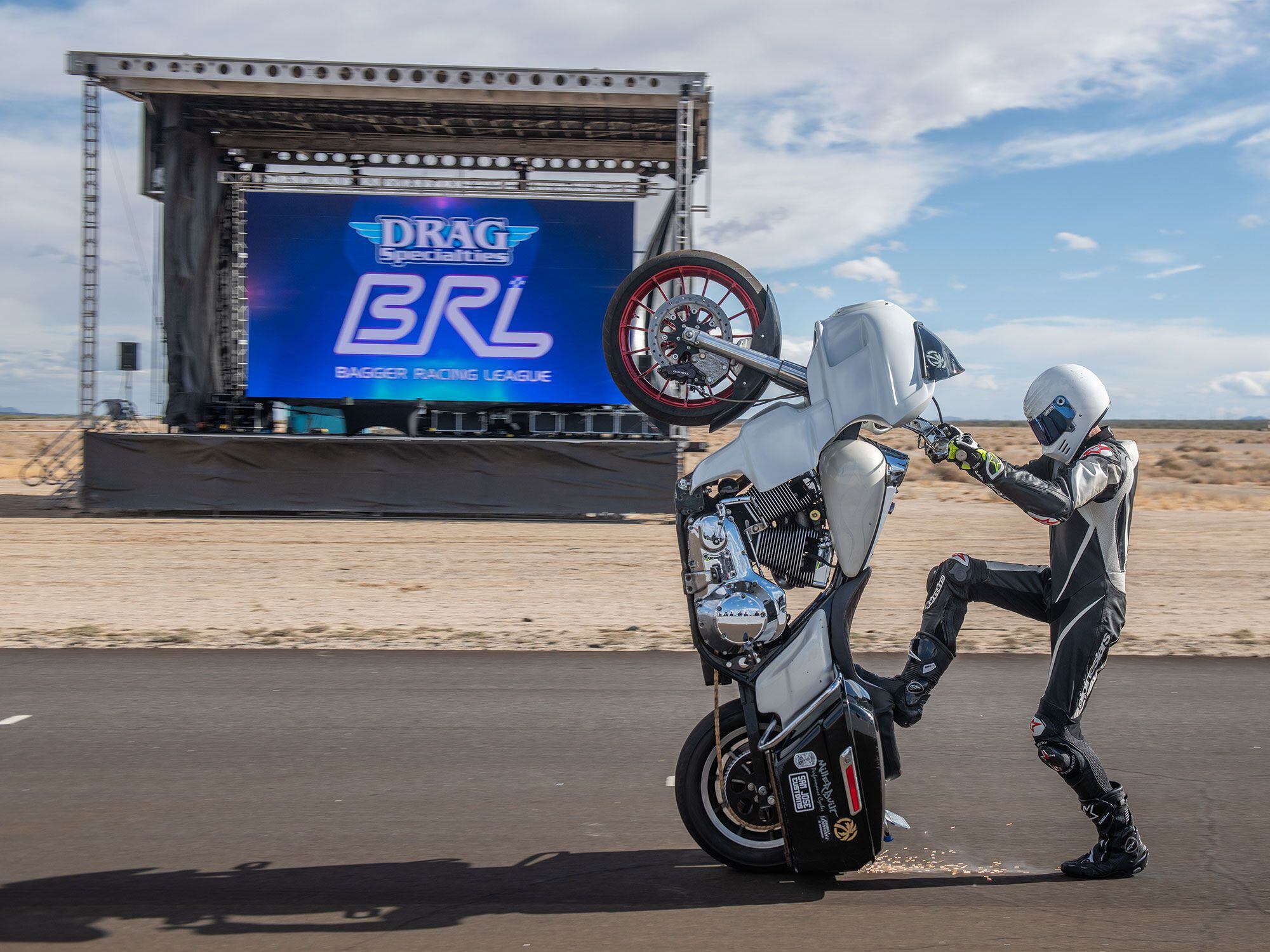
Peanut, also known as @BagDraggin_37, will be performing stunts at night and racing the next day in the Bagger Race League Stunt class. ( Justin George/)Performance-minded motorcycle customization has been a real movement in the last few years, with many of the brands that sponsor this race series helping to drive that movement forward. By focusing this event on the V-twin community specifically, those behind this event hope to reach the relevant market more directly than they would at a MotoAmerica race.
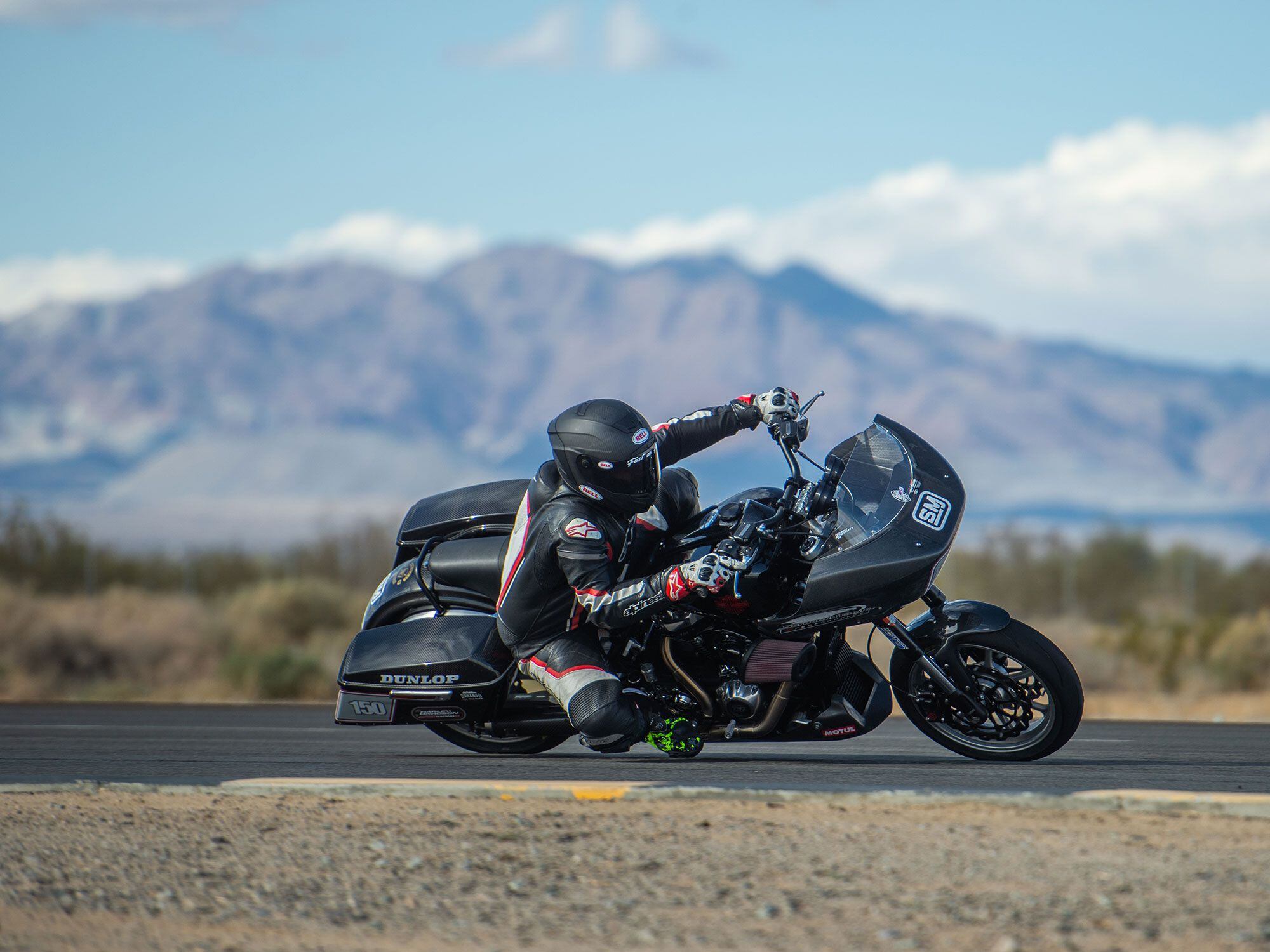
Tony Sollima of Shred Moto Co. finding the limits of his bagger’s lean angle. (Justin George/)The first event kicking off the Bagger Racing League series will be in Salt Lake City at the Utah Motorsports Campus on June 25, 26, and 27. More info will be coming to baggerracingleague.com shortly, but details are currently very limited.
-
Hello Weld Kamali,
Welcome to The Motorbike Forum. Please feel free to browse around and get to know the others. If you have any questions please don't hesitate to ask.
Why not tell us a bit about yourself too.
-

Yamaha has been using VR systems for years and recognized that nausea in some users can be a problem. (Yamaha Motor Corp./)Virtual reality headsets have been a technology that’s “just around the corner” for decades, but with the advent of mainstream kits like the Sony PlayStation VR and smartphone-based VR headsets it’s finally becoming something that normal people are likely to use on a regular basis. Yamaha sees that it also offers potential for motorcycle R&D and as such has set out to solve the problem of motion sickness dogging many VR users since the systems have become more common.
If you’ve never experienced it, that VR sickness can be a deal-breaker. The conflict between the convincing visual signals that you get from a virtual reality headset and your other senses, combined with the imperceptible lag between your movements and the image on the display, can lead to nausea almost immediately in some users.

Masayuki Miki (left) with Yamaha’s Technical Research and Development Center says ongoing research into VR sickness can help with product functionality down the line. (Yamaha Motor Corp./)Yamaha has been using VR for R&D purposes in motorcycle development for a while and found that nausea was a big enough stumbling block that it set out to solve the problem.
Masayuki Miki, a member of the joint research team at the Fundamental Technology Research Division at Yamaha’s Technical Research and Development Center, explains: “Since VR allows us to ‘ride’ a wide range of products on all kinds of road environments our simulators and VR equipment play an important role in our research into rider–machine dynamics. It also goes toward achieving our Jin-Ki Kanno development ideal (Yamaha-speak for the ‘seductive exhilaration of being one with the machine’) as well as serving as a component contributing to the strong reputation we have for Yamaha handling.”
With several of its own test riders suffering from VR sickness when using the equipment, the company has taken part in research with the Makoto Miyazaki lab at Shizuoka University to tackle the problem. Miki says: “At Yamaha, we already had our own theories based on experience, like that no accompanying sound in the simulations seemed to make the sickness worse or that vibration seemed to help reduce its degree, but we had no clear evidence for any of them.”

In research using a scooter simulator, the company found that better synchronization of visuals with sound and vibrations led to lower levels of VR-induced nausea. (Yamaha Motor Corp./)During the research, 80 riders were asked to take five-minute rides on a scooter simulator, wearing an Oculus Rift VR headset on a program that took them down a twisting road. The test subjects were split into groups, some experiencing just the VR visuals, others getting visuals and matching sound effects via Bose noise-canceling headphones, and finally some experiencing the full simulation including visuals, sound, and vibrations through a pad in the scooter’s seat.
That last group, experiencing visuals along with the right sound and vibrations for the most immersive experience, suffered significantly lower levels of VR-induced nausea. The results were published in a scientific paper, “Effects of synchronized engine sound and vibration presentation on visually induced motion sickness.”
With that knowledge in hand, Yamaha has plans to use VR as a way to engage its customers more in the development of new bikes.
“If this ongoing research project leads to a substantive solution,” Miki says, “it will become possible to have riders with different riding techniques and perceptions participate in virtual test rides of prototype vehicles in the early stages of development using existing roads from around the world. I’m sure that this will lead to product development that is not just more efficient and more in line with the actual use conditions of our customers, but also results in products with greater performance, functionality, and more uniquely Yamaha qualities. It will surely also help with creating social VR environments and facilitating remote communication.”
-
-

The 1290 Super Adventure S gets tighter steering geometry, updated suspension, adaptive cruise control and more for 2021. (KTM/)The 1290 Super Adventure S, KTM’s beastly street-oriented ADV-tourer, has been updated for 2021 with tighter steering geometry, updated semi-active WP suspension, radar-based adaptive cruise control, a new 7-inch TFT display, and more.
Well, for the European market, anyway. But in light of KTM’s penchant for giving Europe a head start, we’re betting the 1290 Super Adventure S ends up on the North American new-for-2021 or -2022 list.
If crushing mile after twisty mile without visiting your chiropractor afterward is your idea of a good time, the 2021 Super Adventure S would really like to be your friend. Updates include a shorter frame and longer swingarm, with the 1,301cc LC8 V-twin rotated forward 2 degrees and the rake/trail tightened from 26 degrees/4.7 inches to 24.7 degrees/4.3 inches for sharper handling without sacrificing stability.
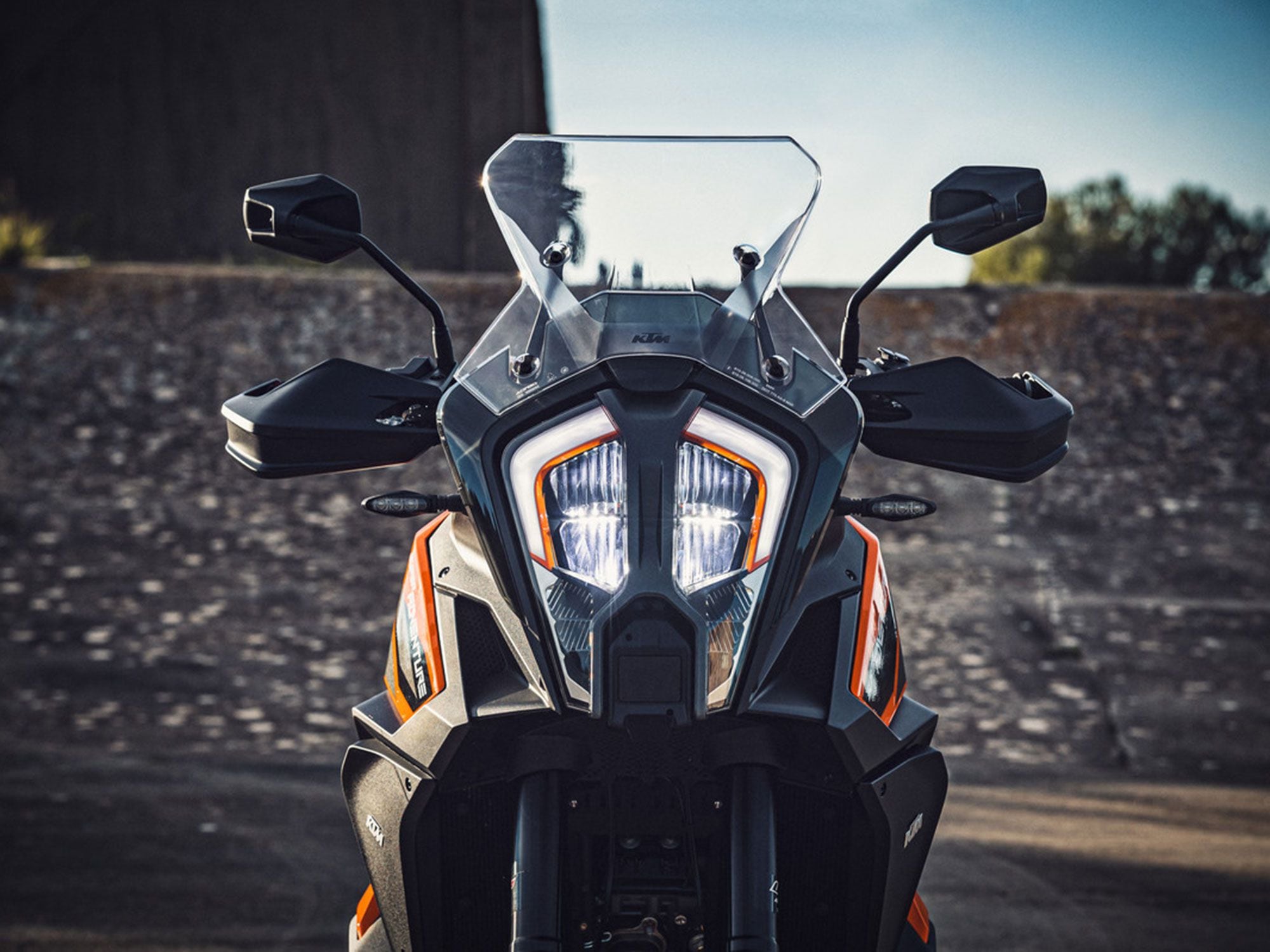
A new, taller windscreen is adjustable with either hand, and the LED headlight has a wider throw than before. (KTM/)While power output remains unchanged (KTM claims 160 hp at 8,750 rpm and 103.3 pound-feet of torque at 6,750 rpm), the high-strung twin is now even lighter thanks to thinner engine cases and a redesigned oil system. A revised Pankl gear mechanism improves feel and performance from the optional Quickshifter+, and new radiators shed heat away from the rider.
The current Super Adventure S already boasts numerous rider aids, but the 2021 model throws down with adaptive cruise control, a first for KTM. This radar-based system, developed with Bosch, automatically maintains spacing from vehicles ahead and can be adjusted in five levels from Very Short to Very Long.

With 160 hp (claimed) on tap and an optional Rally riding mode that unleashes all the beast’s potential, the 1290 Super Adventure S is ready to get as frisky as you dare. (KTM/)The semi-active WP suspension also gets an updated Suspension Control Unit that magnetically adjusts damping in real time and offers more rear preload adjustability than before. A new six-axis Bosch IMU is the brains behind the MSC (stability control), cornering ABS, and MTC (traction control). There are four standard ride modes: Rain, Street, Sport, and Offroad, with a Rally mode offered as an option. The rider controls the Austrian wizardry via redesigned switch gear with programmable favorites, all viewable on a new 7-inch color TFT display that is Bluetooth compatible and ready for KTM’s My Ride app.

New 7-inch TFT display is larger and more intuitive, with KTM My Ride functionality. (KTM/)Lightly redesigned bodywork wraps up all these goodies in a black-and-orange package. The windscreen adjusts over a 2.2-inch range with either hand. The new shorter seat height is adjustable from 33.4 to 34.2 inches.
It remains to be seen whether we will get similar options, but Europe’s 2021 KTM 1290 Super Adventure S will be available as a base model with three factory packages available. The Rally Pack features the Rally riding mode with associated MTC setting and adjustable throttle response. The Suspension Pro features individual damping for the fork and shock, automatic preload adjustment with three settings, and an On/Off Anti-Dive. The Tech Pack gives you all that and a bag of chips: all of the above plus Motor Slip Regulation, Hill Hold Control, Quickshifter+, and an adaptive brake light.

The 2021 KTM 1290 Super Adventure S puts the “sport” in adventure sport. (KTM/)US pricing is, of course, not yet available. But we’ll be on the lookout for news regarding if and when the updated Super Adventure S will be on its way to our shores.
-
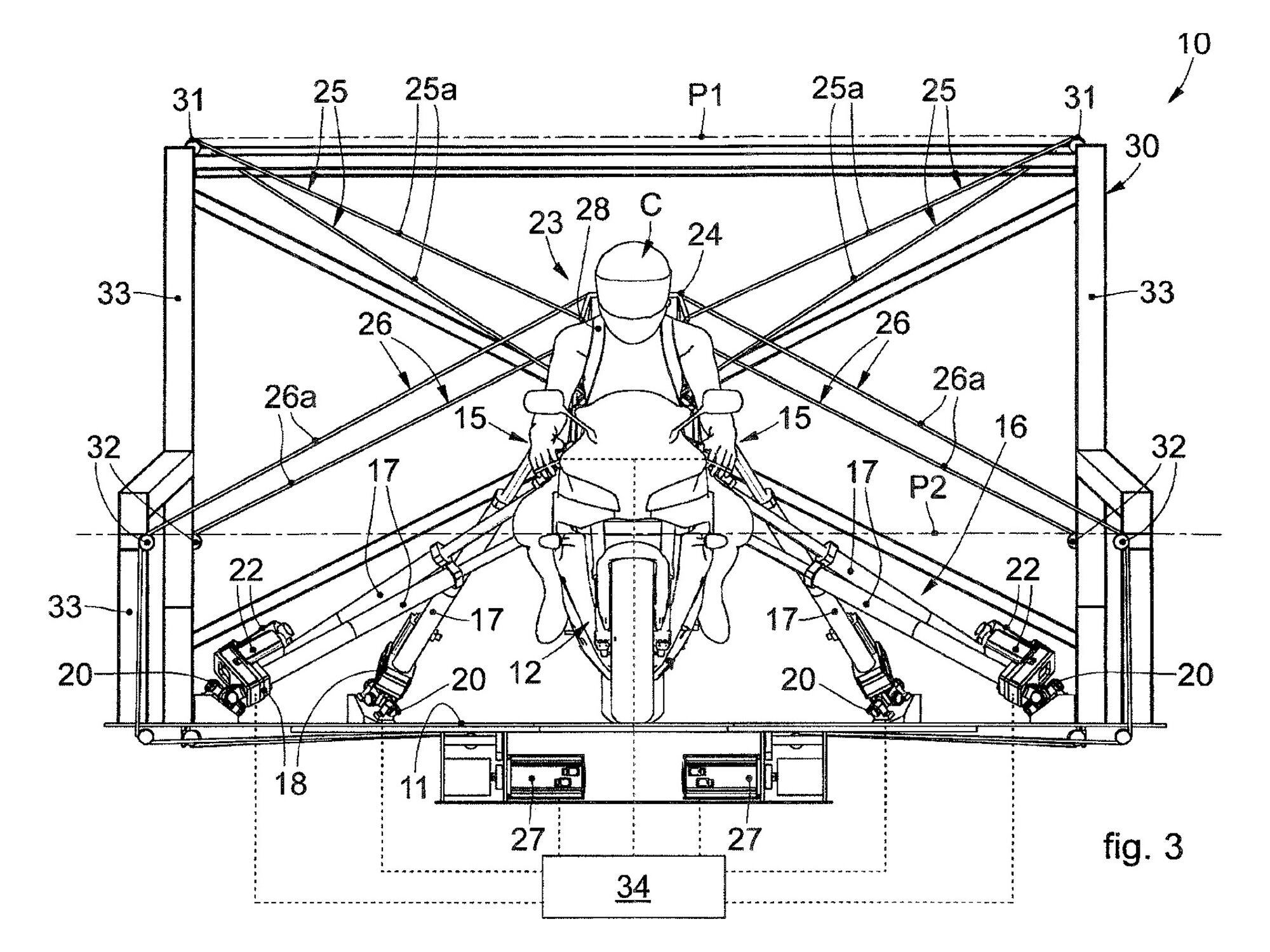
The German simulation firm has published new designs for an innovative, high-end motorcycle simulator. (German Patent Office/)As computers continue to follow Moore’s law and get exponentially more powerful with every passing decade it’s inevitable that reality simulation has become more prevalent in every aspect of research and development. Bikes are no exception, and motorcycle simulators—which have lagged their four-wheel equivalents for years—are catching up fast. We’re not talking about the latest MotoGP-licensed console game here but the sort of high-end simulation that’s used at industrial levels to make the development of new products quicker and more effective than in the past. Most manufacturers use simulators in some form, but the design seen here pushes the boundaries to create a more accurate and immersive setup by simulating the forces on the rider as well as those on the bike.
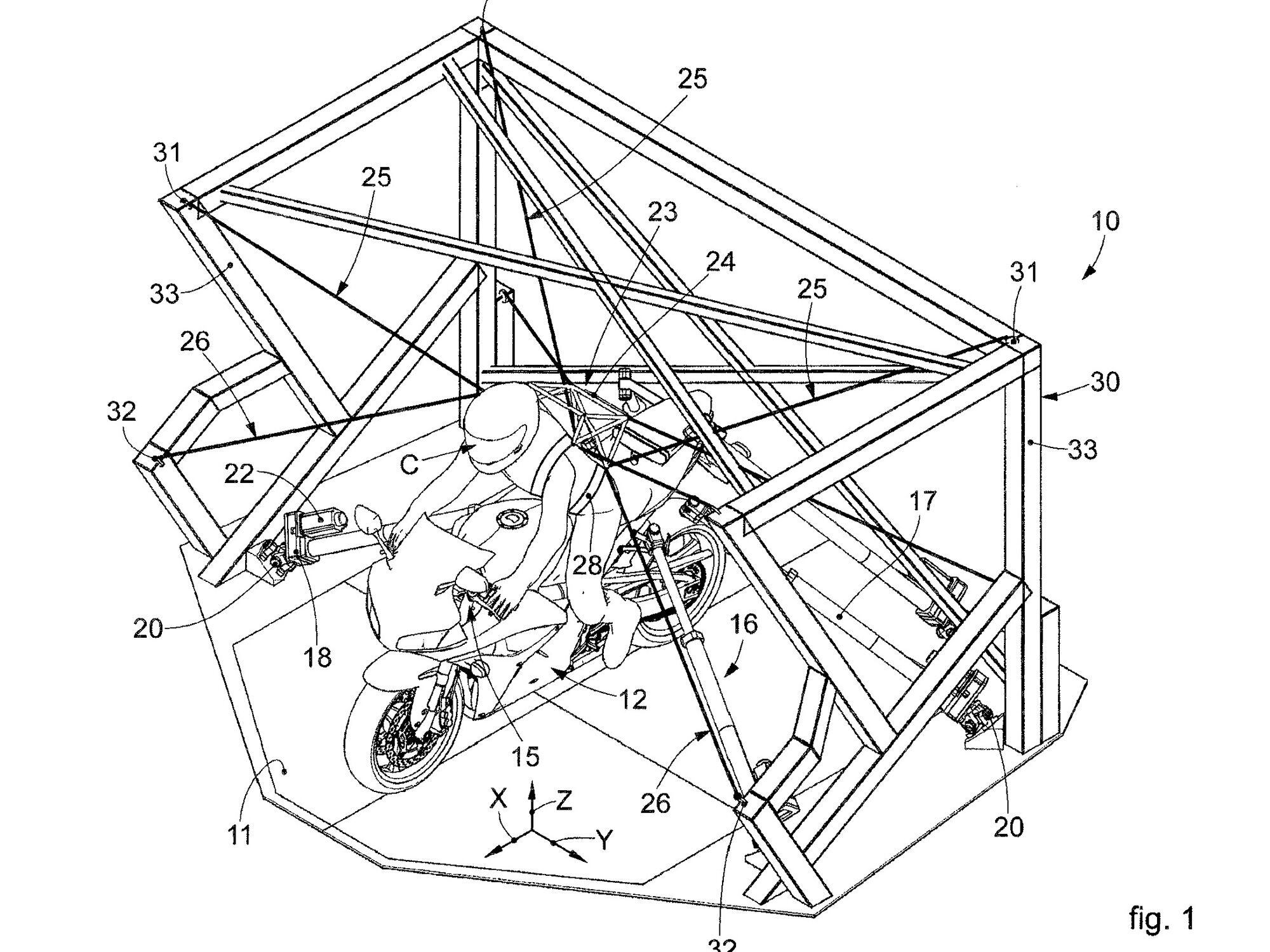
The patent application shows how forces are introduced onto the rider using a frame attached to the rider’s back. (German Patent Office/)On a normal motorcycle simulator, the bike (or a representation of the bike—often just a seat, tank, and bars) is fitted onto a moving platform that allows it to pitch, lean, and yaw in harmony with the image projected onto a huge, curved screen ahead of the rider. Although mostly convincing in the lean angles they’re able to achieve, these simulators alone can’t accurately replicate the inertia of the rider—the push backward as you accelerate, or forward under braking—and mimicking the centrifugal forces that push you into the seat as you’re banked in a corner is an even more difficult challenge.
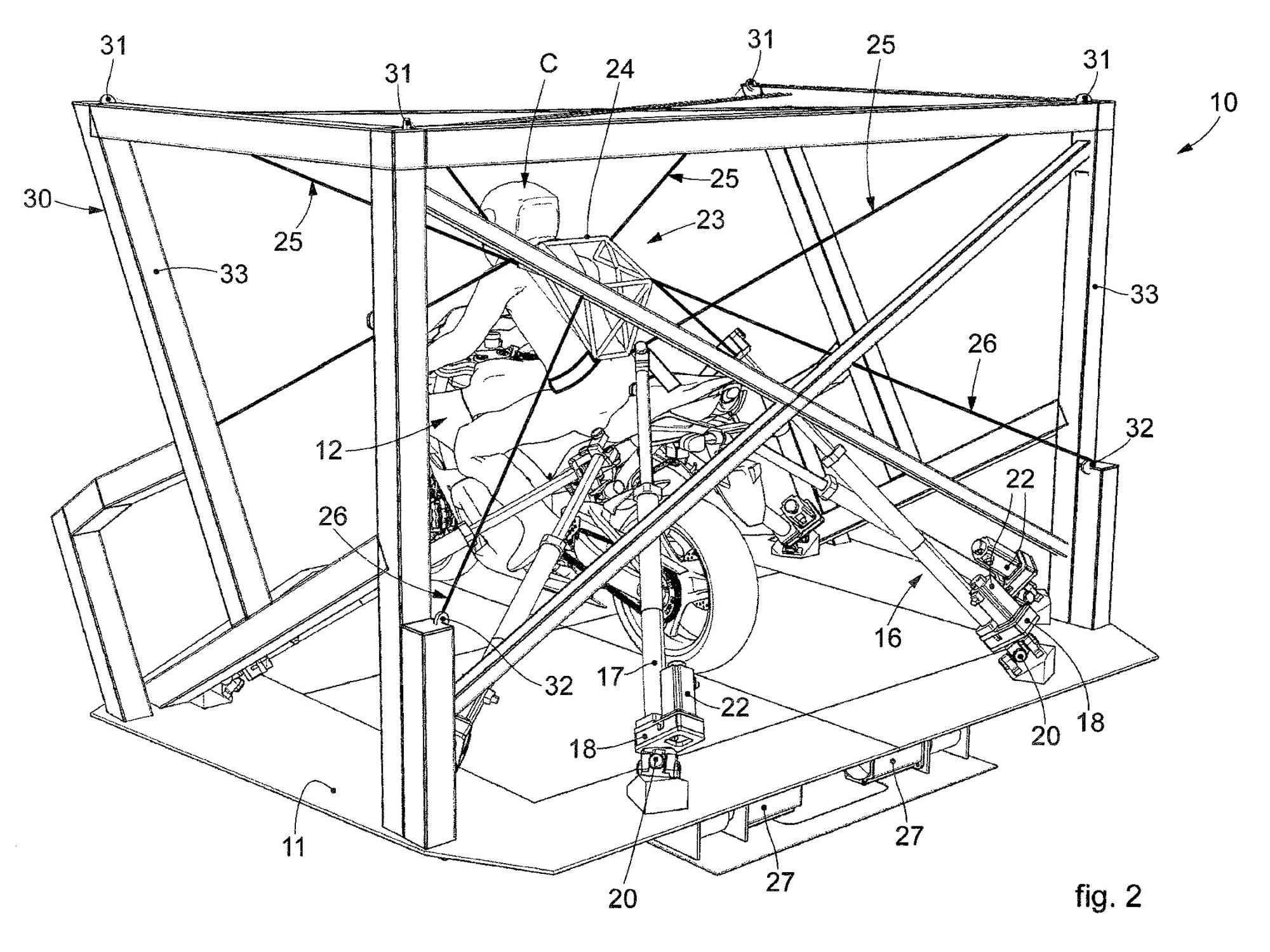
Actuator-operated cords attached to the frame mimic the pulling and pushing action of braking and acceleration forces to give a more real-world experience. (German Patent Office/)This new design, revealed in a patent application from German simulator specialist VI-grade GmbH, shows a simulator rig that solves the key problem of introducing forces to the rider as well as the bike. It uses a real motorcycle mounted on six hydraulic ramps that match its lean angle, pitch, and yaw to the inputs from the controls. That’s fairly conventional, but what’s new is the frame strapped to the rider’s back that’s attached to eight cords, each able to pull the rider in a different direction using actuators mounted under the simulator platform. Used in different combinations, the pulling action on these cords can simulate acceleration, braking, and cornering forces on the rider to give a more realistic riding experience.
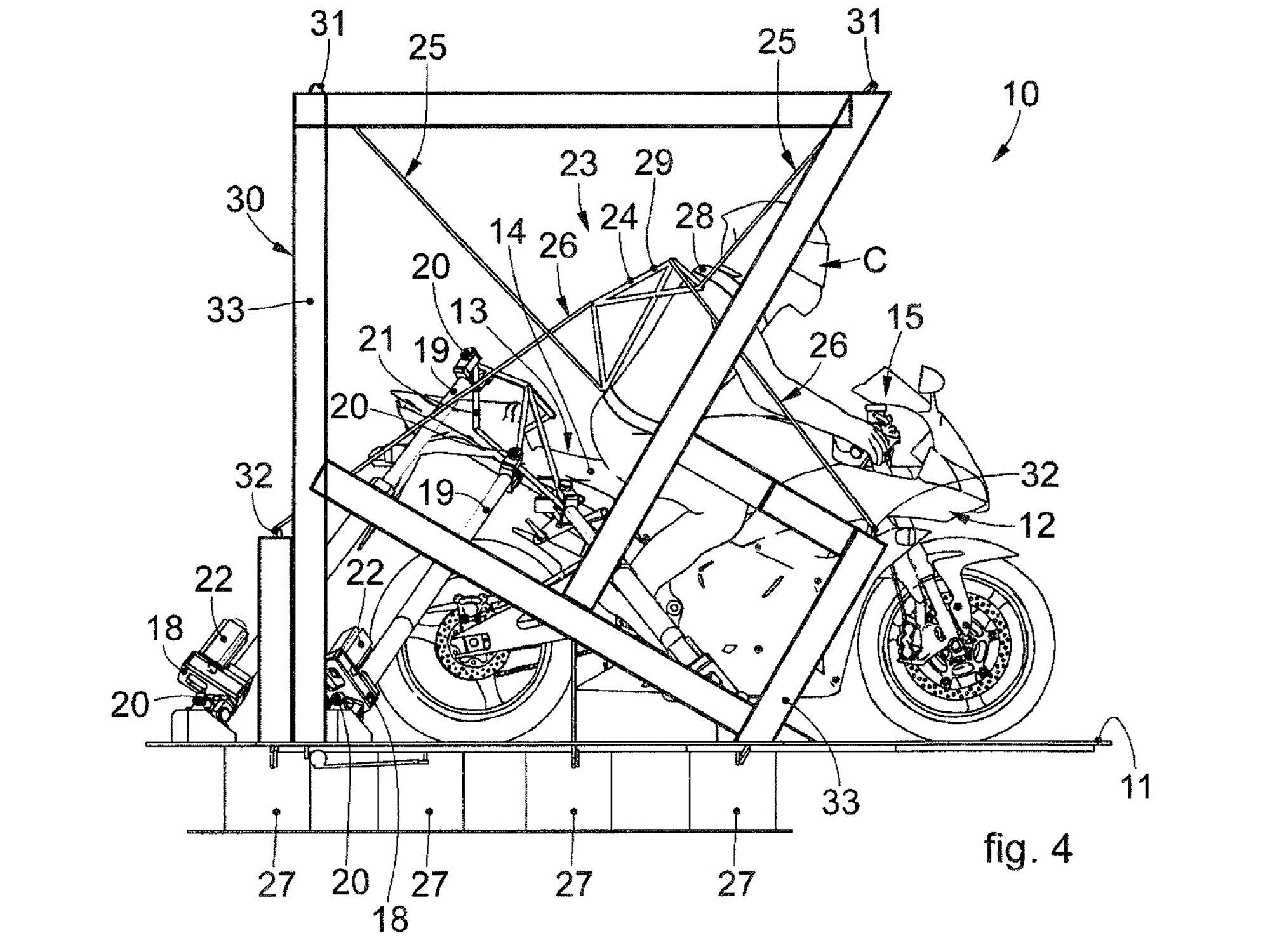
Simulators like this can be a boon for race teams testing out new bike setups or looking to replicate different environmental conditions. (German Patent Office/)What’s the point of a simulator like this? For a bike manufacturer it means it’s possible to run computer simulations of designs and setups across a variety of surfaces and weather conditions without having to ship prototypes around the world or wait for the right conditions for a test. While practical, real-world tests are still vital, simulations can reduce the number of them that are needed by eliminating development dead ends before expensive and time-consuming real-life testing starts.
There’s also a potential market for these types of simulators to help race teams train their riders and run computer simulations of bike setups and new components. Simulation is already a vastly important part of F1 racing, where rules mean real track testing time is severely limited, and every team on the grid has at least one ultra-realistic simulator running back at their base. VI-grade’s simulator patent appears to offer the same possibilities for bikes.
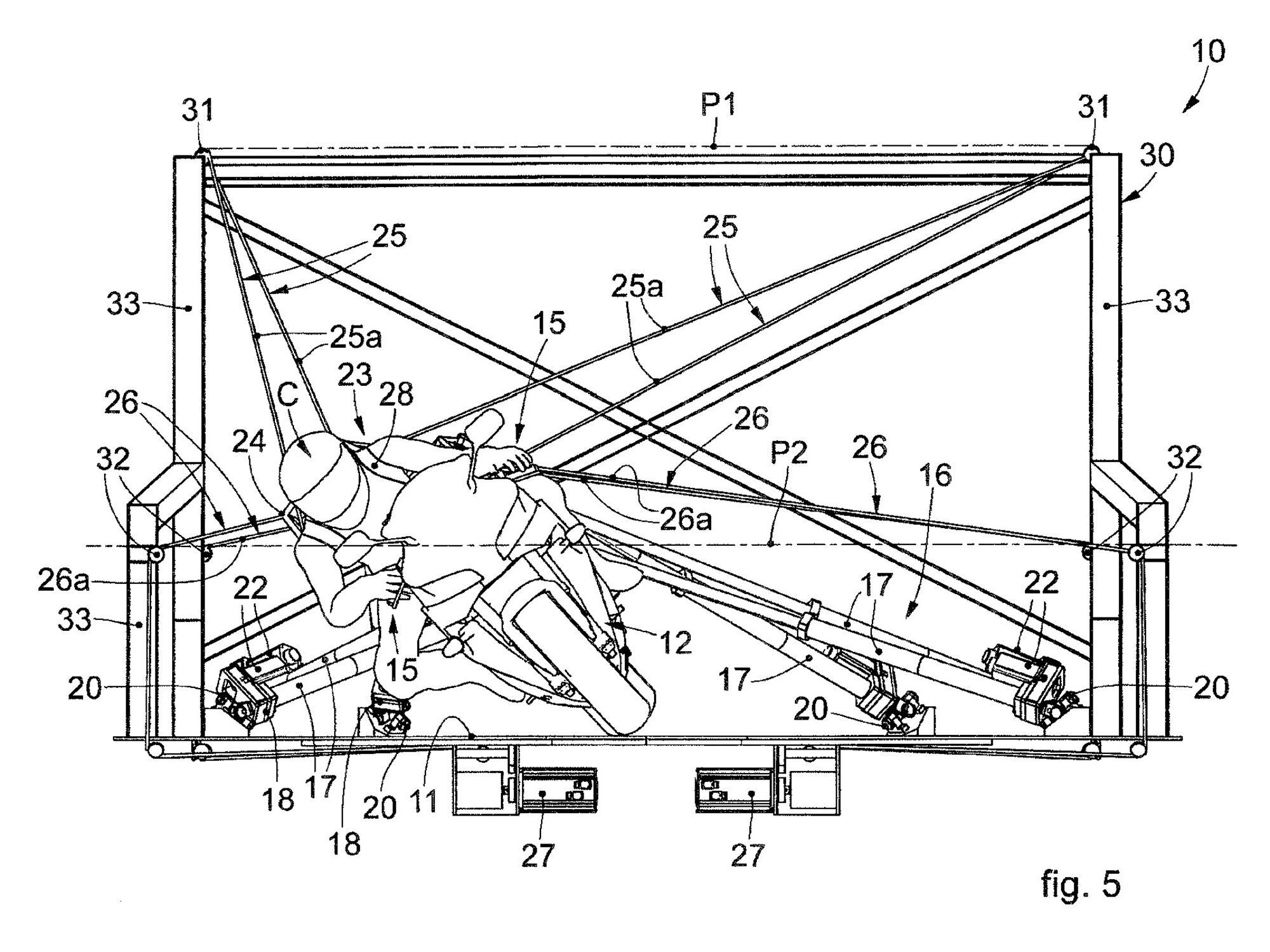
This particular simulator uses a full-size motorcycle mounted on hydraulic ramps to lend a more immersive quality to the setup. (German Patent Office/)The German firm isn’t the first to try to simulate forces on riders. McLaren Applied Technologies, which is an engineering arm of the same McLaren that races in F1 and builds supercars, filed patents for a similar idea back in 2016, using actuators pulling strings attached to different parts of a rider’s suit and helmet to copy the forces felt during riding, though unlike the new VI-grade design it didn’t also use a complete, full-size motorcycle.
-
 1
1
-
-
Hello Rossco84,
Welcome to The Motorbike Forum. Please feel free to browse around and get to know the others. If you have any questions please don't hesitate to ask.
Why not tell us a bit about yourself too.
-
-
-
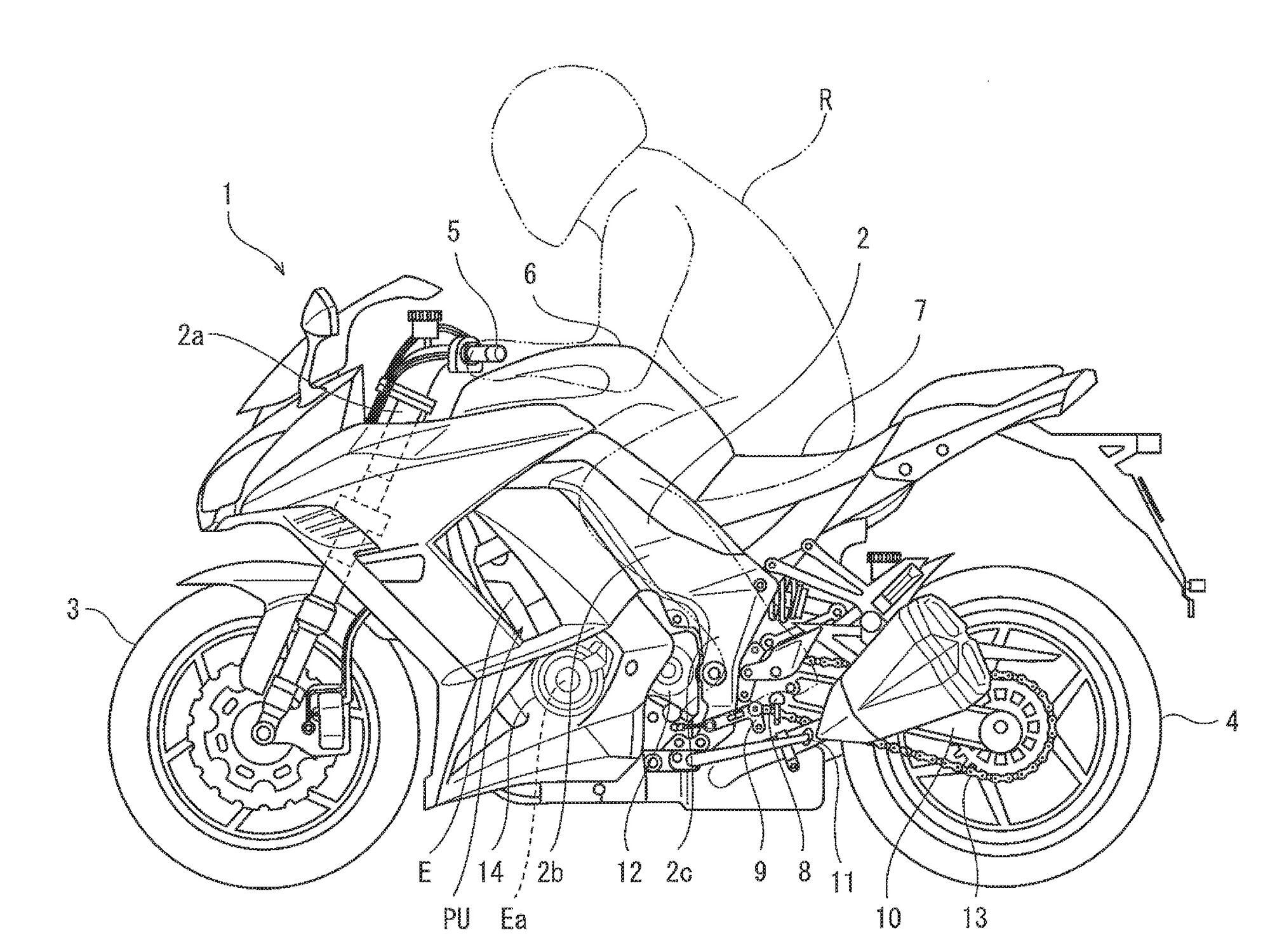
Kawasaki has published a new patent showing development of a semi-automatic transmission. (Japanese Patent Office/)A new patent has surfaced showing that Kawasaki has started to develop an electronically shifted transmission that might well be destined for a touring bike to replace its aging Concours 14 model, but could also benefit superbikes or even cruisers in the future. Semi-auto boxes have long been on the verge of widespread acceptance, with Honda finding success with its DCT dual-clutch transmissions since 2009 and Yamaha offering its FJR1300 with the YCC-S auto-shifting system as early as 2006. Now Kawasaki looks like it’s finally working on its own.
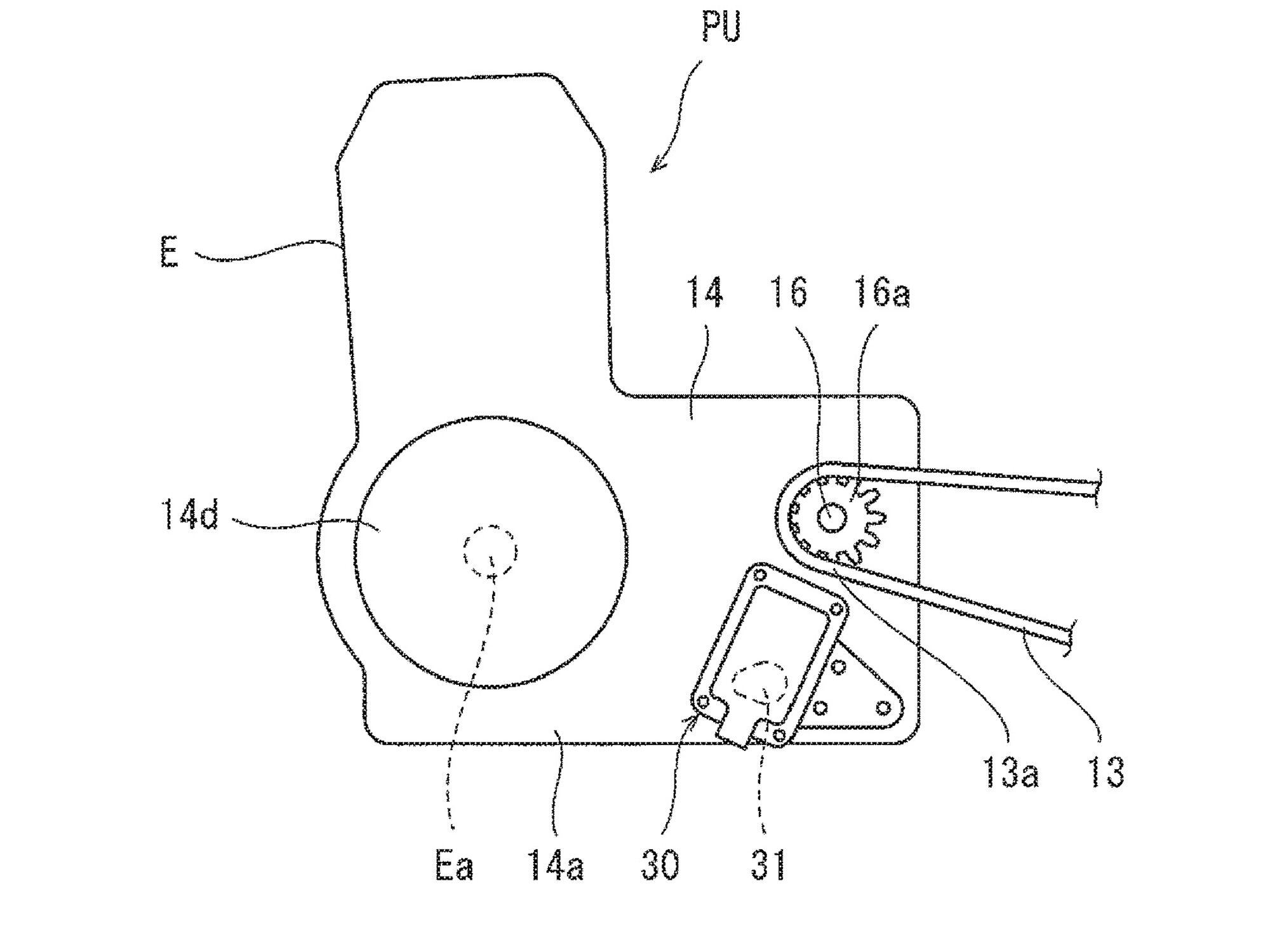
The design focuses on using a simple electronic shift mechanism that obviates the need for a physical link. (Japanese Patent Office/)The Kawasaki system appears to be aimed at replicating the conventional gear-shifting experience when required, keeping the foot-operated lever but using an electronic actuator and sensors instead of a physical linkage between your left foot and the shift drum. The firm’s new patent uses the outline of a Ninja 1000 SX to illustrate its idea, but that doesn’t mean it’s the machine that will eventually benefit from the technology. In fact, despite the patent being newly published, with its original Japanese submission dating back to July 2019, the bike used for the illustration is the first-generation Ninja 1000 SX that was revealed back in 2010. It’s been updated and restyled twice since then, so the patent picture is almost certainly just a placeholder to ensure the design doesn’t give away any more secrets than absolutely necessary.
The patent focuses instead on a compact and simple electronic shift mechanism that translates the movement of the gear lever into a rotation of the shift drum. It means there’s no longer a need for a physical linkage, freeing up the bike’s packaging to allow the footpegs to be moved without having to worry about how the shifter will be operated. Whether you’ve got rearsets or highway pegs, the design means you only need an electric wire to connect the lever to the transmission.
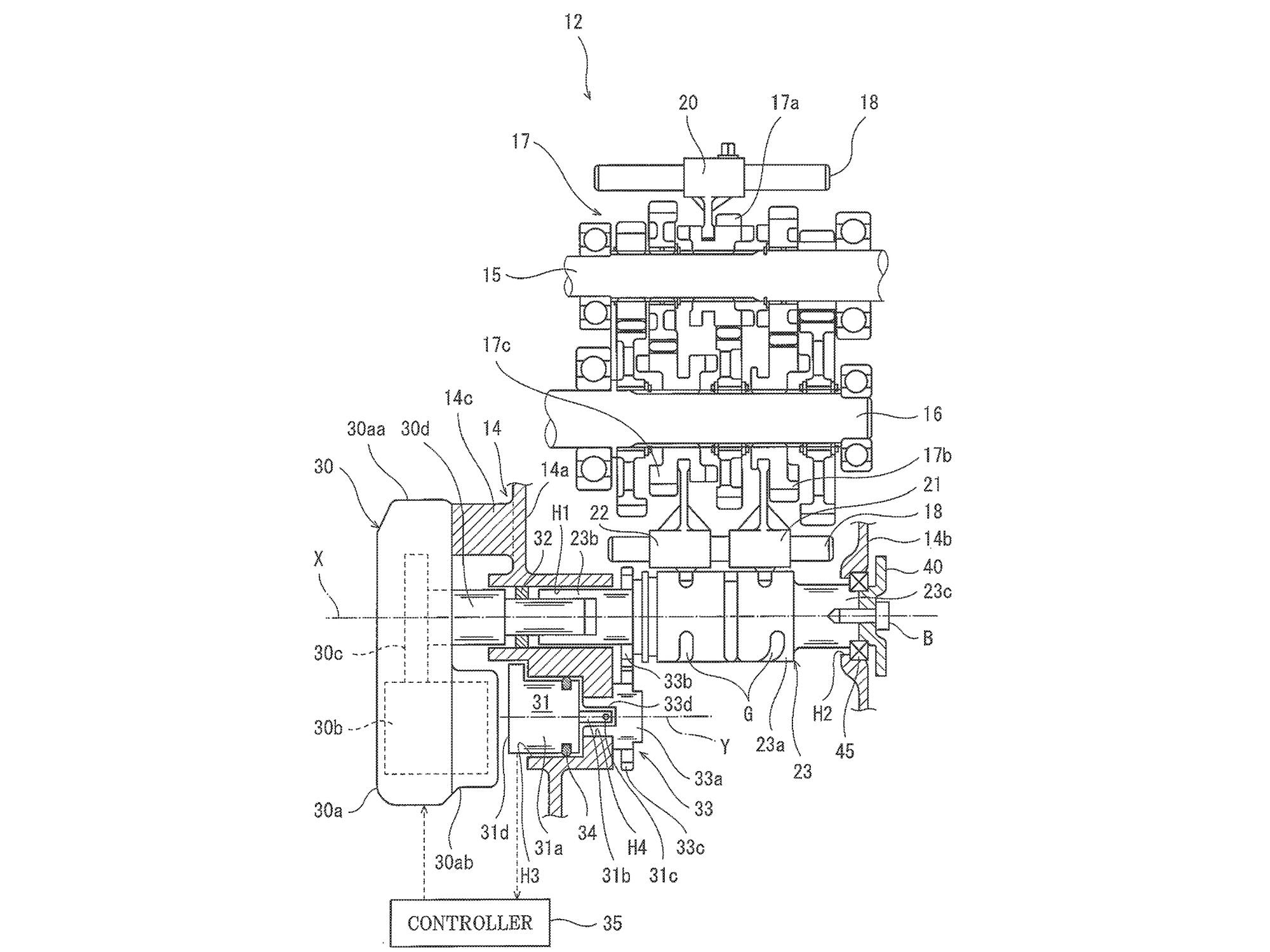
The electronic actuator would rotate the shift drum on a conventional transmission and could be adapted to a variety of different bikes. (Japanese Patent Office/)With an actuator rotating the shift drum on the otherwise-conventional transmission, it’s easy to see how the system could be used on any number of bikes. Swapping the foot-operated lever for bar-mounted buttons would be simplicity itself, and with a computer between the rider and the gearshift it would be easy to make sure that false neutrals, over-revving, and mistimed gear changes were avoided. On sportbikes, the system would be able to do the same job as a quickshifter but potentially change ratios faster than your foot can move, tying in with the engine electronics to make sure that the revs are matched perfectly. Alternatively, it could easily be allied to an automated clutch for a fully or semi-auto transmission.
Where will the system appear first? That’s a tough call, but Kawasaki is known to be developing a new model with the Bosch radar-assisted cruise control system that’s already appeared on Ducati’s Multistrada V4 and BMW’s 2021 R 1250 RT. A tourer or adventure-tourer would be the most obvious recipient of such technology, and a long-distance machine like that might also be the ideal starting point for an electronically shifted gearbox.
-
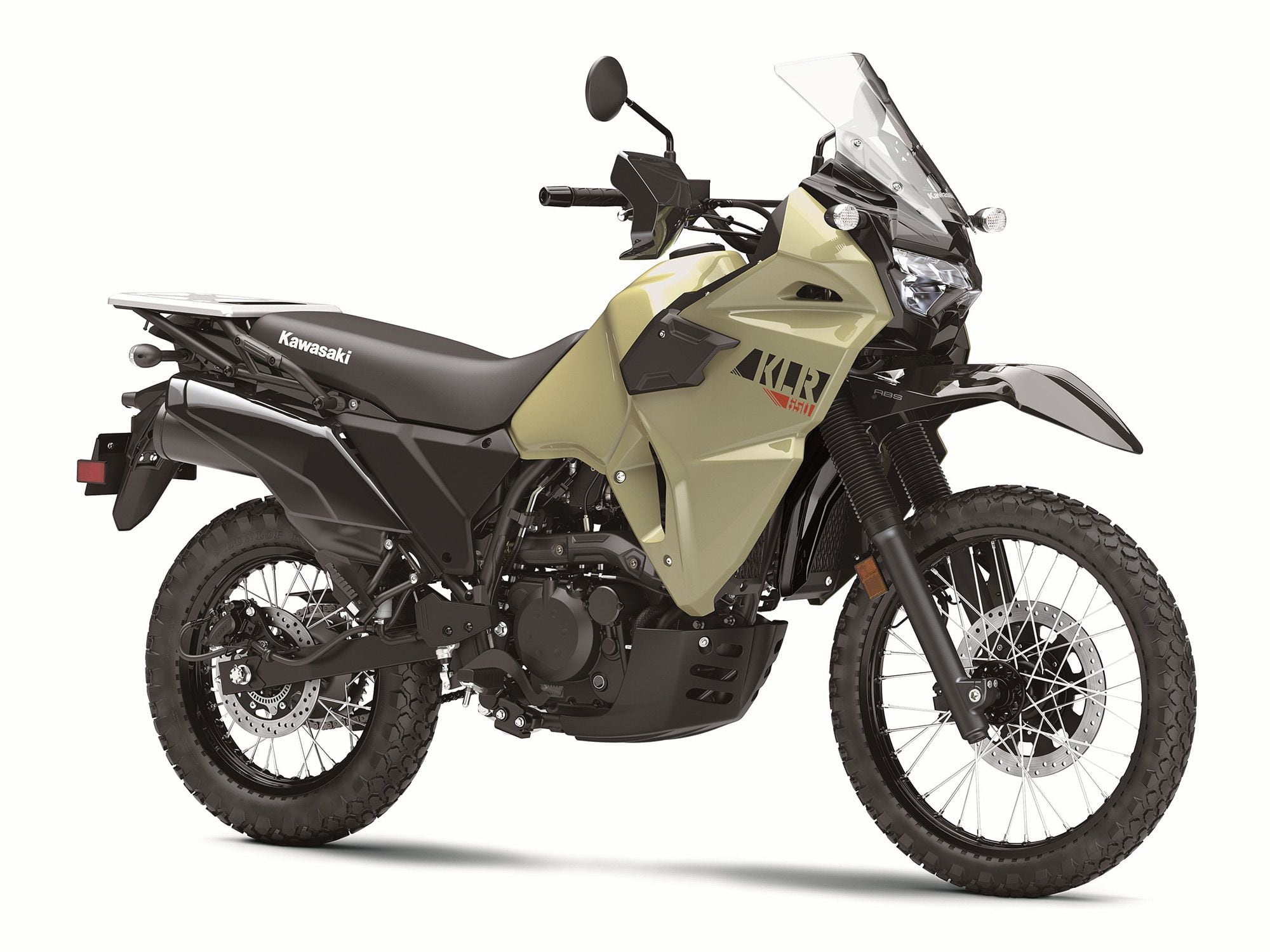
The KLR650 is back, with fuel injection, stiffer suspension, optional ABS, and a better doohickey! (Kawasaki/)This year might have gotten off to a shaky start, but 2021 has redeemed itself. After a two-year sabbatical, Kawasaki dropped the news: the KLR650, king of the KISS (Keep It Simple, Stupid) ADVs, is back. And at first glance, the bike thrifty backcountry explorers love most appears to be blissfully unadulterated. Sure, the list of new-for-2022 features is pretty long, but wisely enough, Kawi seems to have addressed many of the affectionate grumbles aimed at the previous version while maintaining its bare-bones “I’ll take you wherever you want to go as long as you don’t mind if it takes a while” personality.
Rather than, say, shoehorning in the parallel twin from the Versys 650, for example, Kawasaki simply added DFI fuel injection to the previous model’s tried-and-true 652cc liquid-cooled single. Kawi also made a few tweaks it says boosts midrange torque, such as revised intake and exhaust cams and a narrower exhaust pipe with smoother bends. A certain portion of KLR Nation (you know who you are) should warm up their “back in my day” stories, as Kawi also seems to have fixed The Doohickey; the cam chain guide is said to be stronger, made from new materials and with a new shape.
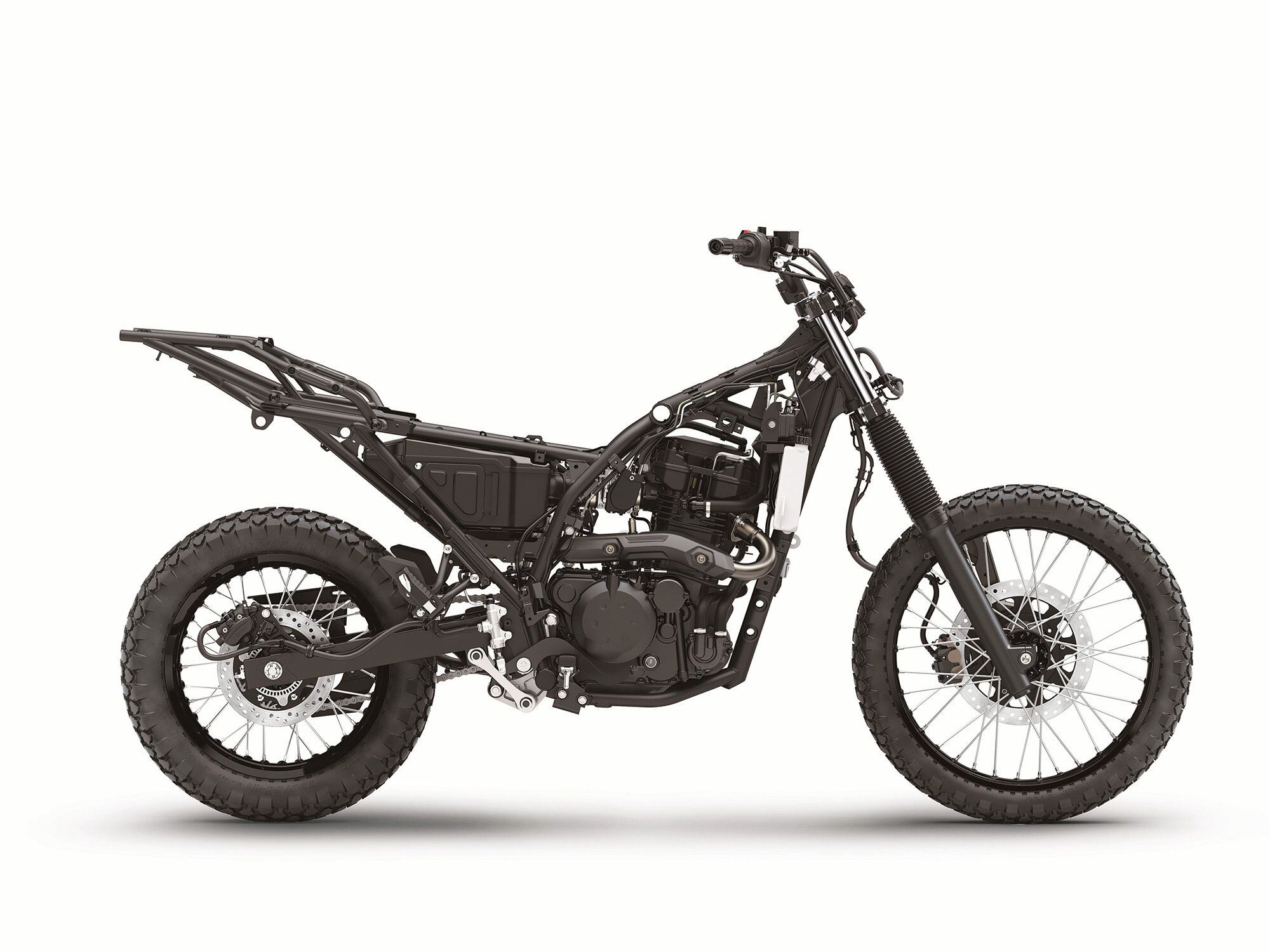
Tensile steel frame now includes an integrated rear subframe, while a 30mm longer swingarm adds on-road stability. (Kawasaki/)The KLR’s gearbox is still stuck with just five gears. But revised 3rd gear dogs, a new finishing process on the 4th and 5th gears, and new thrust needle clutch release bearings should make things a bit smoother and more robust in demanding riding conditions. Speaking of which, suspension both fore and aft is stiffer, the 300mm single front brake disc is 20mm larger than before, and the 240mm rear disc is 1mm thicker for better heat dissipation.
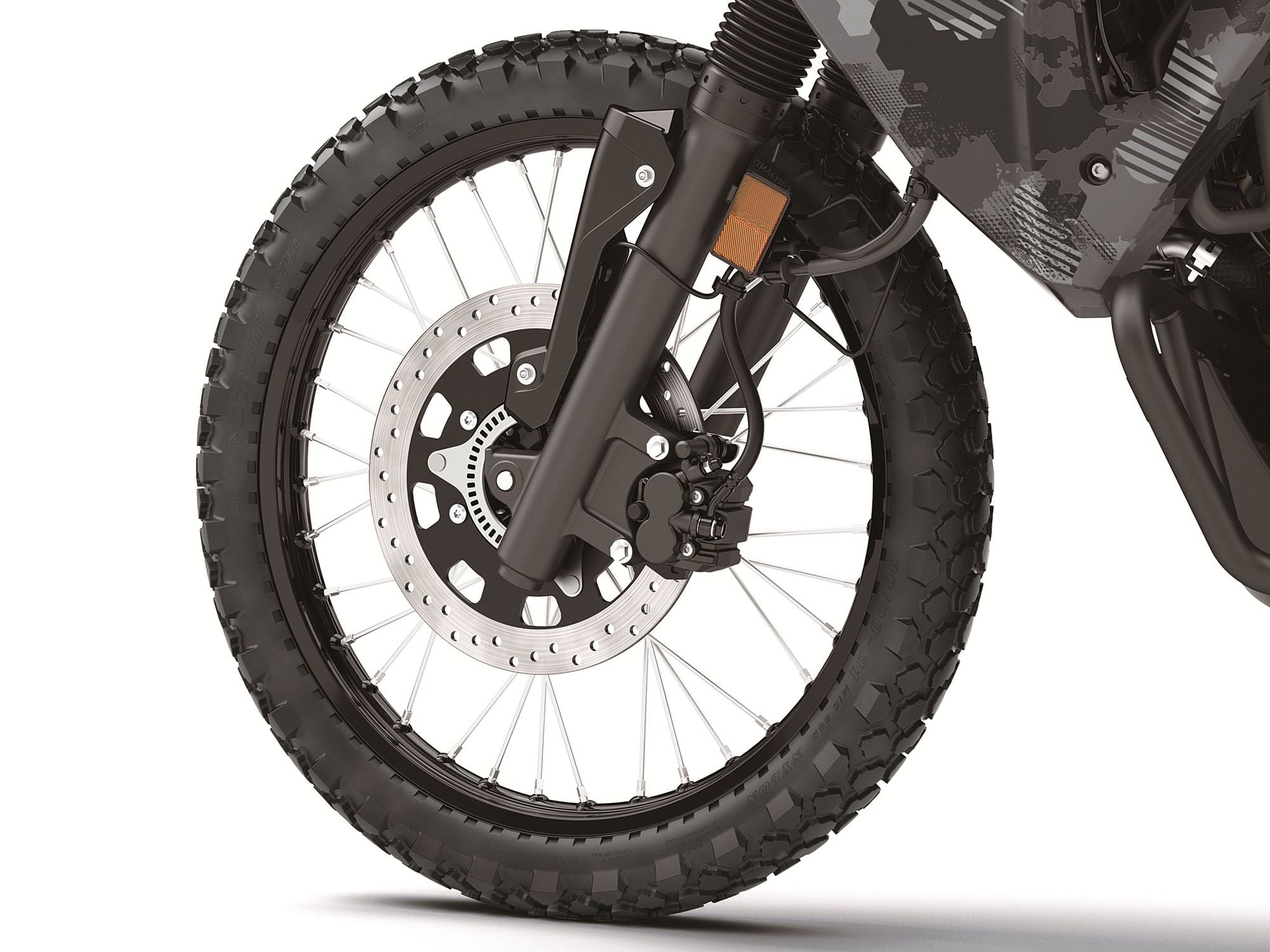
Brakes on the previous KLR650 were a weak point; a larger 300mm front disc with optional ABS should help. (Kawasaki/)New “Dual Purpose ABS,” developed in partnership with Bosch, allows for some wheel slippage; Kawasaki says that this results in a natural braking feel off-road, while the on-road feel is “like normal ABS with a less sensitive setting.” It’s unclear whether ABS is switchable, but purists can rejoice, as it’s optional on the standard KLR650.
Black rims holding tube-type tires are said to be stronger than before, with larger axles. The swingarm is 30mm longer with a 2mm-longer pivot shaft, improving the KLR’s stability and highway road manners. Footpegs are pushed out 10mm to match the 10mm-wider handlebar, and both are rubber mounted for buzz-free comfort on those long slogs in between the dirty bits.
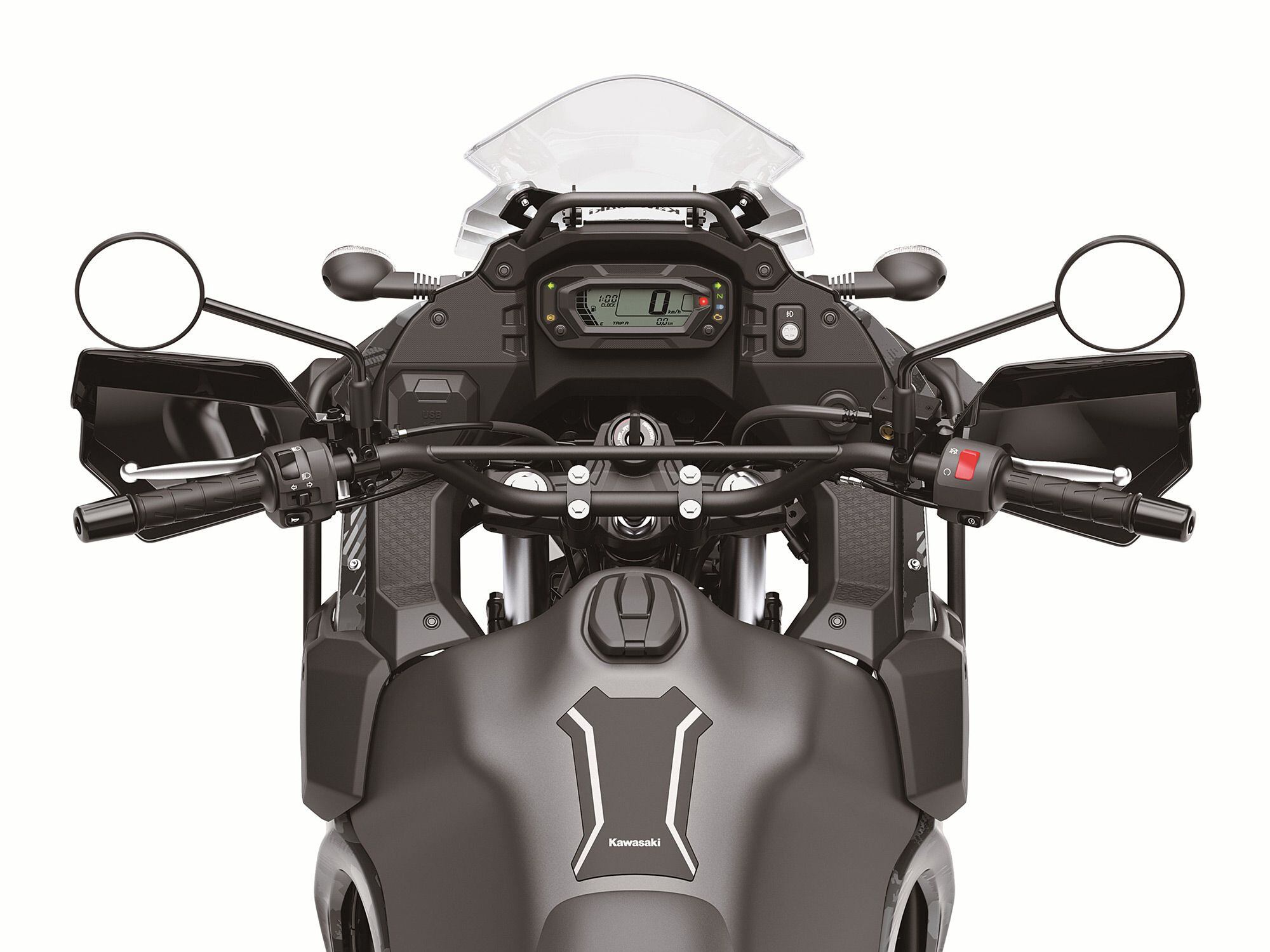
The 2022 KLR’s cockpit: a new LCD instrument, wider, rubber-mounted handlebar, wider mirrors, a taller, two-position adjustable windscreen, an integrated accessory mounting bar, and two optional power sockets (standard on the Adventure and Traveler models. (Kawasaki/)At its core, however, the KLR is still a no-frills adventurer. Despite its new LED headlight and pumped up generator, the 2022 KLR650 still only manages 80 watts of available power for accessories like heated grips and a GPS. Its 6.1-gallon fuel tank, reshaped for a comfortable fit between the knees, will carry you well off the beaten path, and the new LCD instrument includes a gas gauge in addition to two tripmeters and a clock, but no tachometer.
There will be two standard 2022 KLR650 models, one with ABS and one without, as well as two travel-ready models, the KLR650 Adventure and the KLR650 Traveler. The Adventure comes equipped with a set of 21-liter hard plastic top-loading side cases by Shad; LED auxiliary lights; engine guards; and two power sockets, one standard cigarette lighter adaptor and one USB. The Traveler comes with two power sockets and a 42-liter plastic Shad top case large enough to fit an off-road style helmet.
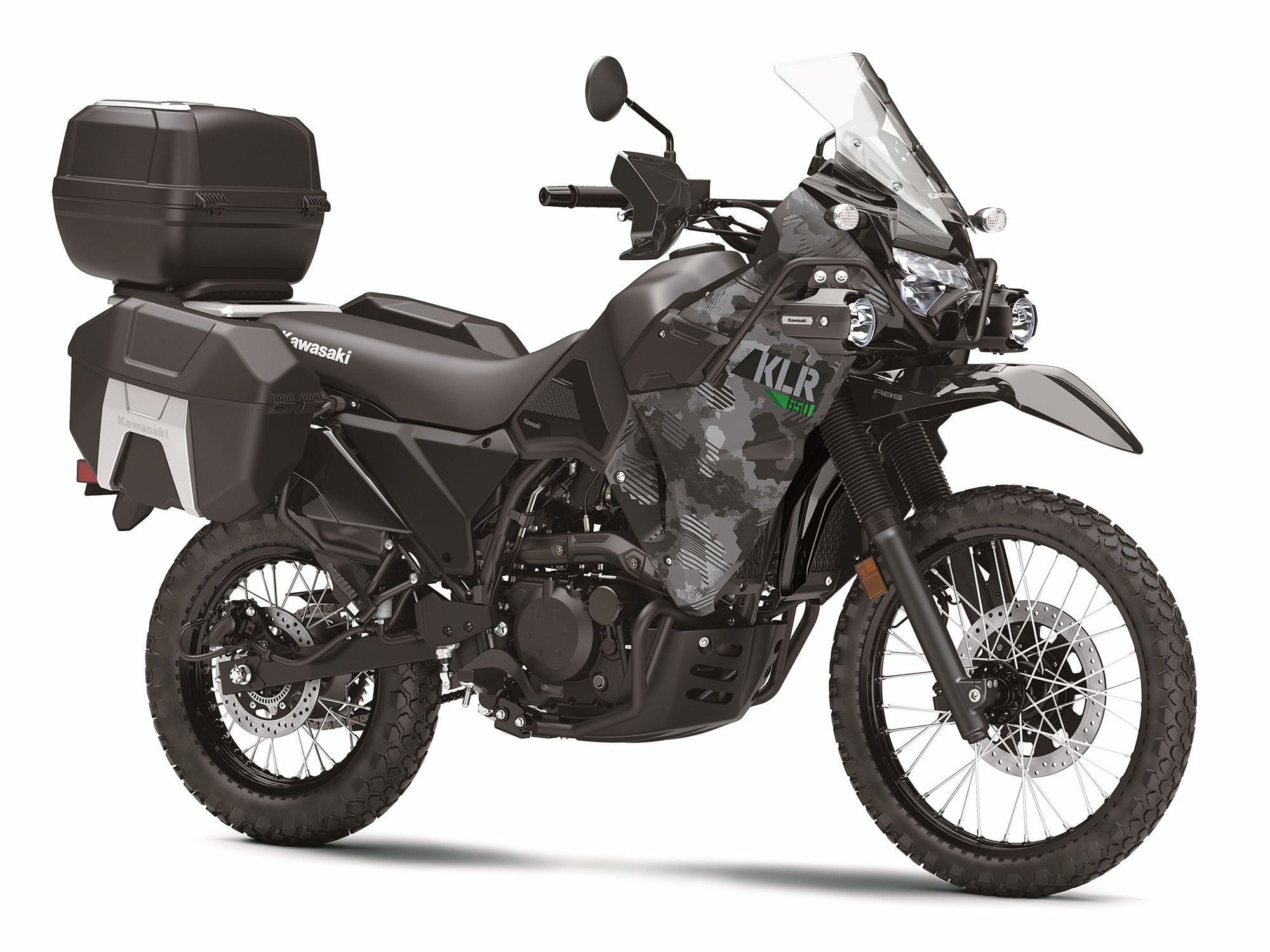
The 2022 KLR650 Adventurer (shown in Cypher Camo Gray) comes with engine guards, auxiliary lights, and Shad side cases. Shad top case is standard on the KLR650 Traveler model. (Kawasaki/)At $6,699 for the non-ABS model, $6,999 with ABS, and $7,399 for the Traveler, Kawasaki has managed to hold true to one of the most endearing aspects of the KLR650′s personality: a reasonable pricetag. As an avowed KLR-ista (mine was a 2009), 2021 has given me something—and somewhere—to look forward to.
-
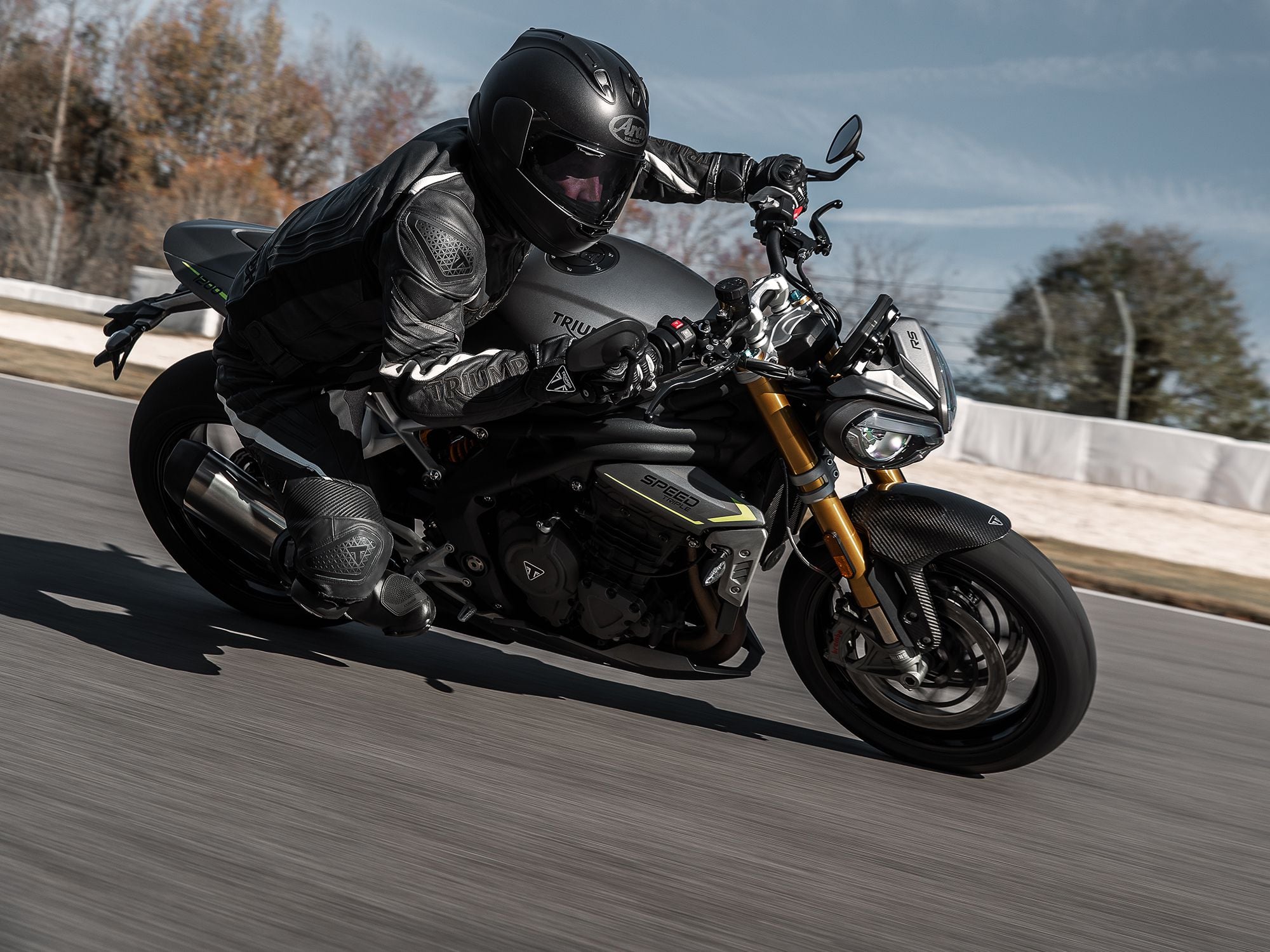
The addition of 30 hp on the 2021 Speed Triple 1200 RS is one element of what Triumph calls “the best Speed Triple Triumph has ever built.” (Triumph/)“This is more of a Speed Triple revolution than an evolution,” says Stuart Wood, chief engineer at Triumph Motorcycles. “It’s the best Speed Triple Triumph has ever built.” Amusingly, that last bit is also what was said about the previous Speed Triple, and you’d hope so too. Why build a new one that wasn’t as good? Mr. Wood is simply emphasizing just how far the Triumph engineers have been able to move the performance for this model.
The numbers alone are impressive, with the new 1,160cc motor pushing out a claimed 180 hp and curb weight down 22 pounds, to 437. That increase in performance has come from a ground-up redesign of the engine, incorporating a new stacked gearbox, increasing displacement, and reducing inertia throughout. The new gearbox has allowed Triumph to include a two-way quickshifter, the first one on a Speed Triple. Other than the quickshifter, the outgoing Speed Triple RS was already very well spec’d, and its Öhlins suspension, keyless ignition, five ride modes, IMU-powered (Inertial Measurement Unit) ABS, and Traction Control are all carried over, obviously recalibrated to suit the new bike. Other new features are an updated 5-inch TFT dash and the latest Brembo Stylema brake calipers.
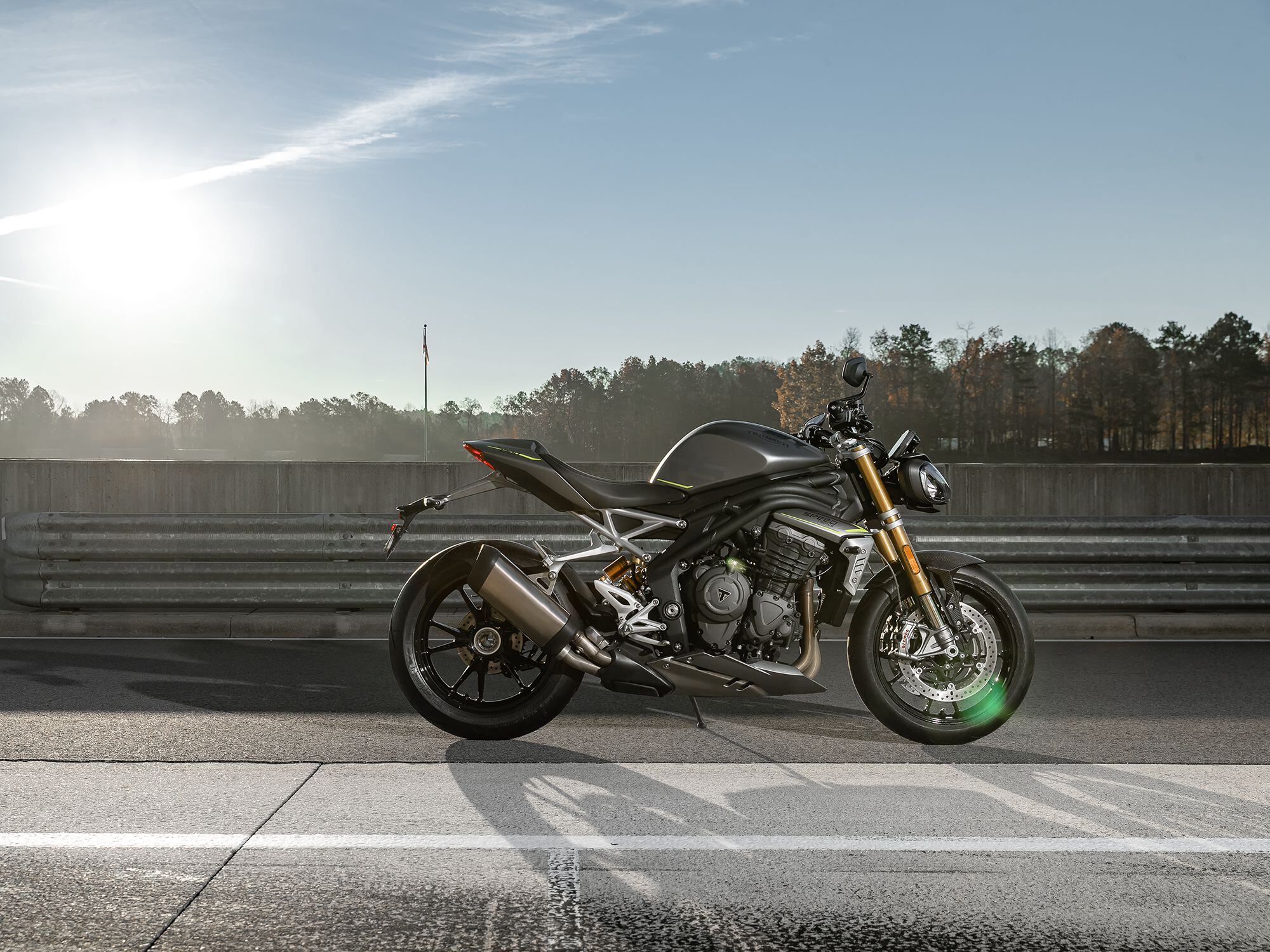
Triumph has increased power but also trimmed weight on the 2021 Speed Triple 1200 RS. (Triumph/)In the flesh, the new Speed Triple RS is a beautiful thing, a clean, purposeful shape covered in classy finishes. Where other manufacturers are adding winglets and jabby bits of bodywork, Triumph has kept the RS clean with the motor center stage, uncluttered by panels or pipework. The styling of the motor itself actually reminds us of the original Speed Triples with their cooling fins running along the sides of the cylinder block. In fact, stick the 1994 model and the 2021 bike side by side and there’s a strong family resemblance despite the quarter-century age gap.
What’s missing? Well, the twin underseat exhausts, something of a Speed Triple trademark on recent versions, are gone, casualties of the search for a more efficient system and of mass centralization to help the bike’s handling. However, Triumph is so confident in the sound and performance of the new exhaust system that it’s not even offering an accessory silencer. According to Wood, the whole engine has been designed to run more efficiently and cleanly, allowing it to meet emissions regulations without relying on a great big catalyst and silencer to clean everything up.
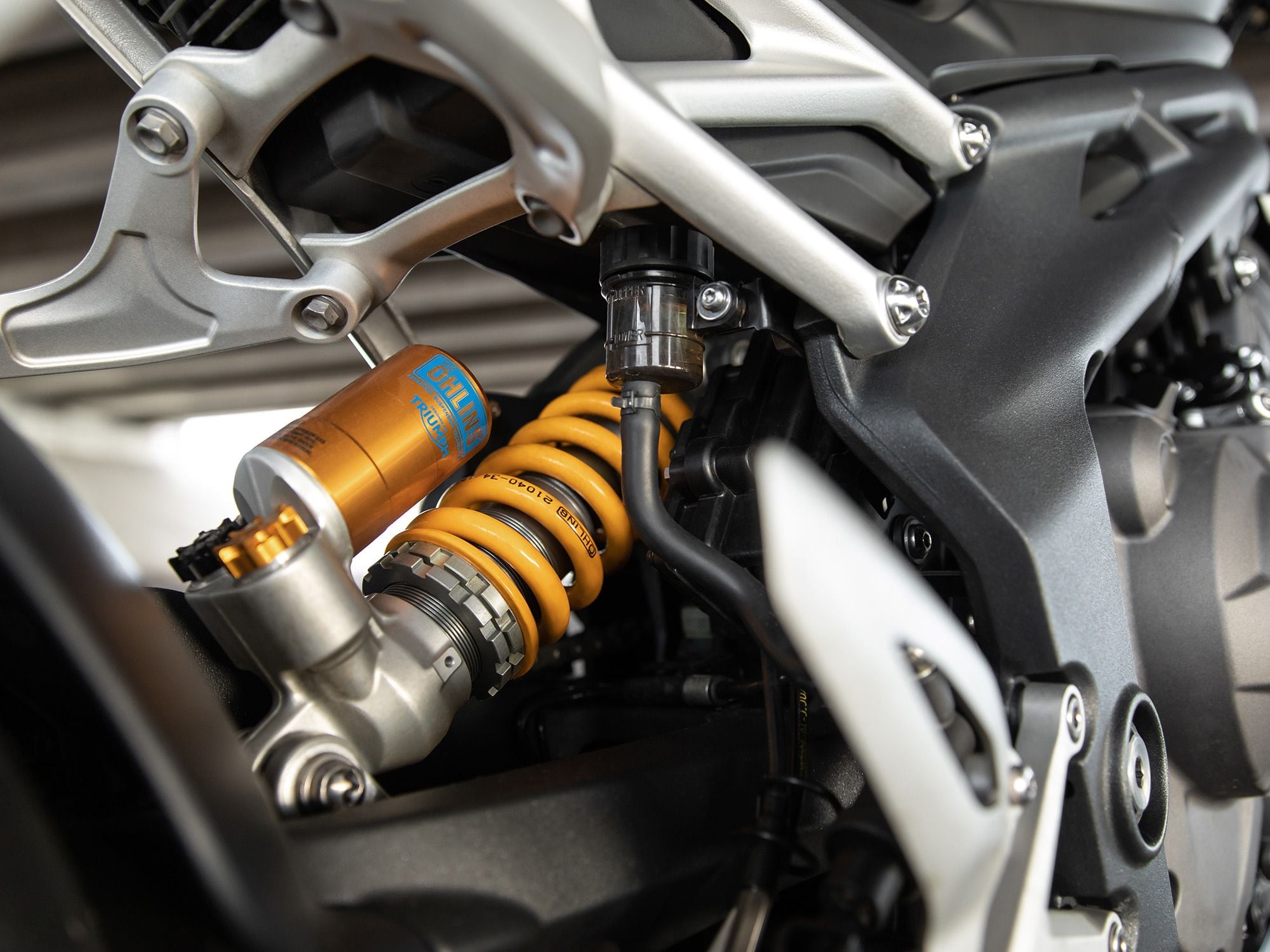
The 2021 Speed Triple 1200 is fit with Öhlins suspension. Triumph says it has no intention of offering any model other than the up-spec RS. (Triumph/)Before you panic over eco rules stealing all the fun from the bike, remember that power is still up 30 bhp; an efficient engine in terms of combustion performance is a faster engine. What this actually highlights is how the old engine, while still a great unit, was a design from a time with much less strict emissions rules, and getting a little long in the tooth besides.
One thing Triumph is always keen to point out, and rightly so, is the attention to detail that goes into the design of its unfaired bikes. A huge effort has been made to hide away hoses, cables, and connectors so the bike shows off its engine without looking cluttered and messy. Take a close look at the side images. Then do the same with other bikes in this class. You’ll see the difference. That won’t do anything for the power deficit versus the Ducati or KTM, but it does give the bike a classier, more finished look and feel.
What’s the catch? Maybe the price. Considering the spec, the outgoing bike was something of a bargain in the big naked bike sector at $16,500, but all this redesigning and updating has to be paid for somehow, with the new bike listing for $18,300. The price does reflect a decent increase in performance, as the new 1,160cc Speed Triple is now more on par with bikes like the KTM 1290 Super Duke R ($18,699).
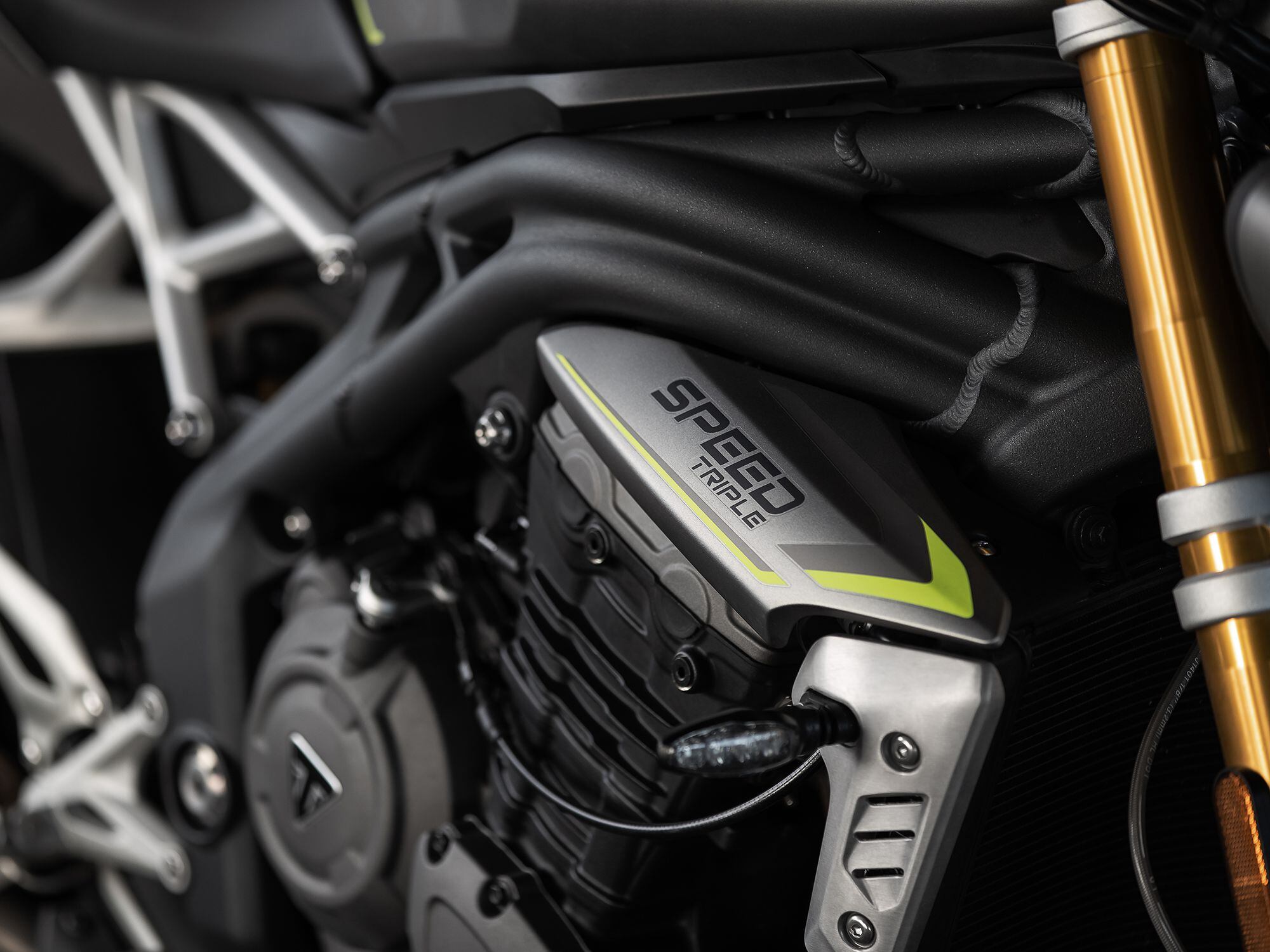
An additional 550cc along with reduced interia gives the 2021 Speed Triple 1200 RS a more responsive and powerful engine character. (Triumph/)At this price and power the new Speed Triple finds itself going bar to bar with the KTM 1290 Super Duke R, Ducati’s V4 Streetfighter, and Kawasaki’s Z H2. And then let’s not forget the 2021 BMW S 1000 R or Yamaha’s MT-10… The list of awesome supernaked bikes just keeps growing. The real measure will be, as always, in the riding; with so many bikes competing in this category, choice comes down to what suits you best.
During the Speed Triple unveil, we asked Chief Engineer Wood where the Triumph fits along that scale. He claims it hits the sweet spot somewhere in the middle: All the sweet and nimble handling we’ve come to expect of a Street Triple, but with vast reserves of power available when necessary. If Triumph has struck that balance as well as he suggests, the new Speed Triple RS will be a sublime roadbike. As launch activities are currently restricted, we’ll have to wait a little longer to see for ourselves. Going on first impressions, it’s worth waiting for.
2021 Triumph Speed Triple RS Specifications
MSRP: $18,300 Engine: 1,160cc, DOHC, liquid-cooled, inline 3-cylinder; 12-valve Bore x Stroke: 90.0 x 60.8mm Compression: 13.2:1 Maximum Power: 177.5 bhp @ 10,750 rpm (claimed) Maximum Torque: 92 lb.-ft. @ 9,000 rpm (claimed) Transmission/Final Drive: 6-speed/X-ring chain Fuel Delivery: Multipoint sequential electronic fuel injection w/ electronic throttle control Clutch: Wet, multiplate, slip and assist Frame: Aluminum twin spar, bolt-on aluminum rear subframe Front Suspension: Öhlins 43mm NIX 30 inverted fork, spring preload, rebound and compression damping adjustable; 4.7 in.120mm travel Rear Suspension: Öhlins TTX 36 twin-tube monoshock, spring preload, rebound and compression damping adjustable; 4.7 in.120mm travel Front Brakes: Brembo Stylema monobloc calipers, 320mm floating discs w/ OC-ABS adjustable. Rear Brakes: Brembo twin piston caliper, 220mm disc w/ OC-ABS Wheels, Front/Rear: Cast aluminum; 17 x 3.50 in. / 17 x 6.00 in. Tires, Front/Rear: Metzeler Racetec RR K3; 120/70ZR-17 / 190/55ZR-17 Rake/Trail: 23.9°/4.1 in. Wheelbase: 56.9 in. Seat Height: 32.7 in. Claimed Wet Weight: 437 lb. Fuel Capacity: 4.1 gal. Contact: triumphmotorcycles.com -
 1
1
-
-
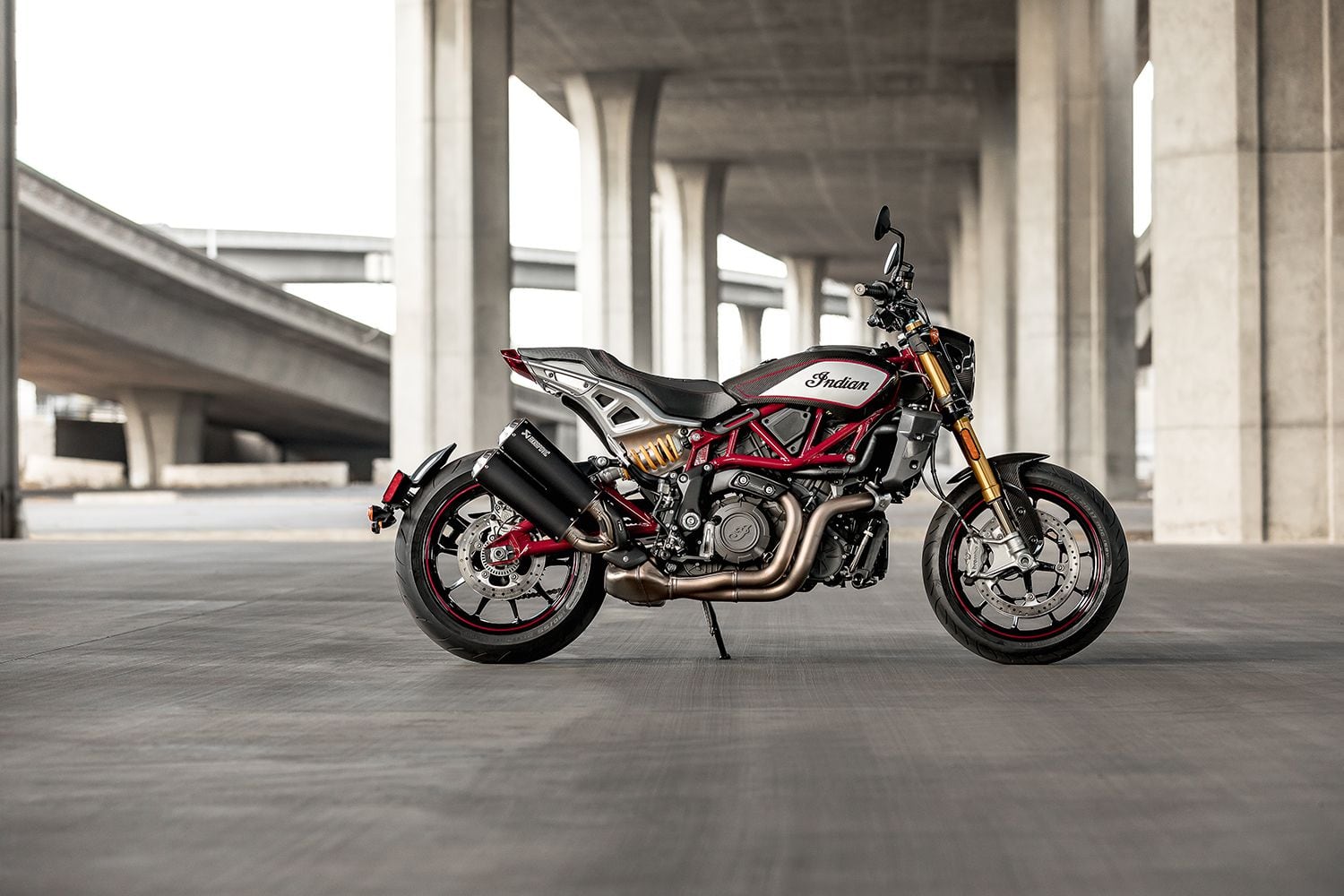
Indian FTR R Carbon replaces the previous FTR1200 R and FTR Carbon models, with an MSRP of $17,000. (Indian Motorcycle/)In 2019, Indian Motorcycle released the FTR1200 models, which were inspired by the company’s winning FTR750 flat-track racer. Cycle World Editor-in-Chief Mark Hoyer said the bike signaled “a new era for American street standards,” combining the endearing elements we associate with American cruisers and sporty street trackers to achieve a riding experience that is “purely good-time oriented.” Now, for 2022 (yes, you read that correctly), Indian is updating the platform, moving all models except the Rally away from the scrambler genre and toward a more functional on-road design equipped with 17-inch wheels, a lower seat height, and updated engine tune optimized for street performance.
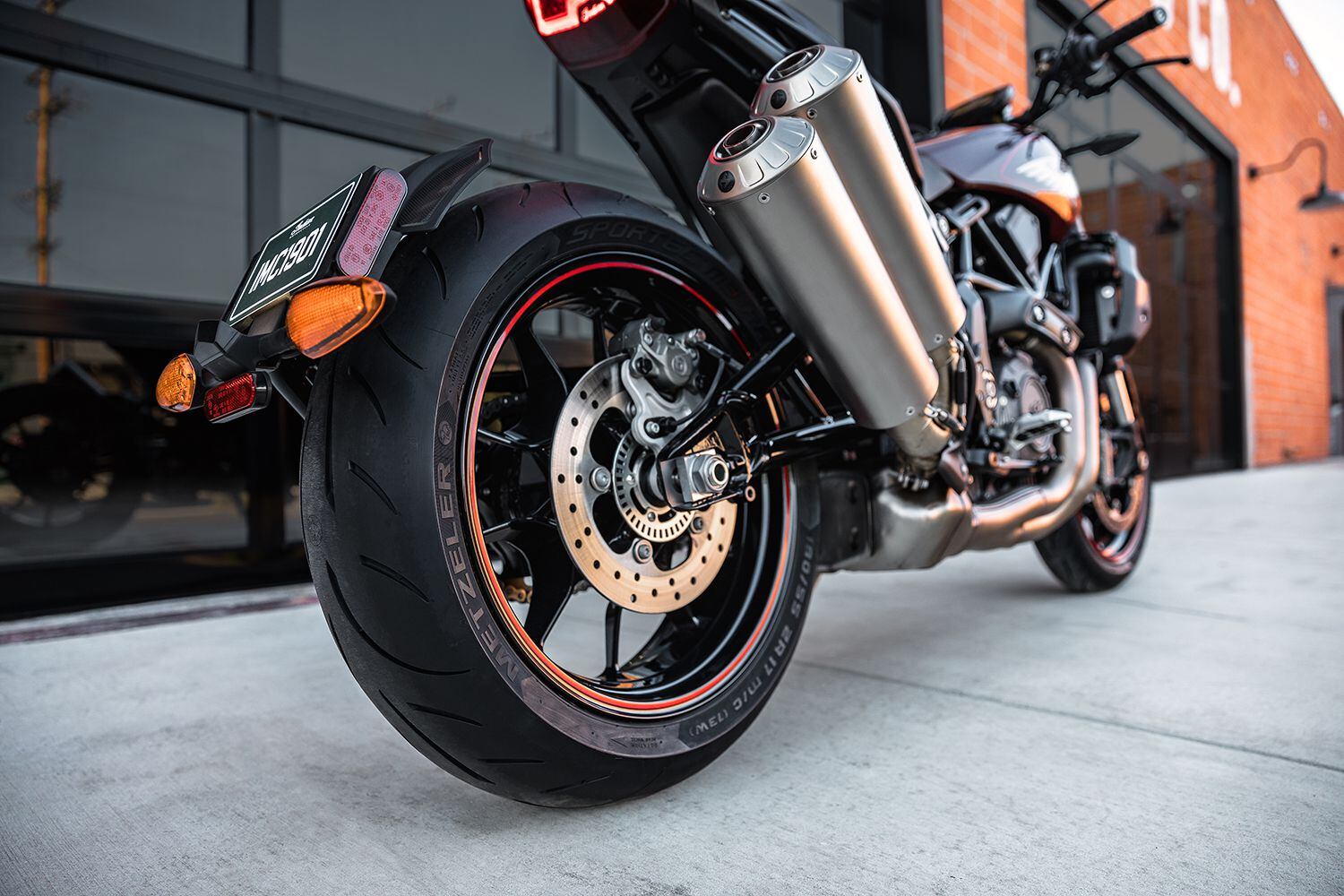
Metzeler Sportec tires wrap around cast-aluminum 17-inch wheels on the FTR, FTR S, and FTR R Carbon. (Indian Motorcycle/)Why 2022? The FTR1200 models currently being sold are model year 2019, while FTR Rally and Carbon models now in dealerships are both 2020. So while the bikes we’re looking at today will be in dealerships in spring of 2021, Indian has decided to skip model year 2021 altogether and call this whole updated lineup 2022.
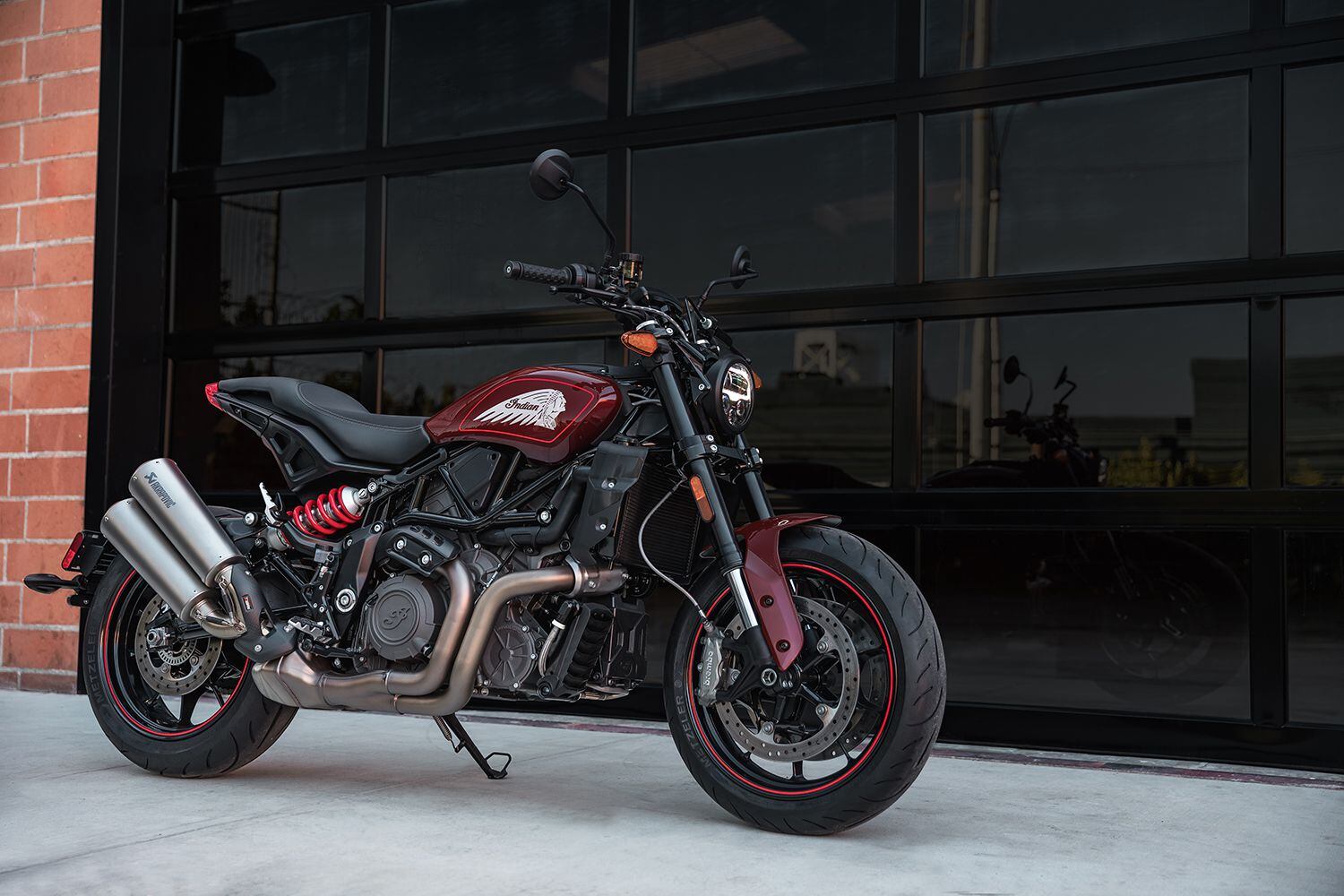
The 2022 FTR S starts at $15,000, seen here in Maroon Metallic. (Indian Motorcycle/)The base-model FTR1200 is now the FTR, with a $500 price decrease that brings the MSRP to $13,000. The FTR S stays at $15,000, while the FTR R Race Replica and Carbon models are now combined into the FTR R Carbon, which remains $17,000.
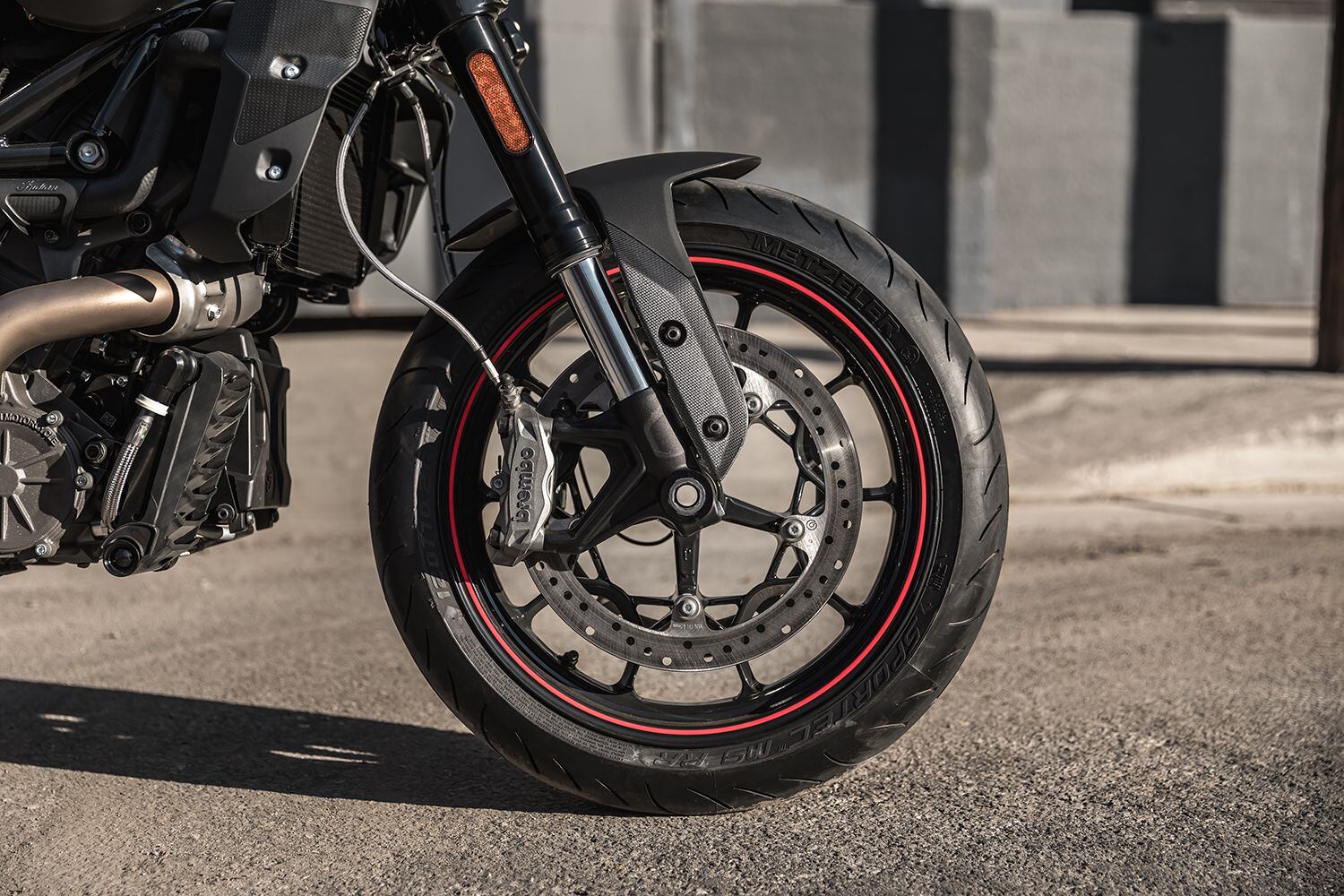
Suspension travel has been reduced by 1.2 inches, lowering the FTR’s center of gravity to improve on-road handling. (Indian Motorcycle/)Previously all FTRs except the Rally came with proprietary Dunlop tires. An 18-inch rear and 19-inch front tire were designed with a tread pattern mimicking the race-only DT3s used on FTR750s. Now the FTR, FTR S, and FTR R Carbon are each fitted with cast-aluminum 17-inch wheels and Metzeler Sportec tires in order to deliver more nimble and precise handling. The Rally will continue to equip Pirelli Scorpion Rally STRs in original 18/19 sizes.
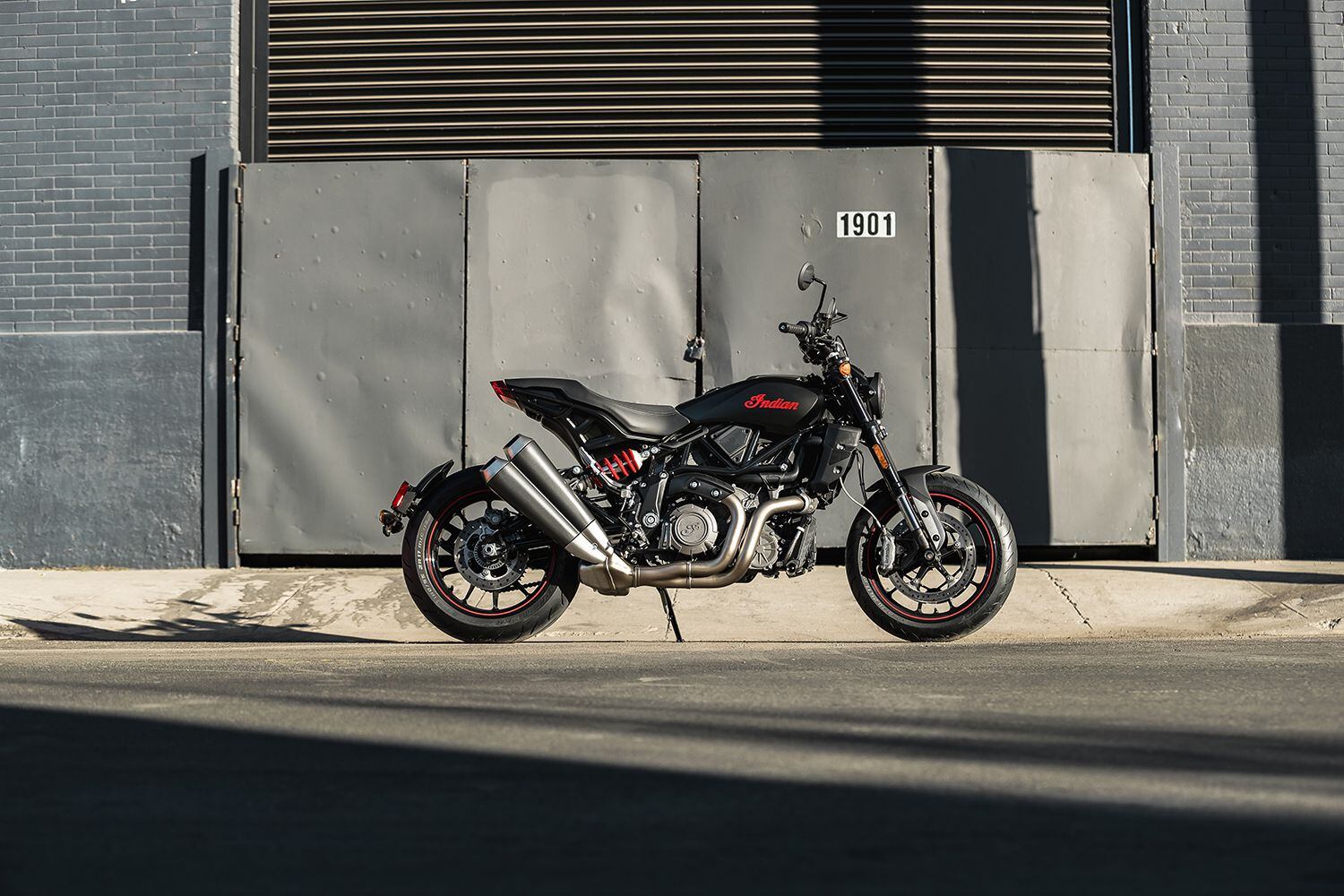
The base-model FTR has a lowered MSRP of $13,000. (Indian Motorcycle/)As in previous models, the 2022 FTR and FTR Rally come with analog gauges rather than the 4.3-inch touchscreen seen on the R Carbon and S models. Wheelie control, stability control, traction control, cornering ABS, and a USB charging port are exclusive to the S and R Carbon models.
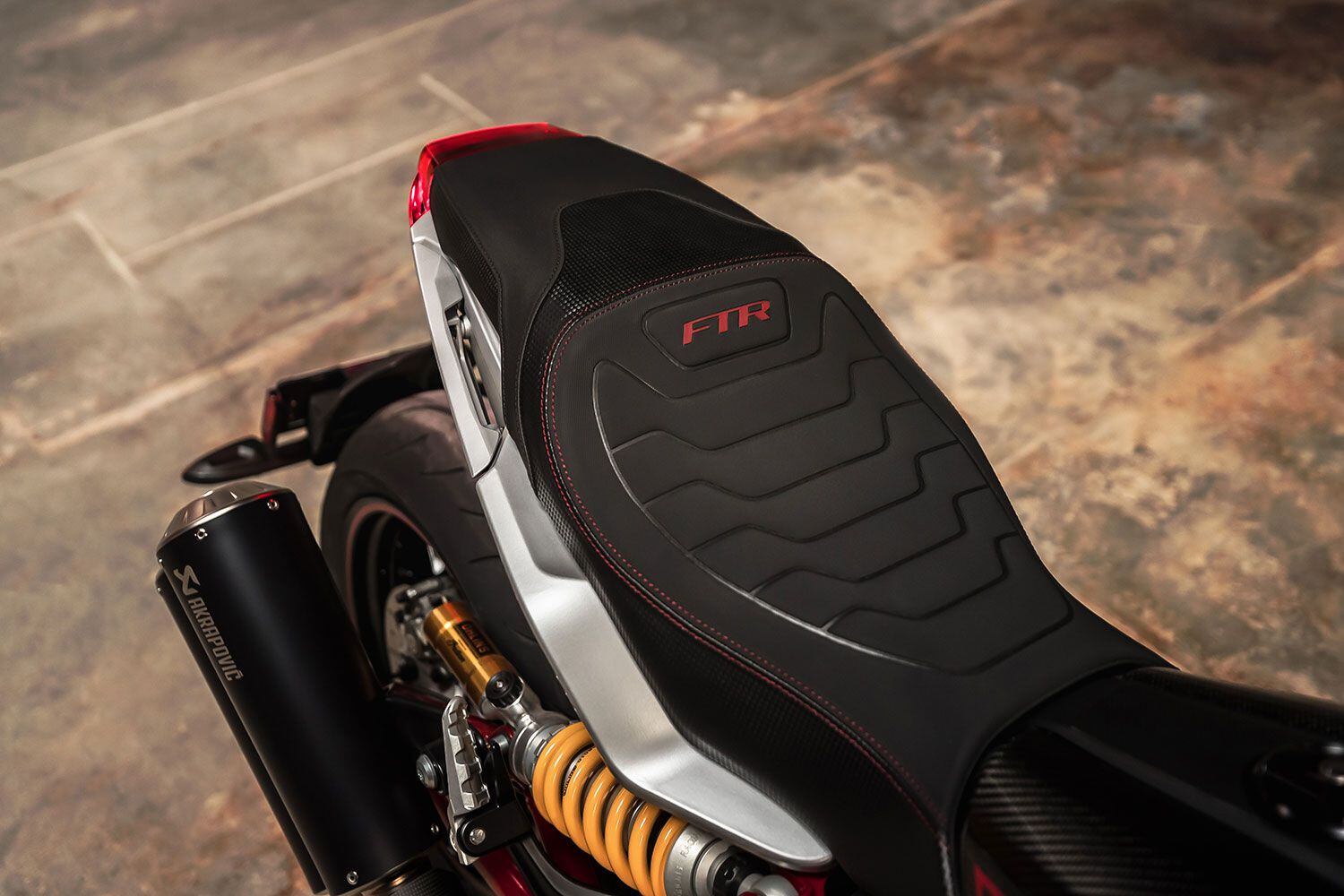
The new sporty seat and raw aluminum tailsection of the top-shelf FTR R Carbon. (Indian Motorcycle/)The FTR, S, and R Carbon models are equipped with fully adjustable suspension, a major upgrade for the base model despite the price decrease. As in previous years, the top-shelf R Carbon comes with fully adjustable Öhlins suspension. We now see a lowered seat height on the FTR, S, and R Carbon models, likely thanks to the new suspension tune, which drops 1.2 inches of travel from the previous 5.9 inches to 4.7 inches on each model. The Rally sees no suspension upgrades and is now the only model with nonadjustable suspension.
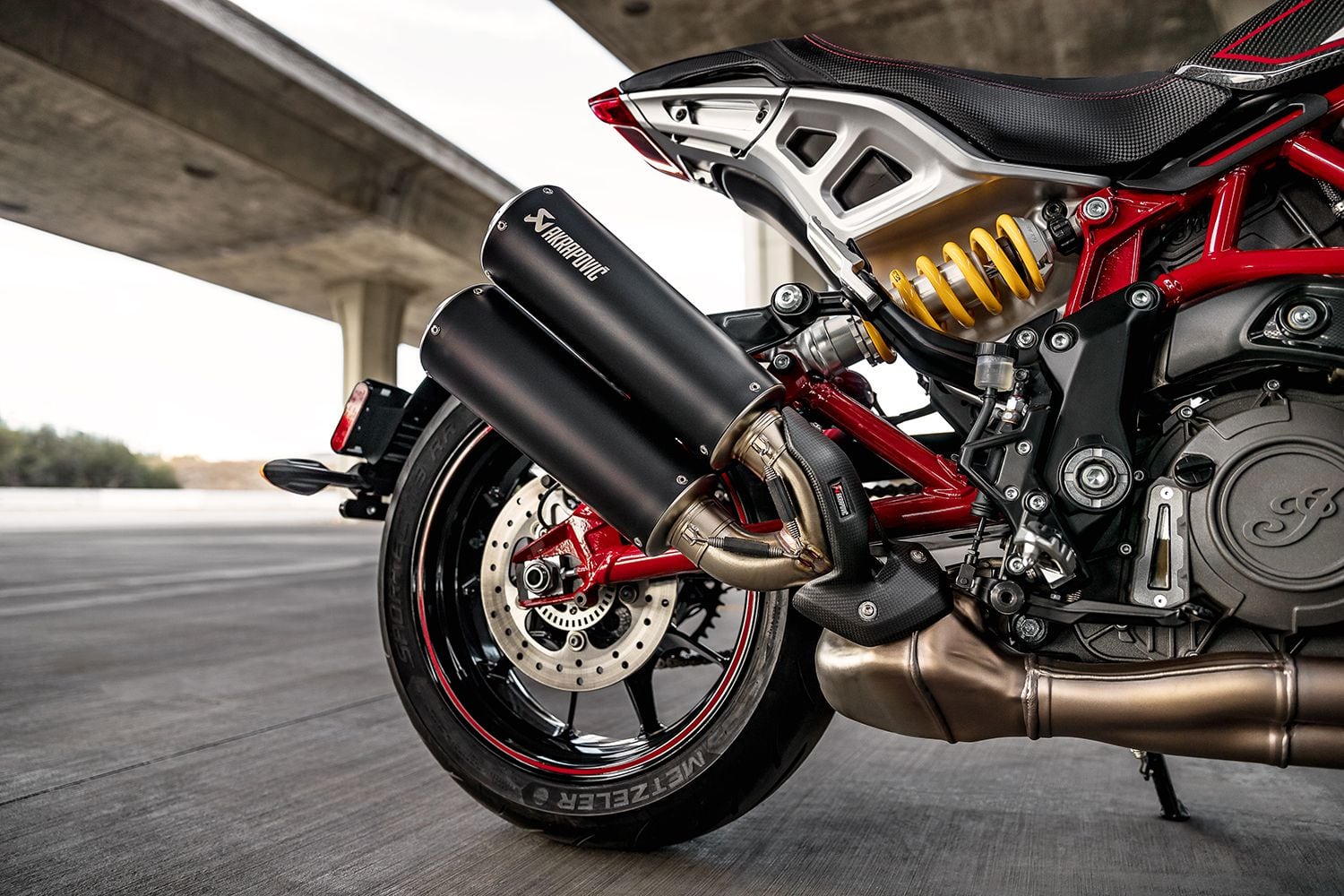
Upgraded Akrapovič exhaust comes standard on the FTR S and FTR R Carbon. (Indian Motorcycle/)Indian says the updated engine tune applied to each model is intended to improve cold-start performance and deliver a smoother, more predictable throttle response. We would have loved to see some improvements in fuel economy, as well as a little less vibration at speed, but we’re happy to see some refinement nonetheless. In an effort to mitigate heat at idle, rear-cylinder deactivation is now standard on every model.
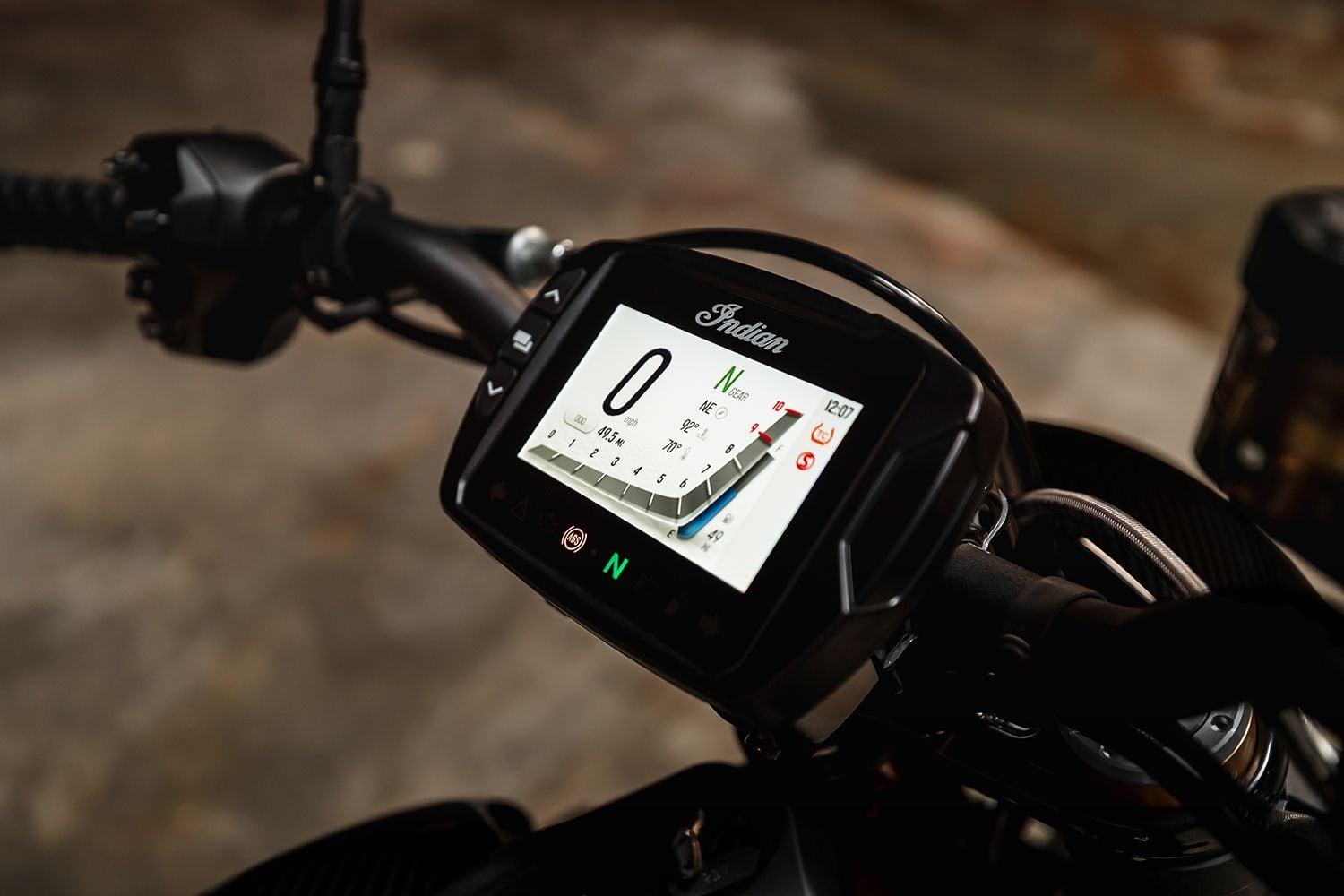
The FTR S and FTR R Carbon each come with a programmable 4.3-inch digital LCD gauge display. (Indian Motorcycle/)In previous years, Indian’s lineup offered FTRs with similar dirt and street capability. Now the company is improving on-road function while keeping the primary scrambler model, the Rally, to add some diversity. As we had hoped, the FTR1200 was just the beginning. We can’t wait to test these newly updated bikes ourselves, so stay tuned for our in-depth review.
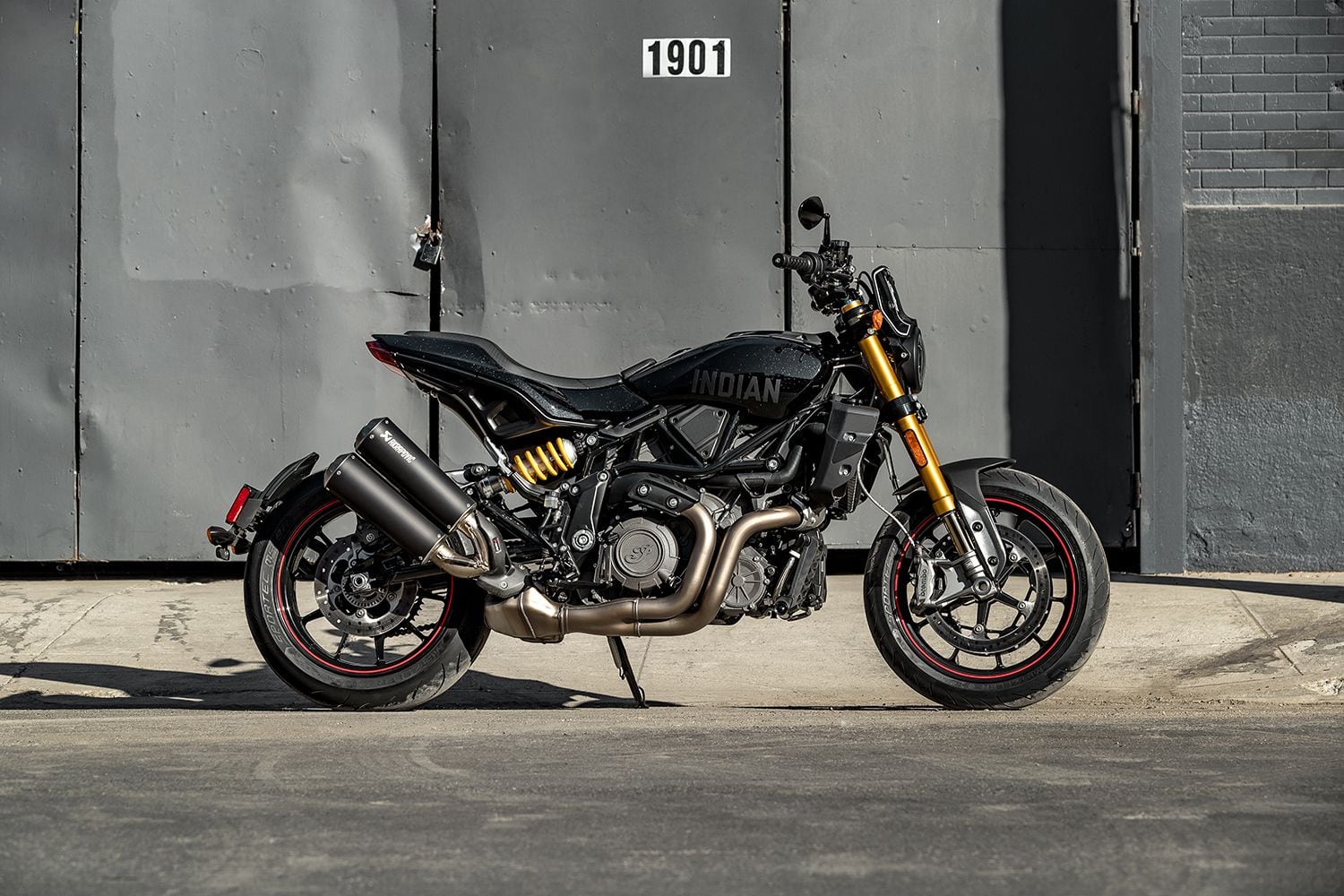
In addition to the updates seen here, Indian is expanding the accessory lineup currently available for FTR models. (Indian Motorcycle/) -
-
Hello Kieran,
Welcome to The Motorbike Forum. Please feel free to browse around and get to know the others. If you have any questions please don't hesitate to ask.
Why not tell us a bit about yourself too.

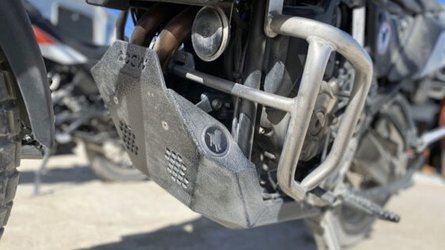
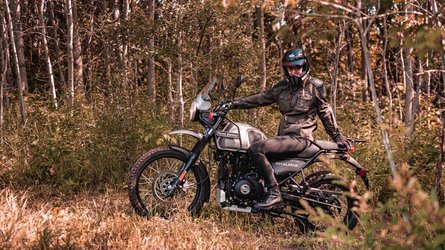
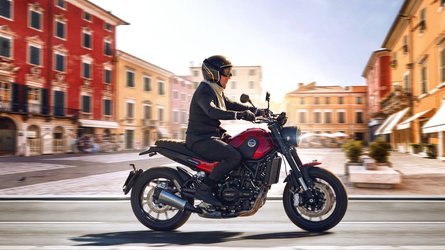
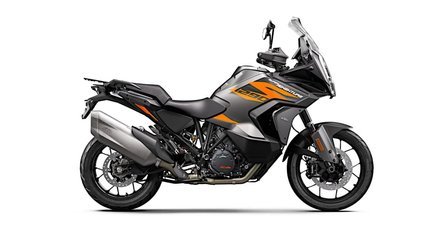
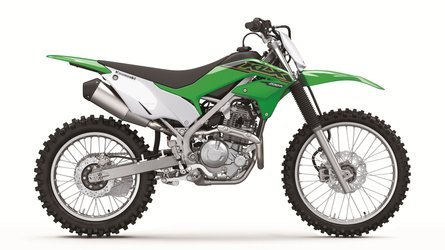
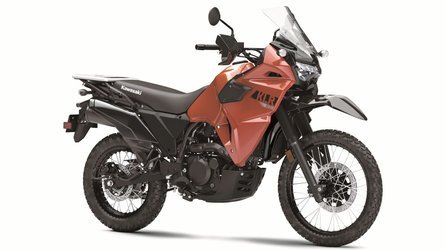
New Small-Displacement KTMs Are on the Way
in Motorbike news
Posted
Spy shots of this revamped KTM RC 125 suggest the firm is working on an RC series overhaul. (S. Baldauf/SB-Medien/)
After focusing on its parallel-twin and V-twin Duke and Adventure models for the last few years, KTM is about to turn its attention to the smaller-capacity single-cylinder RC sportbikes—with complete overhauls coming soon to both the RC 390 and its smaller RC 125 sibling. These pictures show the 125cc model, but the next-generation RCs will share the same styling and chassis for both engine sizes, so the changes seen here here will also apply to the RC 390. The two models have been spotted testing, both in Spain and near KTM’s main Mattighofen factory, with little more than the engine cases and exhaust systems separating them in terms of appearance.
Bodywork on the next-gen models is leaner and the fuel tank is new as well. (S. Baldauf/SB-Medien/)
So what’s new on the next generation of baby KTM? Engine aside, the answer is pretty much everything. Let’s start with the cosmetics—every panel on the next-generation RC models is new, with a leaner, lighter appearance, particularly around the rear. The seat subframe is much more delicate-looking than the hefty design of the existing models. It’s still a steel trellis, but slimmer and topped with minimalist plastic bodywork.
Further forward, the fuel tank is new, with a clear split between its front section and the rear half. It suggests the rear part will house the engine’s airbox while the front, where the filler is located, carries the fuel.
The fronts of the side panels “float” off the main fairing, while the nose now carries clear plastic instead of colored bodywork. (S. Baldauf/SB-Medien/)
On the sides, the bodywork has two distinct layers. The front parts of the side panels appear to “float” a small distance away from the main fairing, suggesting air is channeled between the sections—a system that Aprilia has brought to prominence with the new RS 660 and 2021 RSV4. But the most arresting part of the new RC design is the front, which builds on the already-unconventional ideas seen on the current model by using clear plastic instead of colored bodywork for the whole nose of the bike.
The screen extends down over the headlight and across to each side of the nose, where it covers the position lights and LED turn signals. KTM appears to be keeping its signature, vertically split headlamp, but it’s more subtle here than on other models as the split hides behind that smooth expanse of Plexiglas.
The suspension is from WP, of course, and from these images appears to be one of the few parts of the bike not to have been altered much. The swingarm retains the usual external bracing and seems to be the same casting that’s used on the current model, while the forks also look much like those on the existing RC 125 and RC 390. A single front disc gripped by a radial-mount caliper from Brembo’s low-cost ByBre brand also matches the specs of the 2020 bike.
RELATED: 2017 KTM RC390 Favorites & Fails
On board, there’s a new TFT dash to replace the aging LCD unit used on the current-year RC 390 and RC 125 bikes. It looks like the 5-inch unit that’s already been adopted on other KTMs including the 890 Adventure and the next-gen RC 390′s sister model, the 390 Adventure.
Since testing of the updated RC has been underway for some time already, and late-development components like the headlight and taillight are clearly complete now, it’s likely the bike isn’t too far from production. Chances are it will be launched later this year as a 2022 model.
View the full article